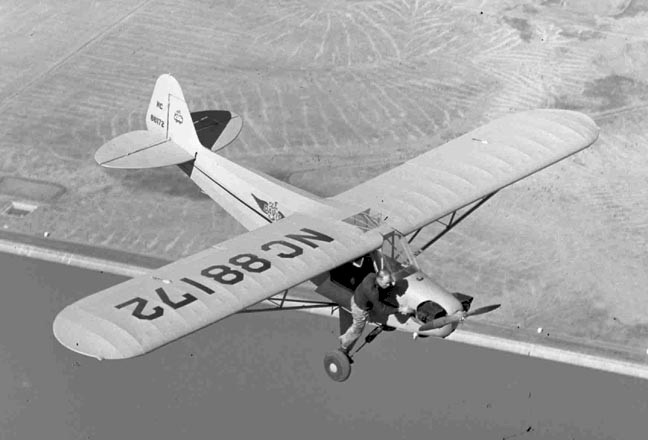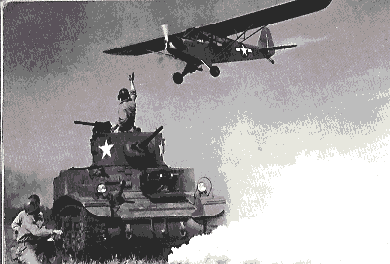 THE GRASSHOPPERS MUST RETURN!
THE GRASSHOPPERS MUST RETURN!
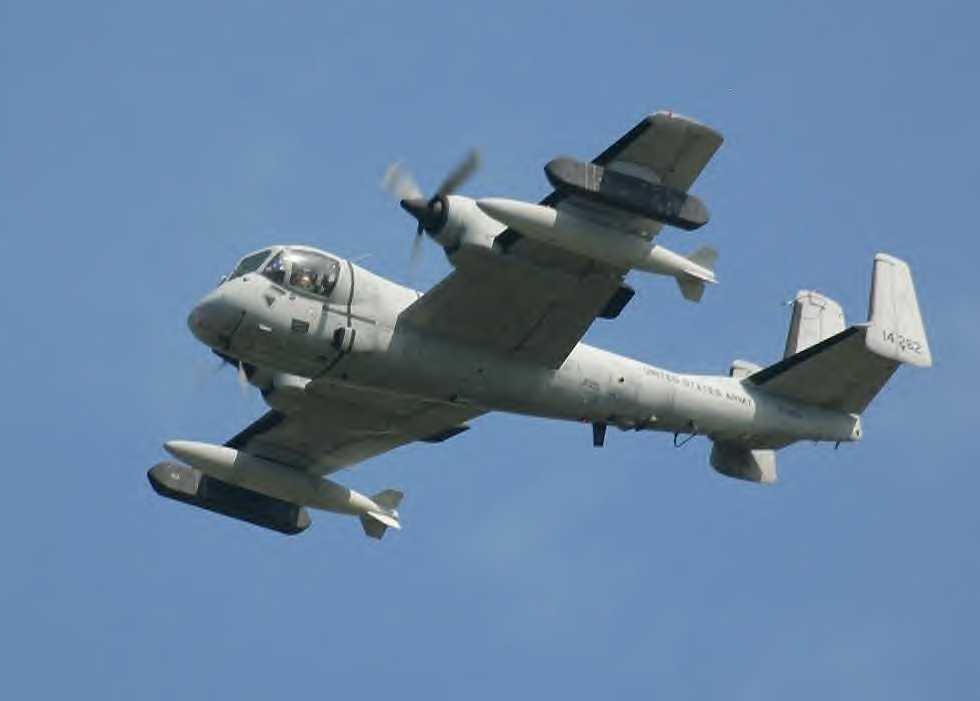
2013: TRAGIC UPDATE: BACK TO THE FAILED STATUS QUO?
 youtube.com/watch?v=mqjdyv3qOs4
youtube.com/watch?v=mqjdyv3qOs4
As predicted, the USAF fighter-pilot egomaniac bureaucracy miss-led by the "Schwartz" screwed over the American Soldier by first LYING that it would fly ALL the C-27J Spartan transports capable of resupply small FOBs so as to get them out of Army aviator hands, then RETIRE all of them--just like they lied and pulled the exact same stunt with the CV-2 Caribou in the 60s/70s. To add more injury to America's force structure, the USAF no longer wants to fly the C-12s that were modified to act as battlefield sensor platforms....Guess what?
We ain't finished yet with USAF bureaucratic treason.
The Light Attack Armed Recon 2-seat turboprop plane may or not go forward to outfit our allies overseas...the USAF HATES anything that isn't a sexy supersonic jet fight-bomber...they lust to fly these--and no other type planes; their budget is in such a shambles by their narcissism that they are not even buying enough planes to replace what they are crashing. If there ever was a time to break-off the attack and transport aviation missions from the centralized USAF bureaucracy and give it to an Army Air Force or Army Air Corps---now is the time. Their BS 1943 North Africa hysterical mentality and the disastrous 1947 National Security Act that gave birth to them and the abominable bloated, selfish, non-teamwork USMC bureaucracies has been a drain on the American taxpayers and a millstone of military failures around our neck ever since. ALL A-10 Warthogs, C-27Js and MC-12s should be sent to the Army from the USAF aviomaniacs by direct order of the U.S. Congress.
It behooves the U.S. Army to grow a pair of balls and DEMAND from Congress it has its own fixed-wing observation/attack aircraft beginning by arming its RC-12s with a belly-mounted 30mm cannon and wingtip-mounted missiles. The nation's biggest armed service? The Army damn well better start acting like it.
What About Pilatus STOL Grasshoppers?: Gavin's PENTOMIC ARMY: DIY Air Recon, Resupply, MEDEVAC & Strike
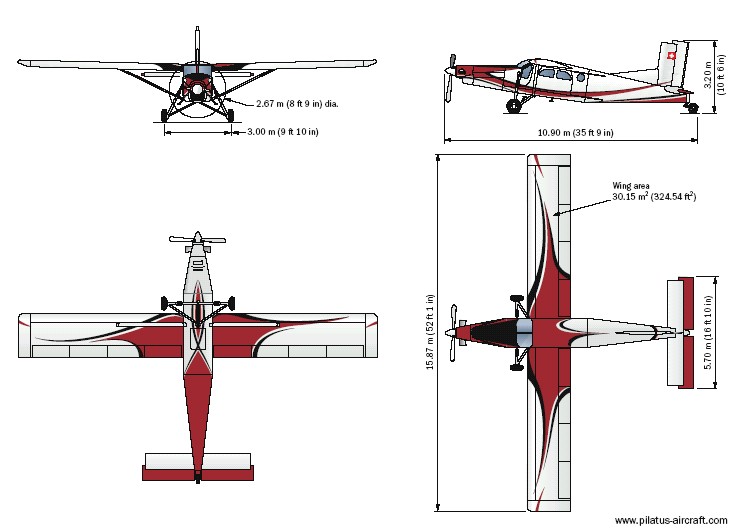
youtube.com/watch?v=_yrPBt-weqQ
Use Tweels instead of Fragile, Air-Filled Tires...
youtube.com/watch?v=2wAvxQfusWU
At the height of LTG Gavin's influence, the U.S. Army's aviation platforms were becoming more powerful with turbine engines and they offered a far greater variety of capabilities than today's expensive and budget-draining, helicopter-centric Army mislead by Army Aviation Branch bureaucracy that he never wanted to exist as a "them" against "us". The U.S. Army could actually sustain itself with its own aviation platforms as intended because the aircrew belonged to the career fields of the rest of the Army. Aviation belonged to everyone in the Army. No favorites were played and our Army had mighty Short Take-Off and Landing (STOL) fixed-wing "grasshoppers" that could land anywhere--as well as parachute drop supplies to units anywhere on the battlefield and Special Forces personnel for recon, pathfinding and direct action missions. Had Army aviation not been corrupted by the helicopter mafia, the turboprop Pilatus PC-6 TurboPorter would have replaced the piston-engined Beavers, Otters, Bird Dogs and enabled DIY self-sufficiency capabilities for Army units on non-linear battlefields--just like the CIA's Air America used them with legendary effect in South East Asia. You may recall the TurboPorter grabbing all the attention in the Mel Gibson, Robert Downey movie "Air America" by landing on the tops of mountains or the stunning opening sequence diving down the side of a mountain in Pearce Brosnan's first James Bond 007 movie, "Goldeneye".
The Army did own and operate 2 TurboPorters; U.S. Army designation: UV-20 Chiricahua. It's high time the Army obtain UV-20s in large quantities again to spot for field artillery fires as well as facilitate SF, Ranger, Pathfinder and small Forward Operating Base (FOB) resupply means. The UV-20s would be modified to have Grumman F6 Hellcat-style wing folding so they can fit inside an ISO shipping container "BATTLEBOXturboporter" so they are sea, air and ground mobile. For safety, a ballistic recovery parachute would be fitted so if the engine conks out, neither aircraft nor Soldiers are lost.
The ideal mission profile of these "Attack/Utility" aircraft would be to first find the enemy by inserting/extracting recon teams by parachute and STOL airlanding as well as air surveillance using surveillance sensor pods. Instead of UAVs with a 50% crash rate, manned UV-20s with a sensor operator/gunner in back can ascertain where the enemies are hiding and immediately attack them with 30mm autocannon under the belly or out the side door--as well as underwing rockets, missiles and gun pods. If this doesn't work, then spotting for field artillery fires would be tried. If maneuver forces are needed, they can fly by C-27J/CH-47F/C-130s with M113A4 or A5 full-size or Mini-Gavin light tanks inside to be parachute dropped or airlanded. The ideal would be the maneuver force flying itself by their own aero propulsion units instead of having to "mother may I?" from an aviator bureaucracy. That's right, AeroGavins aka FLYING TANKS. UV-20s could escort the AeroGavins, CH-47Fs or fly ahead of the faster C-27Js/C-130Js bringing the maneuver elements in and scour the drop and landing zones of thermal signatures of possible enemies to suppress them with their own or directed fires from Army artillery or sister service attack aircraft.
Need Faster Grasshoppers? Fast FACs
youtube.com/watch?v=MQRjODx9dr8
Watch these videos and note the capabilities America's Army has lost-and needs to regain.
The 300+ mph PC-12 might be a good candidate for a faster Army grasshopper that can also do Airborne Forward Air Control (FAC) duties so the USAF's too-fast fighter-bombers can be directed to hit actual combatants and not murder civilians. In USAF service now, they are called U-28s. Imagine either PC-6 or PC-12s armed with 30mm autonannon on a revolving belly turret so they don't have to do diving attacks, and wing hard points for bombs, rockets and missiles...
af.mil/information/factsheets/factsheet.asp?id=19315
U-28A
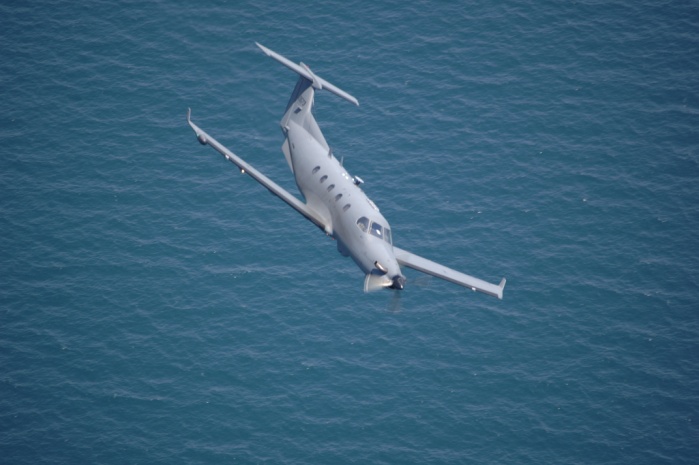
Posted 3/15/2012 Printable Fact Sheet
The U-28A provides a manned fixed wing, on-call/surge capability for Improved Tactical Airborne Intelligence, Surveillance, and Reconnaissance (ISR) in support of Special Operations Forces.
Background
The rapidly changing and diverse Special Operations Command mission requirements generated a need for small numbers of mission specific aircraft which were procured rapidly to address specific mission needs. The Non-Standard Aircraft (NSAv) fleet is a general program term and encompasses several light and medium aircraft performing utility missions for SOCOM. Overall the NSAv mobility fleet untethers special operations forces from robust infrastructures, extended timelines and allows freedom of movement.
The U-28A is part of AFSOC's NSAv fleet, and is operated by the 319th and 34th Special Operations Squadrons, training is conducted by the 5th and 19th SOS; all squadrons are located at Hurlburt Field, FL.
Mission
The U-28A provides a manned fixed wing, on-call/surge capability for Improved Tactical Airborne Intelligence, Surveillance, and Reconnaissance in support of Special Operations Forces.
The U-28A is a modified, single-engine Pilatus PC-12 that operates worldwide. The initial block of U-28 aircraft were procured and modified for use in Operations Enduring Freedom and Iraqi Freedom. The U-28A fleet evolved from commercially available aircraft that were purchased and then modified with communications gear, aircraft survivability equipment, electro-optical sensors, and advanced navigation systems. The advanced radio-communications suite is capable of establishing DoD/NATO data-links, full-motion video, data, and voice communications. The U-28A has outstanding reliability and performance, and is certified to operate from short and semi-prepared airfields.
All U-28A aircraft are maintained through contractor logistics support.
General Characteristics

Crew: 2 Pilots, 1 Combat Systems Officer
Builder: Pilatus Aircraft Ltd
Power Plant: Pratt-Whitney PT6A-67B
Thrust: 1,200 SHP
Wingspan: 53' 3" (16.23 m)
Length: 47' 3" (14.4 m)
Height: 14' (4.25 m)
Speed: 270 KTAS
Range: 1,500 NM
Ceiling: 29,000 MSL
Maximum Take-off Weight: 10,935 lbs
Deployment Date: 2006
Unit Cost: $16.5M
Inventory: Active duty, 21
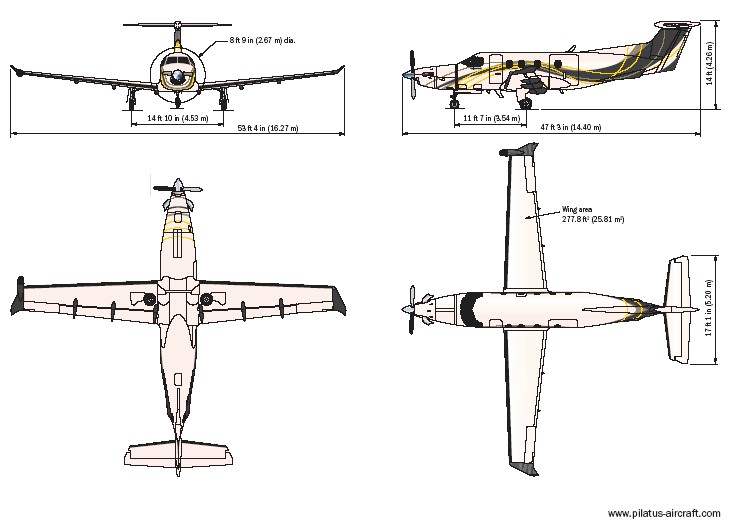
PC-12 (U-28) UTILITY DROP & JUMP OPERATIONS
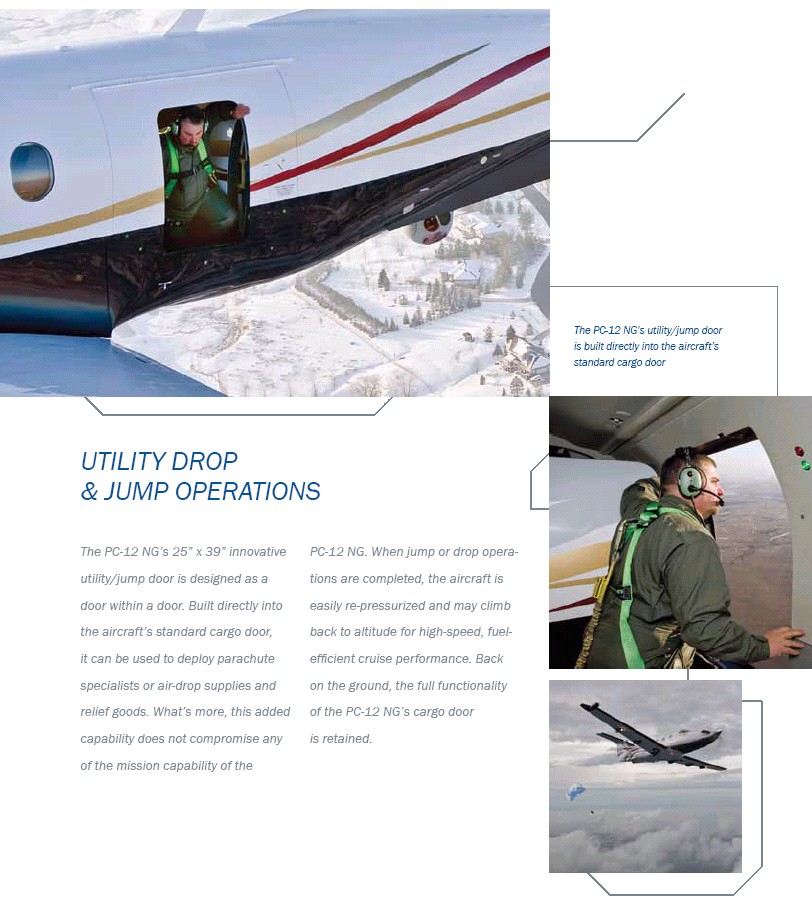
The PC-12 NG's 25" x 39" innovative utility/jump door is designed as a door within a door. Built directly into the aircraft's standard cargo door, it can be used to deploy parachute specialists or air-drop supplies and relief goods. What's more, this added capability does not compromise any of the mission capability of the PC-12 NG. When jump or drop operations are completed, the aircraft is easily re-pressurized and may climb back to altitude for high-speed, fuelefficient cruise performance. Back on the ground, the full functionality of the PC-12 NG's cargo door is retained.
Manned U-28s in Action over Mali: Note the BS UAVs can't even Find the Rebels in Dry, Open Terrain Once they Learn to Hide!
wired.com/dangerroom/2013/01/mali-air-war/
Mali Militants Shift Up Tactics As France's War Coalition GrowsReplace our Too-Slow OH-58D Kiowa Warrior helicopters with Faster 300+ MPH Observation/Attack Planes?By David Axe
01.26.13
2:07 PM
Updated, 7:10 p.m.Mali's rebels are adapting to attacks from above as the 15-day-old air war over West Africa gets a lot more intense. After Paris' air force last week blasted the militants' exposed vehicles and headquarters buildings (depicted in the targeting system video above), the survivors of the initial bombing runs learned to camouflage themselves.
"The rebels will quickly adapt their tactics to better conceal themselves and thus complicate targeting from the air," Christopher Chivvis, an analyst with the California-based think thank RAND, said on Thursday.
More complicated targeting is forcing the French-led coalition to add spy planes to its order of battle. "There's still more need for [intelligence, surveillance and reconnaissance] platforms," David Cenciotti, a highly-regarded aviation journalist, tells Danger Room. "You must detect and follow rebels as they move, then you can order, coordinate and manage air strikes."
"It's tough to get access for platforms that can collect," warned Army Gen. Carter Ham, in charge of U.S. Africa Command. But that doesn't mean the French and others won't try.
The aerial escalation has driven the expansion of the French-led coalition from just a handful of countries to more than a dozen. Nigerian and British combat planes and airlifters from several European and Middle Eastern states have joined the French aerial armada hunting militants in northern Mali. There have also been unconfirmed rumors of greater American involvement in the airborne onslaught.
In the first phase of the air war starting Jan. 11, French Gazelle and Tiger helicopters and Mirage 2000 and Rafale fighter-bombers based in Mali, Chad and France pounded rebel ground forces, supply lines and command infrastructure, while two French Harfang drones spotted targets. French KC-135 tankers refueled the fighters as French, British, Canadian, Belgian and Danish and chartered Ukrainian cargo planes hauled reinforcements, armored vehicles and supplies into Bamako, Mali's capital.
The more intensive second phase of the aerial campaign around a week later saw the U.S. offer up C-17 transports. The Nigerians added transports, Hind helicopter gunships and a pair of Alpha Jet light bombers. Italy, Germany, Spain, The Netherlands and the UAE joined the airlift effort and Italy sent a KC-767 tanker to boost the French KC-135s.
But the most striking additions were the spy planes, demand for which is apparently increasing fast. The French deployed to Senegal five Atlantique II naval patrol planes, which are optimized for hunting ships and subs but can also use their video cameras to spot land targets. And the British Royal Air Force has committed one of its five Sentinels, business jets fitted with powerful underslung radars for simultaneously tracking scores of ground targets. "It could provide French forces with data relating to the rebels' movements," Cenciotti explains.
The Sentinel could be just the beginning for the RAF in Mali. U.K. Defense Secretary Phillip Hammond said London "would be looking at further French requests for additional logistical and surveillance support."
The details of America's participation in the Mali air war are less clear, although Washington has expressed its determination to help in some capacity. "We are in for a struggle, but it is a necessary struggle," Secretary of State Hillary Clinton said Wednesday. "We cannot permit northern Mali to become a safe haven."
But the Pentagon has copped only to sending five C-17s. But there have been rumors of U.S. drones and other surveillance and strike aircraft in the region. "MQ-1 [Predator] and RQ-4 [Global Hawk drones] can be heard two or three days a weak crossing the Maltese airspace towards North Africa using LiveATC.net," a Website that picks up air traffic control radio broadcasts, says Cenciotti. The robots could be Mali-bound.
Moreover, an air strike in northern Mali in June might have been a Predator's handiwork. And according to The Washington Post, U.S. Special Operations Command has based PC-12 manned spy planes (also known as U-28s) in Burkina Faso for patrols over West Africa, possibly including Mali.
Late Saturday, the Pentagon told reporters that Defense Secretary Leon Panetta committed to conducting midair refueling missions for French jets, something the French have sought from the U.S. since their war began. The U.S. will also transport African troops, particularly those from Togo and Chad, to the battle. It's another gradual escalation of the U.S. contribution to its ally's "aggressive operations against terrorist networks in Mali," as Panetta's spokesman, George Little, put it.
With or without the Americans, the growing number of warplanes supporting the French-led ground war points to a more intensive, potentially bloodier intervention. If America's own wars across Africa, the Middle East and Central Asia are any indication, it's a lot easier to increase a military commitment than to decrease one. That could point to a drawn-out campaign for France and its allies.
slideshare.net/1st_TSG_Airborne/battle-damaged-oh58d-kiowa-warrior
slideshare.net/1st_TSG_Airborne/58-d-replacement1
BUILD-A-MODEL:
squadron.com/product-p/rd0443.htm
1:48 Roden Pilatus PC-6B-2/H-2 Turbo Porter - RD0443
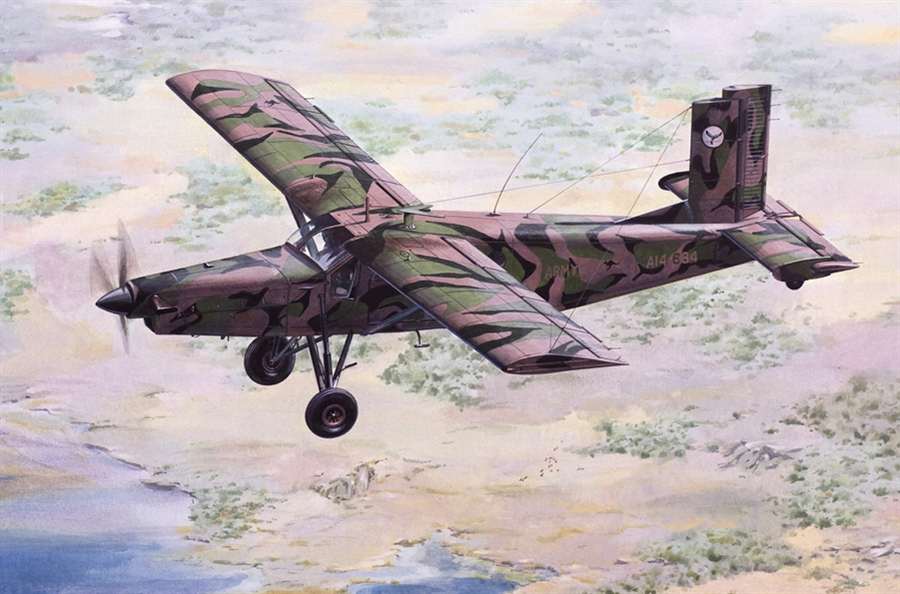
List Price: $52.99
Our Price: $39.74Stock Status:In Stock
Product Code: RD0443Swiss STOL turboprop utility aircraft, a further development of the well-known light multi-purpose PC-6B powered by a 680 hp Pratt & Whitney Canada PT6A-27 engine (U.S. military designation UV-20A Chiricahua for Fairchild license built examples). Kit features engraved panel lines, well detailed cockpit and cabin interior, optional position cockpit and cabin doors, separate control surfaces, fine exterior detail (including control actuators and an array of antennae), new tool engine cowling and spinner, plus injection-molded clear parts. Decals and painting reference for 5 aircraft: U.S. Army UV-20A s/n 79-23253 of Army Group West Europe, Tempelhof, Germany, 1980; U.S. Army UV-20A s/n 79-23254 with the Golden Knights Parachute Team, PA, 2009; Argentinean Armada G-2/0686 with shark mouth, mid 1980s; Royal Australian Air Force A14-690 of No 161 (Independent) Recce Flight, Vietnam, 1969 and Royal Australian Air Force A14-684 of No 173 (General Support) Squadron, New South Wales, 1968 - includes instrument panel markings, full fuselage trim and instrument panel markings.
Watch James Bond Fly the Turbo Porter into Combat Against the Illuminati in "Masquerade: Everything is Not What it Appears"
2009: GOOD NEWS!
Secretary of Defense Gates Fires USAF Secretary and Chief of Staff for the Pathetic 25 at most Predator UAVs that can be in the air over Iraq/Afghanistan...
We used to have over 300+ x O-1 Bird Dogs with human "sensors" in the air over Vietnam at one time....UAVs cannot fly well en masse in circles without fears of collisions and losing control....yet again RMA is a bust...Its all back to 1943 North Africa.....the USAF wants to control ALL air operations when that means in a pyramidal bureaucracy something is going to be at the BOTTOM in priorities...guess which it is?The proper response to 1943 is to keep an Army Air Force for ground maneuver support and create another Air Force to fight other air forces.
youtube.com/watch?v=8MKQnqOuW10
We used to have over 300+ x O-1 Bird Dogs that could scour Vietnam's skies...plus OV-1 Mohawks with electronic sensors...next "revelation" will be that we can't get this many UAVs into the air without collisions and control loss crashes....PROGRESS!
U.S. Army Fed up not Having Maneuver Air Support (MAS)
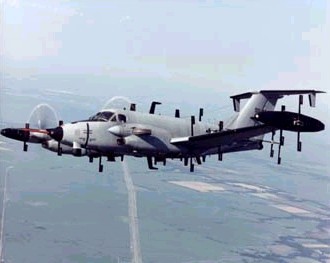
youtube.com/watch?v=tGKqSslEDIM
slideshare.net/1st_TSG_Airborne/mohawk-maneuver-air-support-mas-v40
MILVAMP Killer Bee "U/MCAV" the U.S. Army Needs Today!
youtube.com/watch?v=GyO14gRRzU4
The ruins of a mosque in Baghdad after an airstrike by the United States. The Army is beginning its own air operations.By THOM SHANKER
Published: June 22, 2008
WASHINGTONEver since the Army lost its warplanes to a newly independent Air Force after World War II, Soldiers have depended on the sister service for help from the sky, from bombing and strafing to transport and surveillance.
But the wars in Iraq and Afghanistan have frayed the relationship, with Army officers making increasingly vocal complaints that the Air Force is not pulling its weight.
In Afghanistan, Army officers have complained about bombing missions gone awry that have killed innocent civilians. In Iraq, Army officers say the Air Force has often been out of touch, fulfilling only half of their requests for the sophisticated surveillance aircraft that ground commanders say are needed to find roadside bombs and track down insurgents.
The Air Force responds that it has only a limited number of those remotely piloted Predators and other advanced surveillance aircraft, so priorities for assigning them must be set by senior commanders at the headquarters in Baghdad working with counterparts at the Air Force's regional command in Qatar. There are more than 14,000 airmen performing tasks on the ground in Iraq and Afghanistan, including Air Force civil engineers replacing Army construction engineers.
But now in Iraq, the Army has quietly decided to try going it alone for the important surveillance mission, organizing an all-Army surveillance unit that represents a new move by the service toward self-sufficiency, and away from joint operations.
Senior aides to Defense Secretary Robert M. Gates say that he has shown keen interest in the Army initiative much to the frustration of embattled Air Force leaders as a potential way to improve battlefield surveillance.
The work of the new aviation battalion was initially kept secret, but Army officials involved in its planning say it has been exceptionally active, using remotely piloted surveillance aircraft to call in Apache helicopter strikes with missiles and heavy machine gun fire that have killed more than 3,000 adversaries in the last year and led to the capture of almost 150 insurgent leaders.
The Army aviation task force became fully operational last July with headquarters at Camp Speicher, in the north-central city of Tikrit, and focuses its efforts on insurgents planting roadside bombs. But it also has located and attacked insurgents in battles with American and Iraqi troops, and has supported missions of the top-secret Special Operations units assigned to capture or kill the most high-value targets in Iraq.
The battalion is called Task Force Odin the name is that of the chief god of Norse mythology, but it also is an acronym for observe, detect, identify and neutralize. The task force of about 300 people and 25 aircraft is a Rube Goldberg collection of surveillance and communications and attack systems, a mash-up of manned and remotely piloted vehicles, commercial aircraft with high-tech infrared sensors strapped to the fuselage, along with attack helicopters and infantry.
The Army cobbled together small civilian aircraft, including the Beech C-12, and placed advanced reconnaissance sensors on board. Also assigned to the task force are small, medium and larger remotely piloted Army surveillance vehicles, including the Warrior and Shadow, with infrared cameras for night operations and full-motion video cameras.
All are linked by radio to Apache attack helicopters, with Hellfire missiles and 30-millimeter guns, and to infantry units in armored vehicles.
Civilian casualties are always a risk in air raids, particularly those attacking bomb-placing teams that operate in cities and villages. Army officials declined to say whether they believed the casualties from the new Army raids included innocent civilians, but they sought to pre-empt some criticism by screening an aerial surveillance video that they said showed the precise nature of the raids.
The video showed an insurgent who had escaped attack and hid in a courtyard a few feet from a grazing mule. It then showed Apache helicopter fire killing the insurgent, while the mule was left grazing beside the corpse.
In contrast to Predators, which are assigned by the top headquarters for missions all across Iraq, Task Force Odin is on call for commanders at the level of brigade and below, an effort by the Army to be responsive to the needs of smaller combat units in direct contact with adversaries and a clear sign of rivaling concepts [de-centralized air power] with the [centralized, selfish bureaucratic] Air Force.
Task Force Odin was created on orders of Gen. Richard A. Cody, the Army's outgoing vice chief of staff, as a way to improve the detection of roadside bombs before they explode, and to strike more adversaries more safely, from a distance. Thus far, not a single helicopter or piloted surveillance airplane has been lost in the unit's missions.
"Task Force Odin provides a current example in Iraq that reveals how reconnaissance, surveillance and target acquisition improves survivability," General Cody said in a statement.
Geoff Morrell, the Pentagon press secretary, said Mr. Gates "wants to make sure that we are looking at not just top-down solutions, but ground-up solutions. We need to pay attention to anything that works."
Strains between the services have surfaced in the years since the military undertook the two wars in Afghanistan and Iraq.
Army and marine corps officers in Afghanistan have complained that Air Force pilots flying attack missions in support of ground operations do not come in as low as their Navy and marine counterparts. Instances of civilian casualties from bombing and missile attacks have increased tensions among local populations, which have to be eased by ground commanders, adding to their burden of winning hearts and minds in the counterinsurgency efforts.
"We are supporting the Army as best we can," Michael W. Wynne, the departing Air Force secretary, said Friday. He said that as the Army and marine Corps increased ground forces in Iraq as part of the so-called troop surge over the past year, the Air Force quadrupled its number of sorties and increased its bombing tenfold. The number of surveillance flights by Predators and the larger Reaper vehicles over Iraq and Afghanistan has doubled since January of 2007.
Army officers who are promoting the new concept have shown senior Pentagon officials classified video clips intended to advertise the service's increasing go-it-alone ability. One clip from a remotely piloted vehicle shows an insurgent using palm fronds to smooth dirt over a bomb he had buried late at night along a major convoy route. Moments later, he disappeared in 30-millimeter fire from an Apache that was alerted by the remotely piloted Army surveillance craft overhead.
The Army is asking for money to create a similar unit in Afghanistan within the next six months.
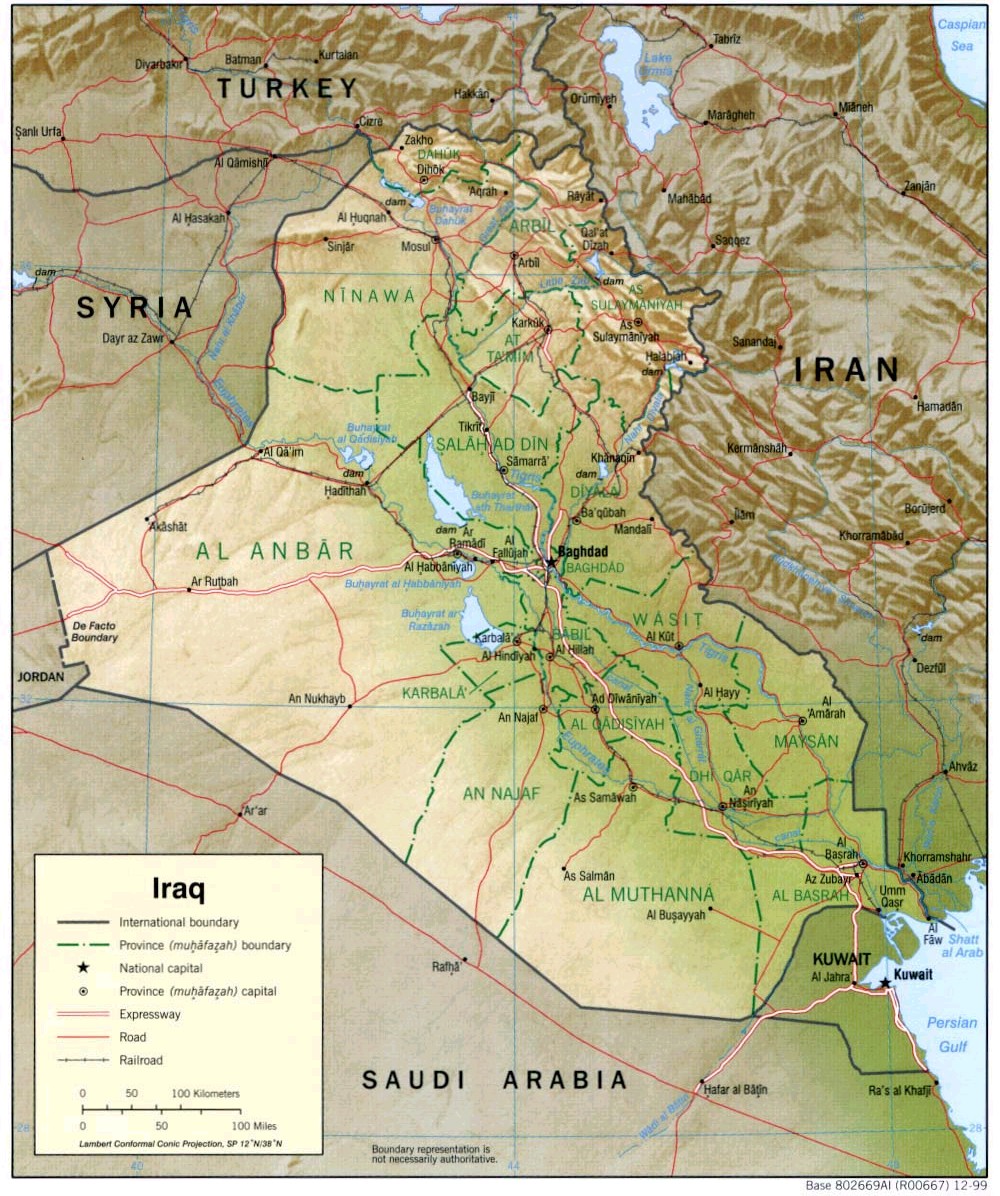
25 x UAVs? That's it? Iraq is the size of Texas. Afghanistan is even bigger.
No wonder we cannot stop land mines from being laid...there's no continuous air surveillance pressure!
NY TimesUSAF Forming Counter-Insurgency Wing with Observation/Attack Aircraft
June 5, 2008U.S. Pushes to Rely More on Remotely Piloted Craft
By THOM SHANKER
WASHINGTON - Early last year, the Air Force was able to keep no more than 11 of the remotely piloted, armed Predator surveillance aircraft flying over Iraq and Afghanistan at any one time.
By this past Sunday, that number had more than doubled to 25, and Air Force officials now say they can guarantee at least that many of the hunter-killer aircraft will be aloft around the clock, a new element of the buildup in American forces for the two wars.
The push to increase missions by the Predator, and its larger and more deadly variant, the Reaper, has been an issue of serious contention between Defense Secretary Robert M. Gates and the armed services, in particular the Air Force.
Mr. Gates has complained that it has been "like pulling teeth" to get more intelligence, surveillance and reconnaissance vehicles into the war zones. He sensed a lack of support for this new generation of unmanned - and therefore unglamorous - aircraft.
But as American commanders look to draw down forces in Iraq, the larger numbers of these aircraft, which can circle for hours over targets, promise to decrease the risk to ground troops, and increase the prospects of successfully tracking terrorist and insurgent leaders. Even as the troop buildup in Iraq ends in July, the demand for greater hours of surveillance coverage will only continue to grow.
"The real challenge the Air Force faces within the Pentagon in providing reconnaissance is that there is a revolution of rising expectations," said Loren B. Thompson, a military affairs specialist with the Lexington Institute, a policy research organization. "It keeps adding new reconnaissance systems, but expectations for performance are rising much faster than the number of systems."
Senior members of a task force created by Mr. Gates to accelerate the deployment of intelligence, surveillance and reconnaissance vehicles to the war zones were meeting this week to discuss fresh proposals. Quick fixes under consideration include outfitting small civilian airplanes with sensor packages; another proposal would delay by several months the opening of a second school for Predator operators so the trainers and aircraft could instead be committed to combat.
A call has gone out to the private sector to expand production of the entire arsenal of remotely piloted vehicles, even as the Air Force plans to end purchases of Predators and instead devote its resources to the Reaper, which flies higher and faster and carries advanced sensors as well as more bombs. Reapers are flying in Afghanistan, and are expected to be introduced to Iraq by fall.
In an effort to provide detailed surveillance images to troops in contact with adversaries, more than 3,500 hand-held devices, called Rovers, have been distributed to ground combat units that allow them to view high-quality images from the surveillance vehicles that previously were available only at headquarters.
But even with these indications of progress, a number of significant hurdles remain to expanding surveillance in the war zones - and each problem reveals the continuing clash of cultures across the military and within the Pentagon.
Air Force officials say their branch of the armed forces should be made the sole authority to manage acquisition of the largest and most deadly class of remotely piloted surveillance and attack aircraft to reduce duplication and produce savings in operations and maintenance.
But the Navy, in particular, counters that it has unique requirements for operating remotely piloted aircraft on the high seas and along coastlines. Thus far, senior Pentagon civilians have not approved the Air Force proposal. And the services continue to argue over who should fly these missions.
The Army and marine corps argue that their young, video-savvy enlisted personnel are wholly capable of working the joystick for these remote-control missions, and the services are rushing to field a number of smaller surveillance craft operated directly by combat units.
But the Air Force has pressed to allow only rated pilots to operate larger vehicles that can travel across a theater of combat, arguing that even though Predator pilots sit in the safety of control booths back in the United States, the task of maneuvering bomb-laden aircraft through complex airspace requires the seasoned judgment of trained aviators.
The Air Force's advanced, piloted fighters and bombers carry sophisticated sensors, and could join the surveillance mix.
But troops in combat do not always grasp the variety of aircraft that can bring them information. Air Force planners say video and other surveillance can be delivered efficiently from many types of aircraft, not just the popular Predator.
"Everybody wants full-motion video because of what I call the 'persistent stare,' that allows everyone to analyze, to determine positive identification or points of origin, and be able to track," said Lt. Gen. Gary L. North, commander of American and coalition air forces across the Middle East. Those capabilities, he said, mean that the United States and its allies could undertake more precise attacks, with fewer unintended casualties, against targets who might not even know a Predator is overhead.
General North said that in recent months, the Predator had been used with great success in military operations in Iraq, from Basra to Sadr City to Mosul. Air Force officials said that in both war zones between March 1 and June 2 of this year, the Predators launched 64 strikes and the Reapers 32.
The debate over how to expand battlefield surveillance prompts Air Force officials to defend against assertions that the service is letting its historic romance with white-scarf pilots detract from the defense secretary's priority of increasing surveillance over the battlefield.
They point to the fact that the Air Force expanded the job of its three-star deputy chief of staff for intelligence to specifically make that office the service's advocate for surveillance and reconnaissance vehicles as well.
And just this week, Air Force officials were putting the finishing touches on a new strategy that seeks to lay out the roles of all future combat and information-gathering aircraft with the view that "every sensor is a shooter, and ever shooter is a sensor."
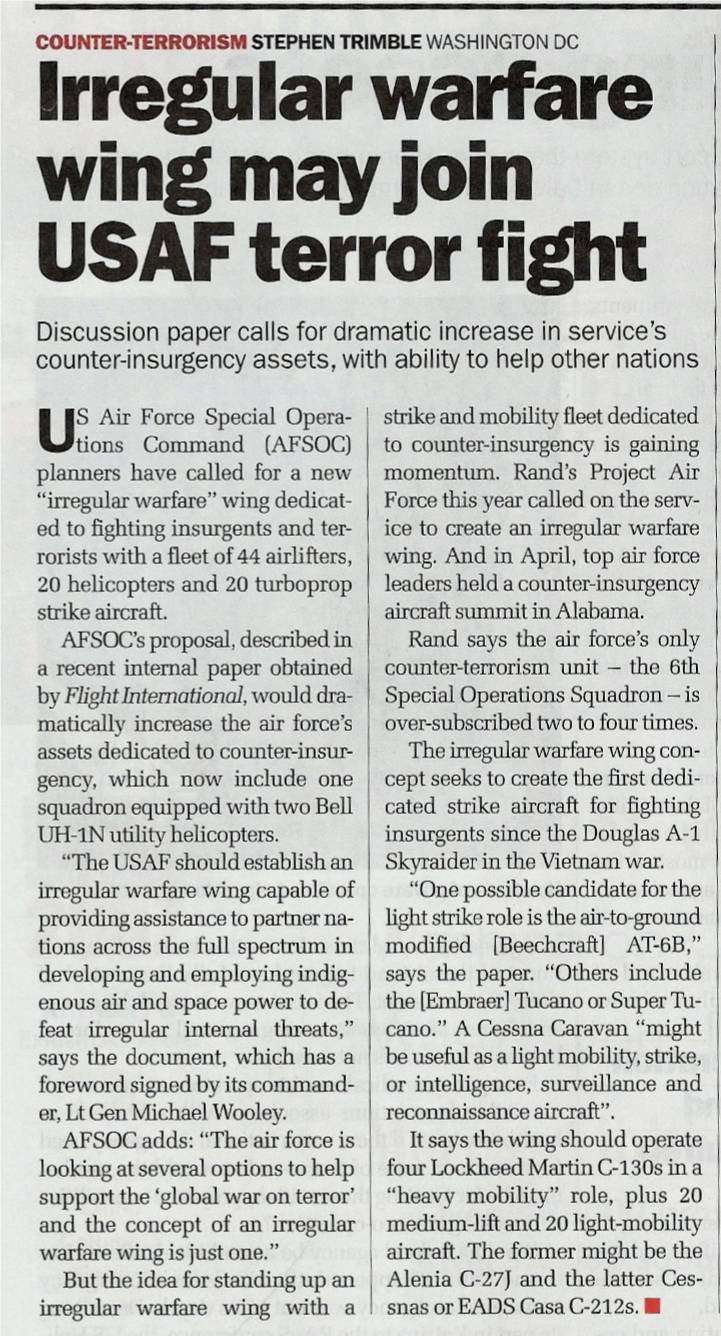
NEW! USAF WHITE PAPERS ON NEED FOR OBSERVATION/ATTACK PLANES FOR COUNTER-INSURGENCY OPERATIONS
combatreform.org/AFSOCWhitePaperUSAFIrregularWarfare.pdf
combatreform.org/ACSCPaperAT-6USAFInvestment.pdf
NEW WEB SITE: Excalibur Research & Development
http://excaliburrd.com/cs/forums/t/53.aspx
combatreform.org/AT-6CBrief.pdf
The words of former Iraqi Coalition Authority Director of Air Ops, Major General George Molan, Australian Defence Forces:
"Even in this, the highest technology war in history, there is a role for a man in a light manoeuvrable aircraft who can use his initiative, report and transfer data, remain on station with the ground troops day and night and most importantly, establish a personal relationship with the warriors.I do not accept the argument that a manned aircraft cannot be used ... due to the threat. I believe that this argument has been confused by the control of training and operations of the aircraft by the U.S. Air Force in Iraq.
The threat to the pilot of ... aircraft in Iraq operations ... is far less than to the equivalent Soldier on the ground in an equally expensive and complicated armoured vehicle. The benefit in having a pilot in the loop in talking to troops on the ground is priceless, particularly in less highly technically advanced armed forces.
The threat to a pilot manoevring low to optimise his effectiveness is not at all unreasonable in an Iraq-like insurgency. Threat is relative and should not be judged by highly sophisticated U.S. standards."
What do the CIA, Christian Missionaries and Drug Smugglers Have in Common--that the U.S. Army and marines Don't Have?
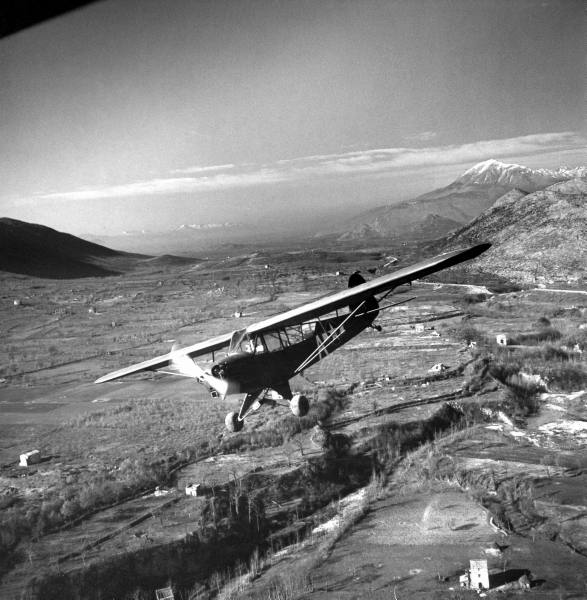
Answer: the CIA, Missionaries and Drug runners all employ small Short Take-Off and Landing (STOL) "Grasshopper" aircraft to be effective in their moral/immoral (you decide which is which!) efforts while the Army and marines try to make-do with costly, loud, slow and short-ranged vertical take-off and landing (VTOL) helicopters and are failures in what they are supposed to do.
The CIA's Secret War in Tibet using STOL aircraft
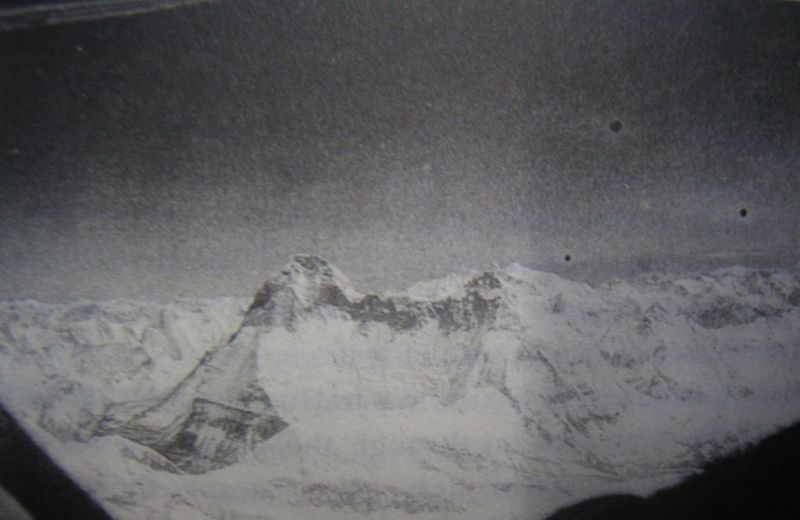
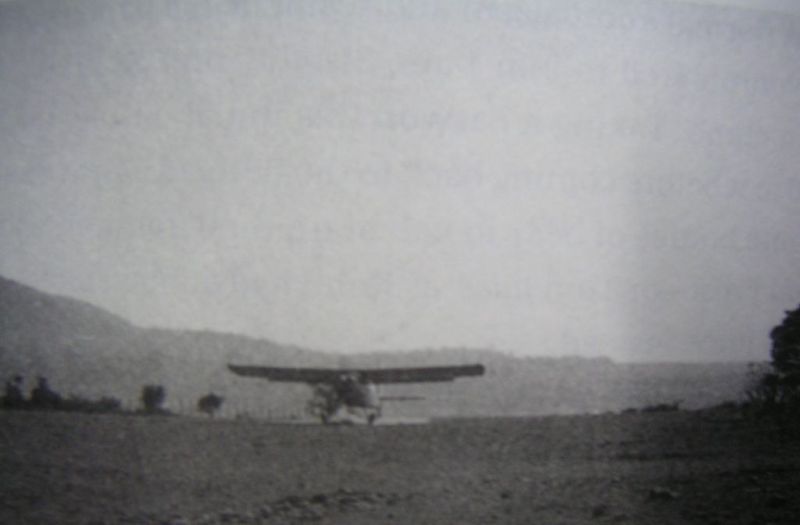
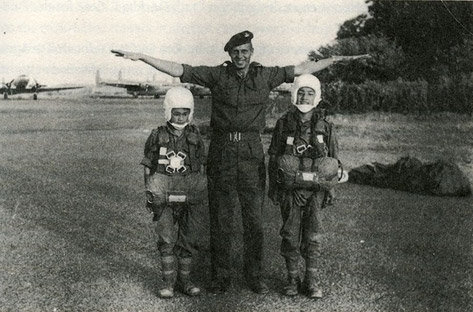
T.J. Thompson with two Tibetan student riggers - Agra AF Stn in 1963. In the background is a C-47 Dakota and two C-119 Flying Box Car aircraft. T.J. Thompson (The CIA's Secret War in Tibet)
To see the CIA's effective use of STOL fixed-wing aircraft from its inception in 1947, read Colonel Jerry Thigpen's book Praetorian Starships to see how they inter-mesh with the USAF's own Air Commando use of such sturdy airplanes to get-the-job-done.
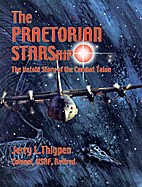
You can also watch the black comedy "Air America" with Mel Gibson to see the CIA STOL fixed-wing fleet in action with the Pilatus PC-6 Turboporter [USAF: AU-23 Peacemaker]. Another area where the CIA ran ops was in Tibet as described in the web pages below that quote from the two books below:
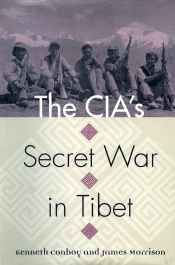
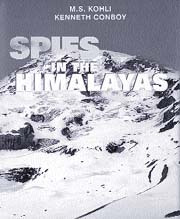
During WW2, the OSS infiltrated and exfiltrated agents into the China-Burma-India (CBI) theater of operations using the help of USAAF Colonel Phil Cochrane's 1st Air Commando transports like the C-46 Commando which had two side jump doors and a cargo capacity greater than the smaller, single jump-door C-47 SkyTrain/Dakota but had a propensity to catch fire and explode if hit as the U.S. Army found to its horror during the Operation Varsity Airborne operation to cross the Rhine river in 1945.
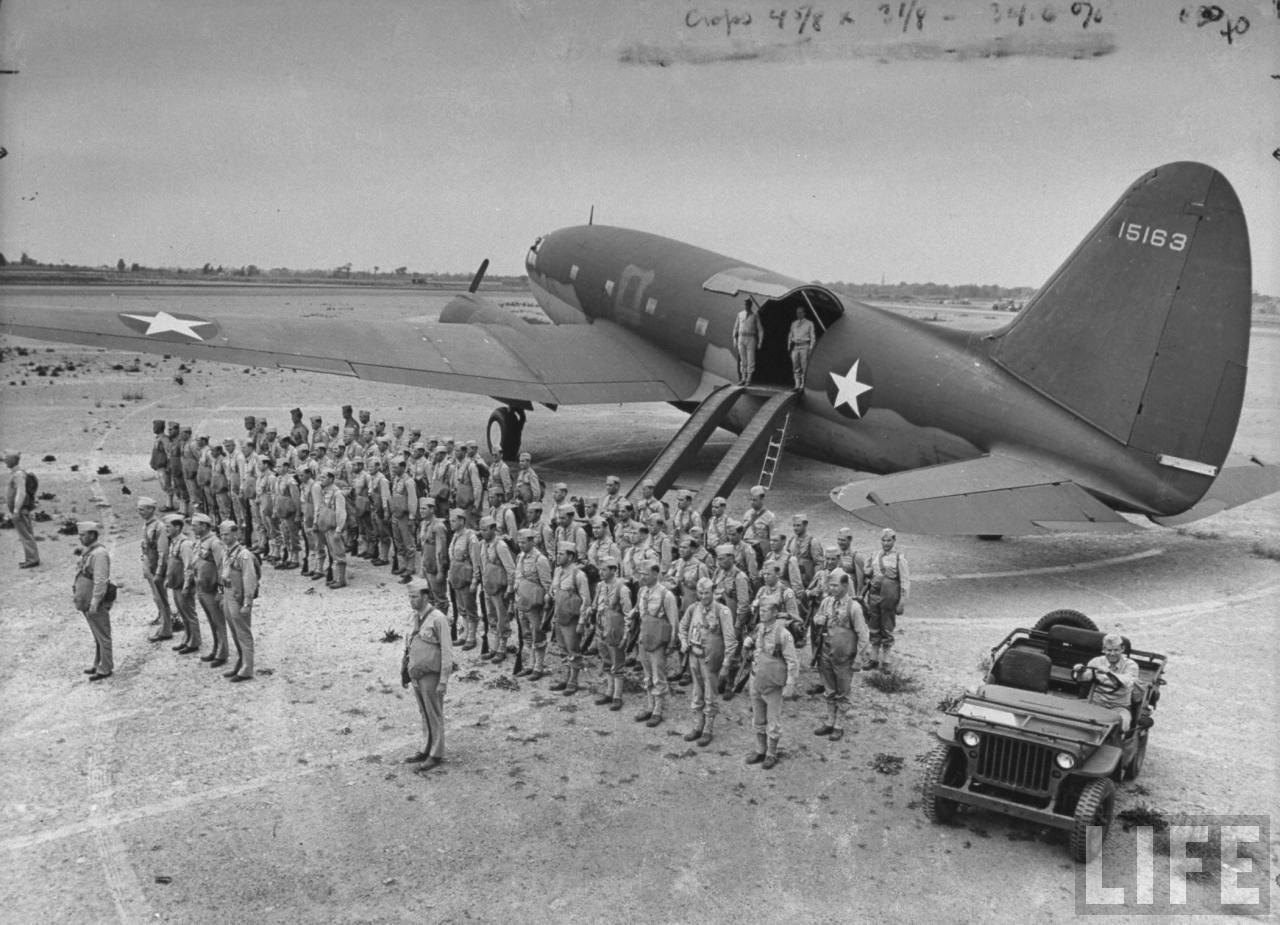
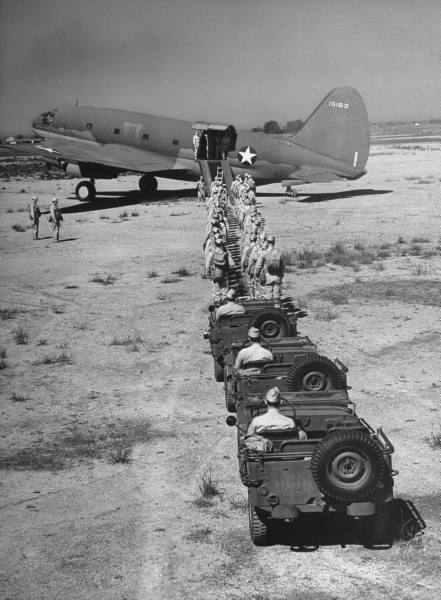
Another problem was while being a tail-dragger placed the wings in a high angle-of-attack for STOL performance, it made loading/unloading cargo at a slant difficult.
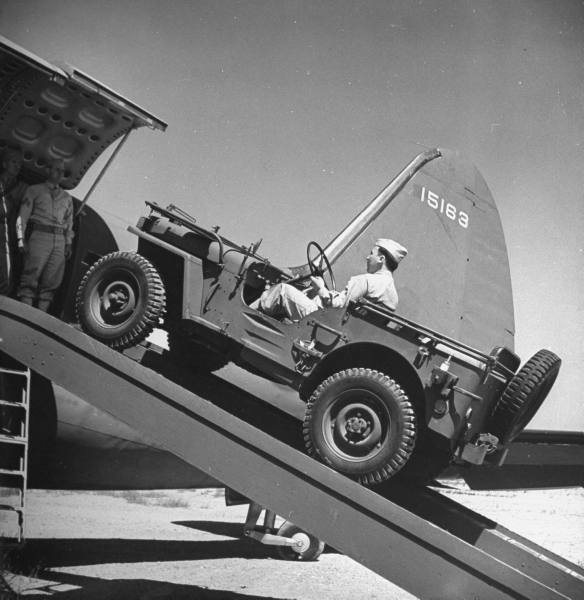
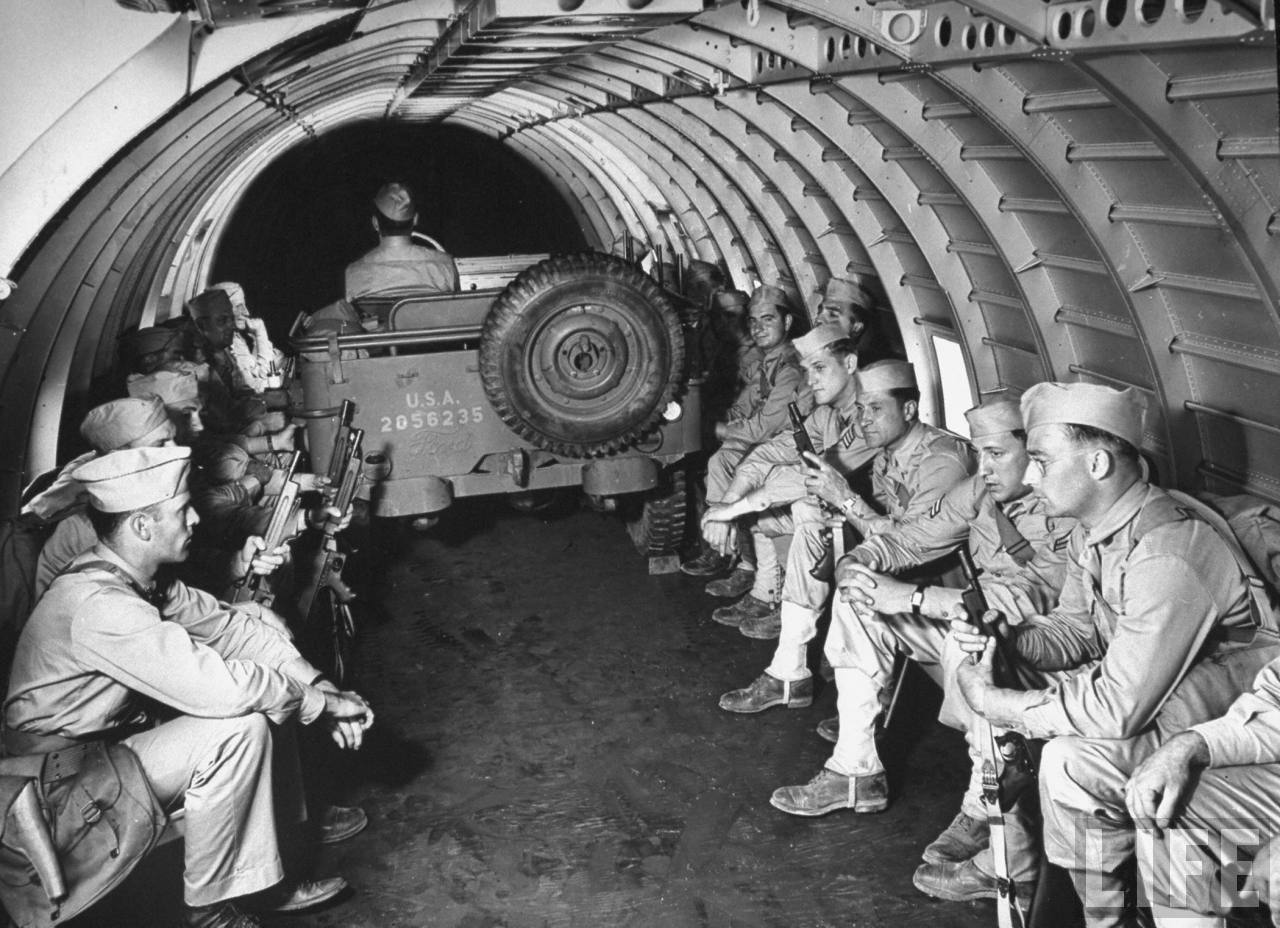
With the tail-draggers out of vogue with the tricycle landing gear, newly-created USAF, C-46s became available to the CIA to give to its front companies and allied nations.
One of the interesting things a C-46 could do was to carry inside a STOL observation/attack plane! (a Killer Bee)
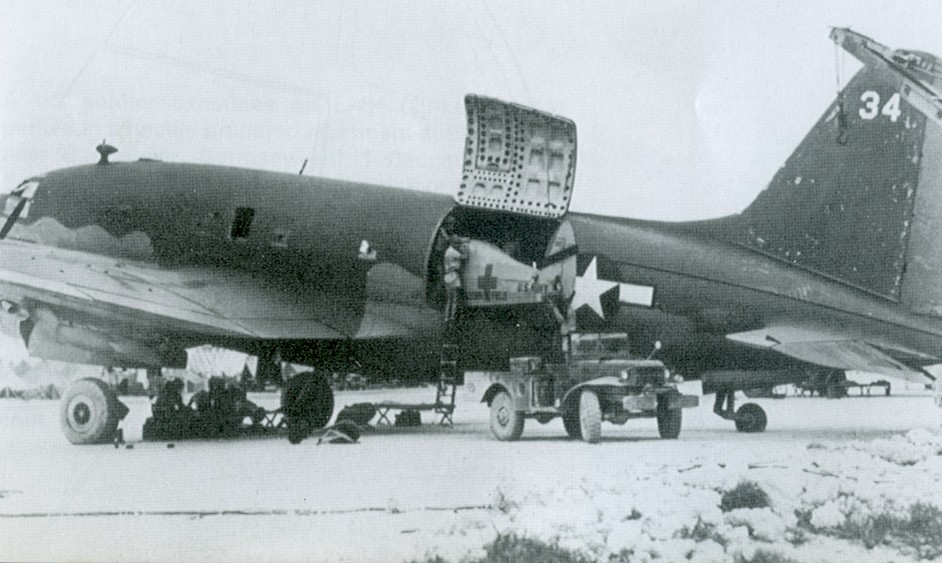
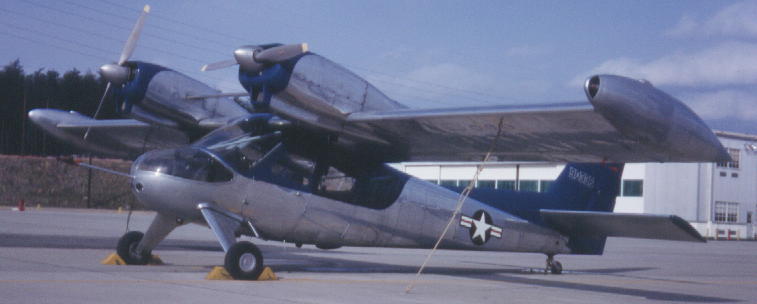
A Twin Helio STOL plane during USAF trials in 1961; this aircraft was later turned over to ARC; Harry Aderholt
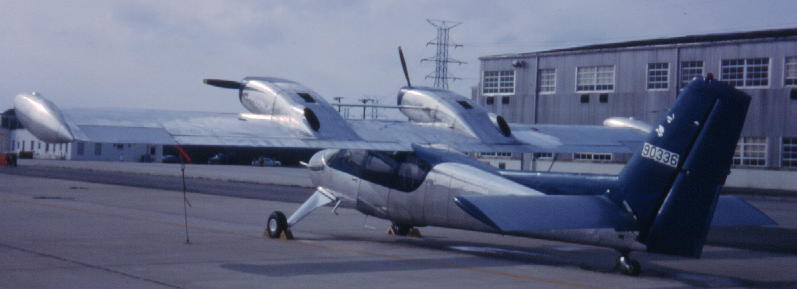
Twin Courier N8745R in flight. Only a handful of this type were ever built, and two of them ended up in India.
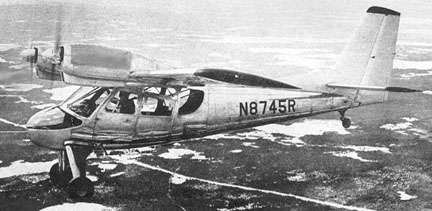
Twin Courier [90336] photographed possibly at Hulburt, Florida in 1962. This aircraft was transferred to ARC.
EXCERPT:
Now serving with the CIA, Rector was on hand for the initial four aircraft deliveries within a week of ARC's creation. First to arrive at Oak Tree was a pair of C-46D Commandos; inside each was a disassembled U-10 Helio Courier. A five-seat light aircraft, the Helio Courier had already won praise for its short takeoff and landing (STOL) ability in the paramilitary campaign the CIA was sponsoring in Laos. Without exaggeration, it could operate from primitive runways no longer than a soccer field. More aircraft deliveries followed, totaling eight C-46 transports and four Helio Couriers by early 1964.Under Rector's watch, the CIA arranged for the loan of some of the best pilots from its Air America roster to act as instructors for the ARC crews. Heading the C-46 conversion team was Bill Welk, a veteran of the Tibet overflights. For the Helio Courier, Air America Captain James Rhyne was dispatched to Oak Tree for a four-month tour. During this same period, T. J. Thompson, who had been assisting with the Tibetans' jump training at Agra, began work on a major parachute facility -- complete with dehumidifiers, drying towers, and storage space at Charbatia. "By the time it was finished," said Thompson, "it was larger than the facilities used by the U.S. Army in Germany."
Under the tutelage of the Air America pilots, the ARC aircrew contingent, including two captains on a one-year loan from Kalinga Air Lines, proved quick studies. By the close of 1963, transition training was nearly complete. For a graduation exercise, a demonstration was planned at Charbatia for 2 January 1964. Among the attendees would be [Prime Minister of India] Nehru himself.
Arriving on the assigned day, the prime minister took center seat in a rattan chair with a parasol shading his head. On cue, a silver C-46 (ARC planes bore only small tail numbers and Indian civil markings) materialized over Charbatia and dropped bags of rice and a paratrooper. Then a Helio Courier roared in and came to a stop in an impossibly small grassy patch in front of the reviewing stand. An "agent," hiding in nearby bushes with a bag of "documents," rushed aboard the Helio. Showcasing its STOL ability, the plane shot upward from the grass and over the stands. Nehru, at once impressed and confused, turned to the ARC and CIA officials in attendance and asked, "What was that?"
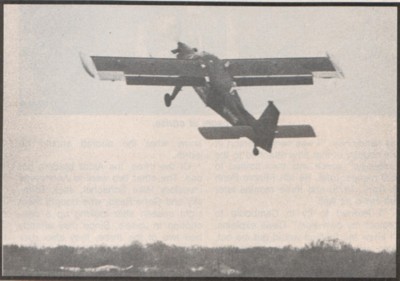
vayu-sena.tripod.com/other-cia-tibet-conboy.html
The CIA's Secret War in Tibetby Kenneth Conboy and James Morrison
University Press of KansasChapter Fourteen, "Oak Tree"
For the eight Indians -- six from the Indian air force, two from the Intelligence Bureau -- even a van ride had become an abject lesson in the finer points of tradecraft. Sent to Washington in mid- March 1963, they were to be the cadre for the covert airlift cell conjured earlier by Biju Patnaik and Bob Marrero. For the first two weeks, Marrero, who was playing host, arranged for briefings at a row of CIA buildings near the Tidal Basin.
By the beginning of April, the venue was set to change. A van pulled up to their Washington hotel in the dead of night, and the eight Indians plus Marrero piled into the back. All the windows were sealed, and the Indians soon lost their bearings as the vehicle drove for an hour. When they finally stopped, the rear doors opened nearly flush against a second set of doors. Hurried through, they took seats in another windowless cabin tucked inside the belly of an aircraft.
Landing at an undisclosed airfield -- only years later would they learn that it was inside Camp Peary -- the Indians were taken to an isolated barracks. Over the next month, a steady stream of nameless officers lectured on the full gamut of intelligence and paramilitary topics. There were surreal touches throughout: their meals were prepared by unseen cooks, and they would return to their rooms to find clothes pressed by unseen launderers.
The leader of the eight Indians, Colonel Laloo Grewal, had a solid reputation as a pioneer within the air force. A turbaned Sikh, he had been commissioned as a fighter pilot in 1943 and flew over 100 sorties during World War II in the skies over Burma. Immediately after independence in 1947, he was among the first transport pilots to arrive at the combat zone when India and Pakistan came to blows over Kashmir. And in 1952, he was in the first class of Indian aviators selected to head to the United States for transition training on the C-119 transport. When the call went out for a dynamic air force officer to manage a secret aviation unit under the auspices of the Intelligence Bureau and CIA, Grewal was the immediate choice.
Following the training stint at Peary, six of the students returned to New Delhi. The two most senior members, Grewal included, remained for several additional weeks of specialized aviation instruction. Marrero, meanwhile, made arrangements in May to head for India to conduct the comprehensive air survey broached with Biju Patnaik in their December 1962 meeting. Joining Marrero would be the same CIA air operations officer who had been involved with the earliest drops into Tibet, Gar Thorsrud.
Much had happened to Thorsrud since his last involvement with Tibet. In the spring of 1961, he was briefly involved in Latin America. Later that summer he shifted to Phoenix, Arizona, and was named president of a new CIA front, Intermountain Aviation.
Among CIA air proprietaries, Intermountain was in the forefront of innovation. With its main operational base at Marana Air Park near Tucson, Arizona, the company specialized in developing new aerial support techniques. It was Intermountain, for example, that worked at perfecting the Fulton Skyhook, a recovery method that whisked agents from the ground using an aircraft with a special yoke on its nose. Intermountain experts also experimented with the Timberline parachute configuration (a resupply bundle with extra-long suspension lines to allow penetration of tall jungle canopy) and the Ground Impact system (a parachute with a retainer ring that did not blossom until the last moment, allowing for pinpoint drops on pinnacle peaks).
It was this eye for innovation that Thorsrud carried with him to India. For three months, he and Marrero were escorted from the Himalayan frontier to the airborne school at Agra to the Tibetan training site at Chakrata. Much of their time was spent near the weathered airstrip at Charbatia, where they were feted by the affable Patnaik. He offered use of Charbatia as the principal site for a clandestine air support operation and immediately secured funds from the prime minister for reconstruction of the runway. Patnaik also donated steel furniture from one of his factories, cleared out his Kalinga Air Lines offices to serve as a makeshift officers' quarters, and even loaned two of his Kalinga captains. "He was Nehru's fix-it guy," said Thorsrud. "He got things done."
Returning to New Delhi after nearly three months, the two CIA men were directed to a hotel room for a meeting with a representative of the Intelligence Bureau, T. M. Subramanian. Known for his Hindu piety and strict vegetarian diet, Subramanian had been serving as the bureau's liaison officer at Agra since November, where he had been paymaster for amenities offered to the USAF crewmen rushing military gear to India. He was also one of the two intelligence officers who had been trained at Camp Peary [Virginia] during April.
In the ensuing discussions between the CIA aviators and Subramanian, both sides spoke in general terms about the best options for building India's covert aviation capabilities. In one area the American officers stood firm: the United States would not assist with the procurement of spare parts, either directly or indirectly, for the many Soviet aircraft in the Indian inventory.
A subject not discussed was which U.S. aircraft would be the backbone for the envisioned covert unit. Earlier in the spring, this had been the subject of serious debate within the CIA. Wayne Sanford, the senior paramilitary officer in New Delhi, had initially proposed selection of the C-119.
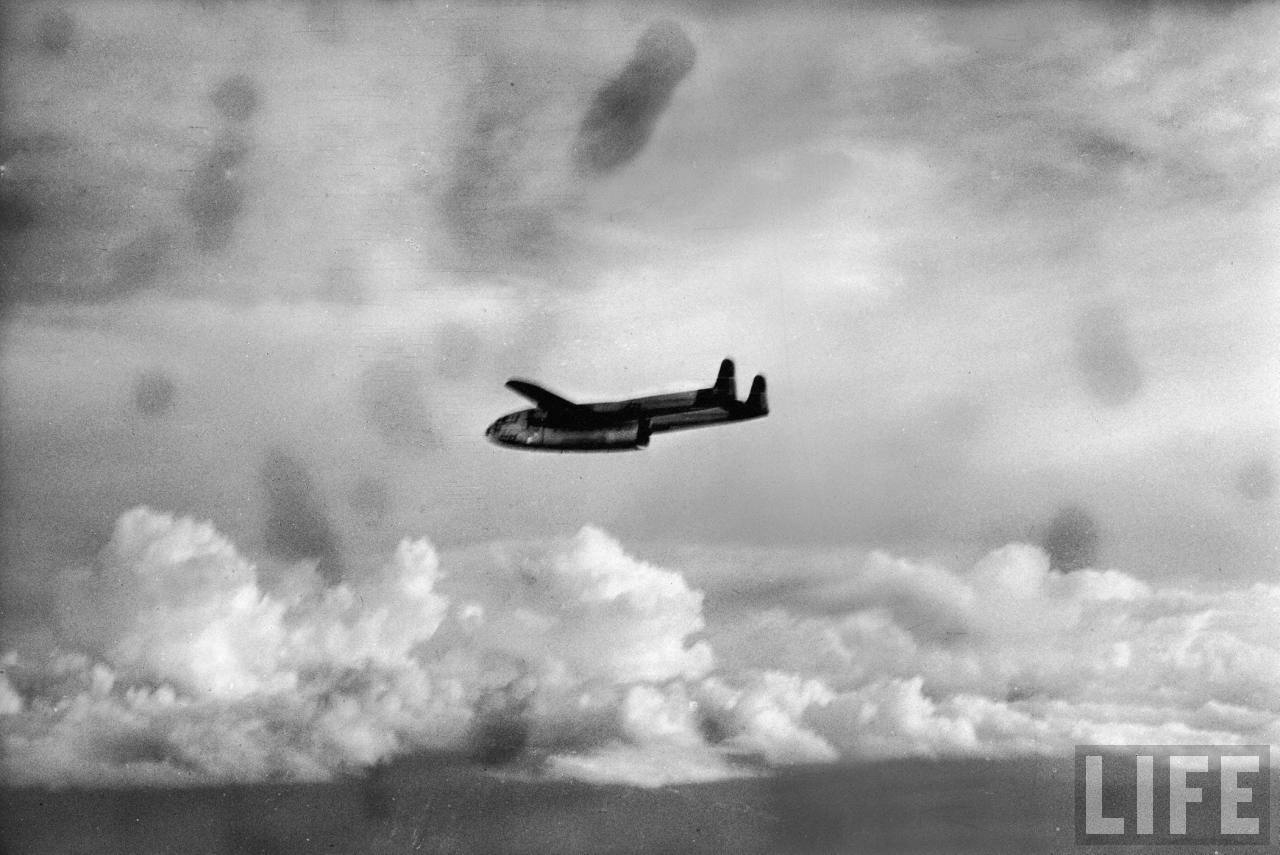
CIA contract pilot, "Earthquake" McGown's C-119 under VietMinh anti-aircraft fire dropping supplies to the French at Dien Bien Phu in 1954This made sense for several reasons. First, more than fifty C-119 airframes had been in the Indian inventory since 1952; it was therefore well known to the Indian pilots and mechanics. Second, beginning in November 1962, the Indians had ordered special kits to add a single turbojet atop the center wing section of half their C-119 fleet. The added thrust from this turbojet, tested in the field over the previous months, allowed converted planes to operate at high altitudes and fly heavy loads out of small fields. The United States pledged in May 1963 to send another two dozen Flying Boxcars to India from reserve USAF squadrons.
Other CIA officials in Washington, however, were keen to present the Indians with the C-46 Commando. A workhorse during World War II, the C-46 had proved its ability to surmount the Himalayas while flying the famed "Hump" route between India and China. More important, other CIA operations in Asia -- primarily in Laos -- were making use of the C-46, and the agency had a number of airframes readily available.
There were drawbacks with the C-46, however. It was notoriously difficult to handle. Moreover, the Indians did not operate the C-46 in their fleet, which meant that the pilots and mechanics would need a period of transition. When CIA headquarters sent over a USAF officer to sing the praises of the C-46 in overly simplistic terms, Grewal cut the conversation short. Recalls Sanford, "He flatly told the U.S. officer that he had been around C-46s longer than the American had been in the air force."
In the end, however, the Indians could not protest CIA largesse too loudly. When Marrero and Thorsrud had their meeting with Subramanian, selection of the C-46 was an unstated fait accompli. The next day, Subramanian returned to the two CIA officers with a verbatim copy of the hotel discussion. "Either he had a photographic memory," said Thorsrud, "or somebody was listening in and taking notes." Both Americans signed the aide-memoire as a working basis for cooperation.
As a final order of business, Marrero asked for an audience with Mullik. With the Charbatia air base -- now code-named Oak Tree 1 -- still in the midst of reconstruction, the first aircraft deliveries would not take place until early autumn. This did not dampen Marrero's enthusiasm as he recounted the list of possible cooperative ventures over the months ahead. The aloof Mullik replied with an indifferent stare. "Bob, we will call you when we need you."
Despite Mullik's lack of warmth, efforts to create the covert air unit went ahead on schedule. On 7 September 1963, the Intelligence Bureau officially created the Aviation Research Centre (ARC) as a front to coordinate aviation cooperation with the CIA. Colonel Grewal was named the first ARC operations manager at the newly completed Charbatia airfield. He was given full latitude to handpick his pilots, all of whom would take leave from the military and belong -- both administratively and operationally -- to the ARC for the period of their assignment.
In New Delhi, veteran intelligence officer Rameshwar Nath Kao took the helm as the first ARC director. A Kashmiri Brahman like Nehru, forty-five-year-old Kao was a spy in the classic sense. Tall and fair skinned, he was a dapper dresser with impeccable schooling; he was a Persian scholar and spoke fluent Farsi. Dignified and sophisticated, he had long impressed the officers at the CIA's New Delhi station. "I had the opportunity to drive with him from Kathmandu back to India," recalled one CIA official. "At each bridge we crossed, he would recount its technical specifications in comparison to its ability to support the heaviest tank in the Chinese inventory."
To assist Kao and Grewal, the CIA dispatched Edward Rector to Charbatia in the role of air operations adviser. Qualified as a U.S. Navy dive-bomber pilot in 1940, Rector had joined Claire Chennault's famed Flying Tigers the following year. He would later score that unit's first kill of a Japanese aircraft and go on to become an ace. After switching to the U.S. Army Air Forces (later the U.S. Air Force), he retired as a colonel in January 1962.
Rector came to Oak Tree with considerable Indian experience. During his Flying Tigers days, he had transited the subcontinent. And in late 1962, following his retirement from military service, he had gone to India on a Pentagon contract to coordinate USAF C-130 flights carrying emergency assistance to the front lines during the war with China.
Now serving with the CIA, Rector was on hand for the initial four aircraft deliveries within a week of ARC's creation. First to arrive at Oak Tree was a pair of C-46D Commandos; inside each was a disassembled U-10 Helio Courier. A five-seat light aircraft, the Helio Courier had already won praise for its short takeoff and landing (STOL) ability in the paramilitary campaign the CIA was sponsoring in Laos. Without exaggeration, it could operate from primitive runways no longer than a soccer field. More aircraft deliveries followed, totaling eight C-46 transports and four Helio Couriers by early 1964.
Under Rector's watch, the CIA arranged for the loan of some of the best pilots from its Air America roster to act as instructors for the ARC crews. Heading the C-46 conversion team was Bill Welk, a veteran of the Tibet overflights. For the Helio Courier, Air America Captain James Rhyne was dispatched to Oak Tree for a four-month tour. During this same period, T. J. Thompson, who had been assisting with the Tibetans' jump training at Agra, began work on a major parachute facility -- complete with dehumidifiers, drying towers, and storage space at Charbatia. "By the time it was finished," said Thompson, "it was larger than the facilities used by the U.S. Army in Germany."
Under the tutelage of the Air America pilots, the ARC aircrew contingent, including two captains on a one-year loan from Kalinga Air Lines, proved quick studies. By the close of 1963, transition training was nearly complete. For a graduation exercise, a demonstration was planned at Charbatia for 2 January 1964. Among the attendees would be Nehru himself.
Arriving on the assigned day, the prime minister took center seat in a rattan chair with a parasol shading his head. On cue, a silver C-46 (ARC planes bore only small tail numbers and Indian civil markings) materialized over Charbatia and dropped bags of rice and a paratrooper. Then a Helio Courier roared in and came to a stop in an impossibly small grassy patch in front of the reviewing stand. An "agent," hiding in nearby bushes with a bag of "documents," rushed aboard the Helio. Showcasing its STOL ability, the plane shot upward from the grass and over the stands. Nehru, at once impressed and confused, turned to the ARC and CIA officials in attendance and asked, "What was that?"
How could we be so stupid as to try to make helicopters fly missions requiring long ranges and times when they clearly are too inefficient and slow?
The answer is because both the Army and marine corps are populated by people have never learned what is possible and not possible on planet earth against human foes; both of these services take people off the street and give them rote memorization to operate their job's equipments in a technotactical vacuum without any truthful context like we were still in WW2 mass mobilization lacking the time to create a professional understanding. Its not surprising at all that Army Soldiers and marines don't know squat about combat vehicle mobility, armor protection and firepower, either. Its also no surprise that they are fundamentally ignorant of how High Explosives (HE) dominate Non-Linear Battlefields (NLBs)! They are clueless because they have never been taught what the truth is about their profession because frankly, we don't want them to be professionals with a "map of military understanding" as retired Colonel Don Snider says in his many writings, because its easier for a BUREAUCRACY to manipulate underlings if they are kept in the dark so they are weak, co-dependant "yes-men" (and women) who must drool over every word of their superiors to feed their Narcissistic Personality Disorder's (NPD) need for fawning attention.
youtube.com/watch?v=dwQEP1CGY7E
So how do we cut this "Gordian knot" of unprofessional ignorance. Former Army Chief of Staff General Gordon R. Sullivan who started the "Situational Awareness" effort of electronic mental devices to track our forces to see through the "Fog of war" says we should be constantly transforming ourselves with hands-on experimentation.
youtube.com/watch?v=yFUS4DAmVqs
Retired Army Colonel Douglas Macgregor reiterates that small batches of new equipments should be placed in the hands of designated troops and tried out in demanding field conditions.
youtube.com/watch?v=fU4FG9lMaII
However, if we follow their advice ONLY A SMALL SELECT FEW of the Army will get the go/no-go knowledge of what works through experimentation and their conclusions will then be crammed-down-the-throats of the rest of the force as fait accompli; like it or leave it. In the process, the Fog of Technotactical Ignorance (which is really the first "Fog of War") will not be lifted from the officers and NCOs of the Army much less our Soldiers. Its just as important that leaders know WHAT DOESN'T WORK--AND WHY--as with what does and why? We will continue to stumble from cliche'-created and egotistical prejudice and Hollywood war misconception to another and suffer both nation-state war (NSW) battle defeats like Task Force Smith in 1950, Beirut in 1983 etc. and "bleeding from a thousand cuts" like during a long-term, sub-national conflict (SNC) occupation of Iraq/Afghanistan if we remain and perpetuate fundamental cluelessness. Its no surprise when reading the biography of General James VanFleet that while a West Point cadet in 1914 that he was surrounded by Army officers who still held that men sitting atop horses in a Cavalry were still viable as mainline maneuver forces in the face of inter-locking machine gun fire--no one forced them to SEE IN PERSON that their views were utter non-sense. In an anti-intellectual, ego-driven bureaucracy like the Army and marines objective FACTS are not welcomed at face value, the majority of the weak egos involved have to experience and suffer in person the issue at hand if there is any hope whatsoever of getting them clued in. This weak psychology of the free world's militaries is documented in former British Army Engineer officer, Dr. Norman Dixon's book, On the Psychology of Military Incompetence.
The solution is for us to create a COMBAT COLLEGE, where what equipments and weapons can and cannot do via myriad tactics, techniques and procedures (TTP) are demonstrated and tried by ALL young officers in a Discovery Channel "Myth Busters" kind of way, so ALL our leaders get to take part in basic experimentation so they can have a FUNDAMENTALLY CORRECT understanding of modern war to include proprietary advantages only defense companies know and otherwise keep to themselves fostering general (literally and figuratively) ignorance. The Combat College would last for 6 months and cover every aspect of land combat and would not be yet another harassment package where officers have to absorb information by rote and spit it back on tests lest they get bad grades and ruin their careers. They will be taught to THINK and to justify their opinions based on DEMONSTRATED FACTS which they can draw from their experiments which will be videotaped and archived as well as CLASSIFIED weapons effects databases.
combatreform.org/combatcollege.htm For ALL enlisted Soldiers, they should go through a "mini-Combat College" during their basic training called Objective Warfighting laboratory (OWL) described in the web page below:
combatreform.org/cluelessarmy.htm Military Ground Force Aviation Understood
One of the areas that Combat College should cover in detail is what military aviation can and cannot do. That everyone has to become a pilot to learn this is a pile of crap because we have thousands of pilots in the Army and marines today who are clueless despite their equipment operation skills that are tied directly into their narcissistic egos. Narcissism is the uber brain cell killer on any issue. Its no surprise then that as the helicopter bureaucracy grew during the 1960s that rotor-heads squeezed STOL fixed-wing aviation out of both the Army and marines to everyone's detriment. No one called them in on their bullshit; no one fact-checked them and forced a "reality check". So as budgets grew, the ability of Army and marine aircraft to remain overhead to support our troops evaporated. Its therefore no surprise that the unmanned air vehicle (UAV) as a knee-jerk reaction and panacea savior to pilots refusing to fly slower-than-jets but much faster-than-helicopter STOL fixed-wing "Grasshoppers".
Simple board war games with die-cast metal aircraft, tanks and troops and computer simulations can and should be conducted to show that helicopters cannot remain over the battlefield long enough to render Maneuver Air Support (MAS) and their logistical factors can be brought into the war game to show how much its costing us in fuel and repairs. Show the impacts of this on the Army's annual budgets. There are already similar strategy games available on the civilian market that grognard civilians play and have a better grasp of force structure and tactics than the weak-ego military narcissist who knows no context except his rote memorization operator skills as a "first person shooter" video game in real life. Combat College students could be brought to a helicopter maintenance facility and see first-hand how ALL helicopters have to be RE-BUILT after x amount of flight hours lest they malfunction, crash and burn.
The upshot of providing such a "reality check" on military ground force aviation would be that the rotorheads would realize they need to get off their asses and make their helicopters fly faster (Piasecki VTDP) and with more stealth (NOTAR) and with effective sky camouflage not the ridiculous dark green-in-blue-skies paint schemes. They will realize the need and stop having their egos stand in the way of the Army having fixed-wing STOL aircraft for long-range, long loiter time missions that point A-to-B helicopters are ill-suited for. The need to make all Army aircraft ground-mobile and not needed Air Force-style pampered air bases (by whatever name we want to call them; FireBase, FOB etc.) to avoid enemy HE targeting would be realized. In a word, we would have what we lack now:
Progress.
NEW VIDEOS!
youtube.com/watch?v=V7vfVP-spns
Grasshopper STOL Logistics
Now imagine the STOL Grasshopper's uber fat tires carried JP-8/diesel FUEL and was nitrogen-inerted...it could land and act as a "fat cow" to refuel other Grasshoppers and/or M113 Gavin light tanks in a Light Mechanized Infantry Rhodesian-style "Fire Force".
combatreform.org/abnlogistics.htm In the past, we had fuel bladders that were wheels that could be towed by ground vehicles and STOL Grasshoppers in WW2--that themselves only needed 18 gallons of fuel--could carry a 150 gallon drop tank in the place where a wounded Soldier on a stretcher usually sat, to effect fuel resupply logistics.
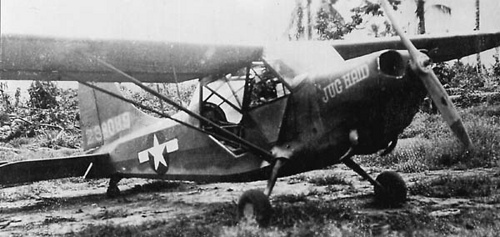
Such a "Gavin Force" would exploit the "Killer Bee" effect of having many smaller air and ground platforms working together to achieve greater surveillance, firepower and maneuver effects than a handful of larger, bloated cash-cow platforms military bureaucracies and their egomaniac victim-operators lust for...sometimes LESS is MORE; and ECONOMY with taxpayer dollars can achieve GREATER MILITARY EFFECTS. Especially when fighting against the still very large earth to achieve 24/7/365 coverage that is light enough to prevail in/over even closed terrains
youtube.com/v/uX-48e05foQ
Marvel at the OV-1D Mohawk observation/attack aircraft on active duty today with the Argentine Army short take-off from a grassy field, and disappear into the blue sky with its light gray camouflage. With amazing maneuverability, it turns around before you know it and swoops down to less than 100 feet for a low-level pass. Notice how QUIET the twin tubroprop OV-1 is as it approaches and when it flies by; demonstrating why the Vietnamese called it the "Whispering Death" far quieter than ANY helicopter even to the present day. Consider how quiet OV-1s with 5-bladed props and heat/sound silencing at altitude would be and how they could be scouring the skies over places like Afghanistan/Iraq with both human eyes and sensors to deny those on the ground below an ability to emplace high explosive land mines.
OV-1 Mohawks in Action during the Cold War, Vietnam and Iraq! Small Scout Helicopters, too!
youtube.com/watch?v=FSW7Dqu4e_8
Too-Fast, Unarmored, Fighter-Bombers Unsafe and Ineffective for Troop Ground Support
"'Fast moving aircraft are not designed to support ground troops,' said Army Sgt. First Class Frank Antenori. 'As much as the Air Force and Navy would like to think that, fighter aircraft that travel at speeds can't slow down to identify the targets,' he told National Defense......
He said the Air Force A-10 attack plane and the Army Apache helicopter are the ideal platforms for close air support, best suited to SOF missions. Air Force F-16s and Navy F/A-18s are much too fast to be able to properly identify targets, he said. 'The problem is getting the pilots at the altitudes and speeds that they are flying to be able to ID the targets,' he said.
A-10s and Apaches do a much better job, because they can move at a slower speed. 'With fast movers, I never had any success," he said.'
"Fast Jets Not Ideal Choice for Close Air Support" by Roxana Tiron, National Defense magazine, April 2004
The Arizona Republic (Phoenix)April 3, 2007
Peril To Forces Called Cause Of Crash [WRONG: it was WRONG type of aircraft]
By Charles Kelly, The Arizona Republic
Maj. Troy "Trojan" Gilbert, a Luke Air Force Base fighter pilot killed in Iraq on Nov. 27, crashed because he was so focused on saving friendly troops from insurgents that he flew too low, Air Force officials have concluded. Gilbert, 34, of the Litchfield Park area, was trying to head off an attack by insurgents on ground troops and the crew of a downed Army helicopter 20 miles northwest of Baghdad.
At the time, Gilbert was leading a flight of two F-16 fighter-bombers near Taji, according to an Air Force accident investigation board report. He responded when insurgents attacked troops on the ground with truck-mounted heavy machine guns, rocket-propelled grenades, small-arms fire and mortars. Gilbert carried out one strafing run against the enemy vehicles, striking a truck with his 20mm Gatling gun before pulling out only 200 feet from the ground, said the head of the accident investigation board, Brig. Gen. David L. Goldfein.
Gilbert flew even lower on his second strafing run and was unable to pull up before he crashed, Goldfein said. Investigators concluded that he died instantly.
His actions helped save the lives of the helicopter crew and other coalition ground forces, Goldfein said. Gilbert was awarded the Distinguished Flying Cross with Valor.[And the USAF-fighter-bombers-for-everything bureaucracy continues operating the wrong type aircraft lest their ego platforms have to share the budgetary limelight with slower, more agile armored aircraft like the A-10 suitable to the job].
He chose to attack at a very low altitude because he was concerned about making sure he was correctly identifying enemy vehicles trying to merge with civilian vehicles, Goldfein said. Gilbert attacked from a difficult angle because he apparently wanted to bring fire on the enemy vehicles quickly to protect the ground troops, who were in a very perilous situation.
Gilbert's remains were removed from the crashed plane before coalition forces could get there. An intensive search was immediately conducted without result. Coalition forces are still working to find Gilbert's remains and return them to his family, Goldfein said.
The U.S. military nation-state war racketeers do not want to change and do sub-national conflict tasks properly with proper equipment to resolve an allegedly "long war" they want to keep on milking for years and years. They need to be fired by WE THE PEOPLE and replaced by people representing us FROM US ie: the All-Victim-Force (AVF) must be ended and replaced with a broad form of national service where non-racketeers run the services.
iht.com/articles/2007/03/15/opinion/edpllizzari.php
Repeating Soviet mistakesValerio Pellizzari
Published: March 15, 2007ROME: A few weeks ago a young military spokesman representing Italian Coalition forces in Afghanistan was summarily relieved of his duties after commenting that Italian Soldiers were building a Roman Catholic church in Herat dedicated to the Virgin Mary, whose religious importance he termed, "spiritually meaningful to Muslims too."
A careful reading of the Koran might have made him feel otherwise. Moreover, it might have helped had he known that only one church has ever been allowed on Afghan soil. It was authorized by King Amanullah and built in 1933 in gratitude for Italy's being among the first countries to recognize Afghan independence.
However, there are worse misunderstandings in Afghanistan, the worst being that senior NATO officials at their Brussels headquarters don't seem to grasp that they are repeating the same tragic mistakes made by Kremlin generals 25 years ago. NATO today, like Moscow a generation ago, has opted to increase spending to conduct aerial warfare, thereby intending to reduce military fatalities on the ground, maintain relative control of communications networks and at least pretend to control the country. The strategy isn't working.
The Italian government, for one, doesn't seem to understand this either. Italy's transformation last summer, from the government of Silvio Berlusconi to that of Romano Prodi, occasioned a hectic domestic debate over Afghanistan. Everybody important weighed in, even though Afghanistan had been ignored by Italians for years. Except for Dr. Alberto Cairo, with the International Red Cross, and Dr. Gino Strada with the organization Emergency, few Italians are associated with the country. Unfortunately, the discussion ignored the most important problem in fighting the war, the mistake of maintaining strategic dependence on aerial warfare. Debate centered instead on less-vital issues, like stopping the growing drug traffic, re-establishing the judicial system and building respect for democratic principles.
From June until November, 2006, NATO carried out roughly 2,100 aerial bombing missions there, an average of 18 daily missions, with some bombs weighing close to 2000 pounds. There was nothing cosmetic about this sustained, massive bombardment. However, during this same period, attacks by the Taliban, Al Qaeda and others opposed to President Hamid Karzai increased. The number of suicide bombers also rose. This made 2006 the bloodiest year in Afghanistan since the defeat of Mullah Omar and the Taliban in 2001.
NATO's aerial war has been ineffective. Relying so heavily on air attacks to keep fatalities low is simply repeating the same mistake that the Russians made in Afghanistan a generation ago. The most stunning example was the futile battle of Tora Bora to capture Osama bin Laden at the end of 2001. As Jonathan Randal writes in his book, "Osama," coalition troops did not fight on the ground at Tora Bora. It wasn't a battle at all, just a hail of missiles and bombs that came and went.
Even ignoring the basic tenet of military strategy that having ample numbers of ground troops is vital, other signs that strategic vision is lacking abound. It's not just the Italians who benightedly decide to build a Catholic church in an Islamic country at war. It's also the Americans, whose management of Kabul seems befuddled. For one thing, to protect their embassy in Kabul, the Americans have declared the whole city center off-limits to Afghanis, destroying any chance for normalcy there.
I asked Edmund McWilliams, who was in charge of the U.S. Embassy in Kabul in the late 1980s, about this. He confirmed that life under the doomed Soviet occupation wasn't much different than it is today. There was a nightly curfew back then, when the KGB worked out of the same headquarters that the CIA uses now. The Communist president, Mohammad Najibullah, used to shut down air traffic for hours whenever he flew anywhere, just like Karzai does now. The Kabul sky teemed with armored helicopters and Mig fighters. Nevertheless, the Russians eventually were obliged to withdraw.
They even bribed the guerrillas to avoid being attacked while retreating over the Salang Pass. The arrangement was made through channels of communication easily as mysterious as anything that Rudyard Kipling describes in "Kim." Still, news of the deal leaked out a week before the withdrawal.
Secrets don't exist in Afghanistan. Note how a suicide bomber was ready to strike recently at the Bagram air base after Vice President Dick Cheney landed there, with no evident advance notice of his visit given. Just one generation after the failed Soviet example, the Western presence in Afghanistan is tilting towards chaos, largely because the lessons of history, culture and modern warfare are being ignored.
Valerio Pellizzari is a special correspondent for Il Messaggero in Rome. He is the author of books on Afghanistan and the war in Iraq.
1. These are yet more reasons why the immature nation-state war Soldier/marine should not be tasked to do sub-national conflicts and why we need a NLB-SC composed of psychologically-screened, older more mature Soldiers.
combatreform.org/johnpaulvann.htm
The nation-state war racketeers don't want a properly trained/equipped NLB-SC because it may be the only "action" to justify their budgets and they certainly are not going to let someone else get the missions regardless of how unqualified they are to do them.
2. Another series of tragedies showing why we need low-altitude MANNED observation/attack aircraft with discretionary firepower to control the ground below 24/7/365 not sexy fighter-bombers that can't see what they are dropping and have to have their hands held by a GFAC on the ground below.
combatreform.org/USARMYAVIATIONDIGEST/grasshoppersmustreturn.htm
SRA, Aerial Car Bombs
By Carlton Meyer
Mar/20/2007Youtube.com has become one of the world's most popular websites in less than a year. It allows anyone to easily upload home-made videos for everyone to view -- all for free. This is an example of America's "new economy" because it loses millions of dollars a month with no real plan of how to make it profitable. Meanwhile, youtube and other new video databases have changed the way information can be presented over the Internet.
If a picture is worth a thousand words, a video is worth millions. Just a few video clips provide excellent examples of how the U.S. military failed in Iraq. Numerous stories have appeared in the press about U.S. Soldiers and marines slaughtering innocents. However, the most common method occurs when large aerial bombs are dropped on Iraqi cities. While the corporate media provides daily reports of civilians killed by car bombs, they rarely mention civilians killed by U.S. military bombs.
Here is a youtube clip of U.S. troops dealing with a sniper in a major city.
youtube.com/watch?v=Iq8oZ7_Z8pg
That blast was as powerful as any car bomb, and U.S. troops certainly didn't inspect the building beforehand to ensure it was not occupied by civilians. The audio is equally frighting as it shows immature soldiers laughing and cheering at the massive destruction, like teenagers enjoying fireworks. How would you like those yahoos rooting out insurgents in your neighborhood?
The Iraqi city of Ramadi has proven tough to pacify. Here are American "peacekeepers" exploding 2000 lb. bombs on its inhabitants.
youtube.com/watch?v=y_Lcjfdra2c
Here are two more recent examples of gratuitous death and destruction in Iraqi cities:
youtube.com/watch?v=MbE42svaMjM
youtube.com/watch?v=LGC5LmjVDIASearch youtube to find more. These are just incidents that were videotaped and uploaded at youtube. Such crimes occur daily in both Iraq and Afghanistan, and helps explain "why they hate us." Youtube allows viewers to comment, which provides frightening examples of the hatred many Americans have toward everyone. They don't care if innocent people are killed; they think it funny. While billions of dollars are spent each month to rebuild these nations, aerial bomb attacks probably destroy more each day than is rebuilt.
Some may claim these incidents are the result of some immature junior enlisted personnel. Daily evidence proves otherwise. The U.S. Central Command proudly posts its daily "airpower" summary on the Internet. Here is part of the March 7th summary:
------------------------------------------
SOUTHWEST ASIA - In Afghanistan yesterday, .... Also near Sangin, U.S. Navy F/A-18s received coordinates for a compound where enemy fire was originating. One of the F/A-18s dropped a Guided Bomb Unit-12 on the compound. A JTAC reported a good hit with an unusually large initial explosion and at least ten secondary explosions, possibly indicating destruction of a weapons cache. Other U.S. Navy F/A-18s dropped GBU-12s and GBU-38s on two separate anti-Coalition insurgent buildings near Sangin. All weapons hit the desired target as confirmed by a JTAC. Other F/A-18s also dropped GBU-12s and GBU-38s on enemies in a wooded area and another enemy building near Sangin. Royal Air Force GR-7 Harriers released Enhanced Paveway II munitions and a 540 pound bomb on enemy trench systems near Kajaki Dam. The weapons directly hit the targets according to a JTAC. French Air Force M2000s provided a show of force for Coalition forces receiving rocket fire near Now Zad. In total, 54 close air support missions were flown in support of the International Security Assistance Force and Afghan troops, reconstruction activities and route patrols.[1]
-----------------------------------------
As a result of one of these actions, the media reported that nine civilians, including four children, were killed in Afghanistan when U.S. warplanes dropped two 2,000 lb. bombs on their mud home. The Central Command attempted to justify these murders: "Coalition forces observed two men with AK-47s [assault rifles] leaving the scene of the rocket attack and entering the compound," said Lt-Col David Accetta, a military spokesman. "These men knowingly endangered civilians by retreating into a populated area while conducting attacks against coalition forces." The "compound" was a small group of mud houses where a family lived.[2]
In this case, a single rocket was fired at an American airbase and caused no damage. Two men with rifles were seen near the area where the rocket was launched. The two disappeared into a small group of mud huts. It is not uncommon for Afghan men to carry rifles, yet they may have been responsible for launching that harassing rocket. A rational commander may dispatch a squad of soldiers to search the mud huts and question the men. However, some deranged Americans decided to drop bombs on the mud huts where civilians lived.
Even more shocking was evidence of approval by senior American military officers provided by their spokesman. He did not apologize and state that an investigation was underway and criminal charges are likely to be filed. He blamed the two Afghans with rifles for the civilian deaths, men whom he was not even sure were responsible for launching a small rocket. Even if they were, they did not kill the nine civilians, some in the U.S. military murdered them. This was not part of a firefight and no U.S. servicemen were in danger, so what did they think would happened when they dropped two huge bombs on a group of mud huts where civilians lived?
This is not only inexcusable, but criminal. This was a widely reported story, yet there was no outrage by members of congress, no editorials demanding an investigation, and no military officers relieved of command. This is why such outrageous acts continue, and why the insurgency continues to grow in both Iraq and Afghanistan as friends, relatives, and sympathetic Muslims join in the fight against American "peacekeepers."
The U.S. Military has a justice system to punish people who kill others, even by accident. The Central Command's website provides a recent news release about a junior enlisted Soldier convicted of negligent homicide and sent to prison:
--------------------------------------------
Specialist Daniel E. Turner, "C" Battery 1/142th Field Artillery, 16th MP BDE, was convicted at a general court-martial Feb. 26 for negligent homicide and dereliction of duty. In the early morning hours of July 20, 2006, Turner shot and killed a fellow Soldier while clearing his M9 pistol. Turner was culpably negligent in failing to ensure his weapon was safe and in failing to ensure he safely cleared his weapon. The court martial was tried at Camp Victory, Iraq, presided over by military judge, Col. James Pohl of the 5th Judicial Circuit based in Germany. The court-martial panel sentenced Turner to confinement for 15 months, reduction to the grade of E-1, total forfeitures of pay and allowances, and a bad conduct discharge.[3]
---------------------------------------------
This was clearly an accident, but killing an American results in prison time. However, when Americans recklessly kill Afghans and Iraqis, it is always the victims fault for living where a bomb was dropped. This arrogance is why the U.S. military has lost. _____________________________________________
[1] "Airpower Summary for March 6"; U.S. Central Command; March 7, 2007.
[2] "Afghan children die as U.S. drops one-tonne bombs"; The Independent; March 6, 2007.
[3] "News Release"; U.S. Central Command; Feb. 27, 2007.
BREAKING NEWS!!! THE GRASSHOPPERS ARE RETURNING!
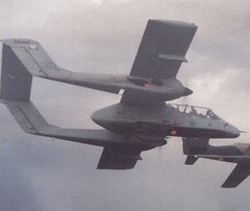
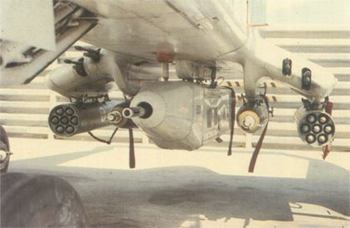
USMC Looks To Revive OV-10s For Use In IraqBy Joshua Kucera, JDW Staff Reporter, Washington, DCJane's Defence Weekly
April 12, 2006The U.S. marine corps is looking at the possibility of reviving the retired OV-10 Bronco observation aircraft for use in Iraq, according to a top service official.
The aircraft, which was retired from U.S. service in 1994, would be used to augment surveillance of roads in Iraq.
Having additional aircraft there could increase the chances of U.S. forces detecting the emplacement of roadside bombs or improvised explosive devices (IEDs), some service officials believe.
"If this is a capability we think that will take out the IED or help us catch the IED maker ... you bet [we are interested]," a senior marine commander told Jane's.
Service officials, with the help of an association of retired OV-10 pilots, have identified aircraft and pilots that could be used in Iraq, he said.
The marine corps Warfighting Laboratory has been tasked to examine the cost of such a plan and the concept of operations it might use, the commander added.
However, not all marine officials are enamoured with the idea.
Lieutenant General John Castellaw, the service's deputy commandant for aviation, told Jane's he thought the experience of the Gulf War showed that the aircraft was too vulnerable.
Marsh Aviation, which manages the inventory of the government-owned OV-10s and does upgrade work for international OV-10 customers, could remanufacture 10 or 12 of the aircraft suitable for military use by piecing together parts of various aircraft, said Floyd Stilwell, Marsh Aviation's chief executive officer.
The company could start delivering aircraft within 10 months at a normal production rate and faster if the government paid for it, Stilwell said.
The OV-10 proposal is one of many schemes - often secretive - to revive retired aircraft or convert civilian aircraft for use in operations in Iraq and elsewhere.
The U.S. Army has converted at least three Shorts 360-300 aircraft under the name Constant Hawk to do surveillance in Iraq and the sea lanes of the Middle East. Two of the aircraft collided with each other in Wisconsin in February shortly before they were to be sent to Iraq.
Mohawk Technologies of Florida has operated a fleet of six OV-1 Mohawk reconnaissance aircraft under a U.S. Department of Defense (DoD) contract for about 12 months, said Paul Pefley, the company's president. Pefley declined to say where the aircraft were being operated or for which branch of the DoD. The OV-1 was retired from U.S. Army use in 1996.
Most of the non-traditional aircraft plans, however, have gone nowhere and have been openly advocated only by a collection of veterans associations and a handful of members of Congress.
There is a growing constituency, however, of people who believe that Soldiers and marines in Iraq need better real-time intelligence and look back to the Vietnam-era [Airborne] Forward Air Controllers (FACs) as a model of how counterinsurgency can be fought from the air.
Those FACs were more tightly integrated with small units than the surveillance aircraft used today, and more effective, the Congressional staff member said.
"The air force is looking at all this, but very quietly," he said. "There's really a gap in combat information at a platoon commander, convoy leader level that is real and as real-time as you can hope to have it. We've got dozens of systems operating over there but there's a big logjam in the [intelligence] pipeline, and everyone knows it."
flightglobal.com/news/articles/boeing-considers-restarting-ov-10-production-after-23-year-321730/
Boeing considers restarting OV-10 production after 23-year hiatus
By: Stephen Trimble Washington D.C.
06:00 1 Feb 2009
Boeing is considering the possibility of restarting production of the OV-10 Bronco turboprop, a Vietnam-era, light attack and observation aircraft last produced in 1976.
The company confirms that the OV-10 could be offered as either a light attack or intra-theatre light cargo aircraft for the US Air Force. The international market is also driving interest in the slow-flying aircraft, which blends some of the observational capabilities of a helicopter with the range of a fixed-wing aircraft.
Boeing has cited recent USAF interest in acquiring a light attack aircraft as a possible reason to revive OV-10 production.
Although known for its surveillance prowess, the OV-10 remains in combat service in four countries: Colombia, Indonesia, the Philippines and Venezuela, with a weapons load at least equivalent to the Bell AH-1 Cobra attack helicopter. Some of those countries, and perhaps new customers, could seek remanufactured or new production OV-10s as their current fleets wear out.
So far, the USAF has not decided whether to buy a light attack fleet, known as the OA-X. But the Air National Guard will experiment later this year with the Beechcraft AT-6 Texan II. The USAF is also buying dozens of AT-6s on behalf of the Iraqi air force. The Embraer EMB-314 Super Tucano and U.S. Aircraft A-67 Dragon are also candidates for an OA-X order.
If the OA-X opportunity stalls, Boeing believes there could be interest in reviving the OV-10 as an intra-theatre transport for moving small groups of troops or medical services around the battlefield.
Boeing notes that the OV-10 revival idea is very preliminary. However, the company has created a marketing brochure, which has been circulated at defence industry events.
Unmanned air systems are being increasingly augmented by piloted aircraft for the persistent intelligence surveillance reconnaissance mission. The U.S. Army and U.S. marine corps have adapted the Shorts C-23B Sherpa with a wide-area surveillance sensor, and the USAF will deploy 37 MC-12W Project Liberty aircraft - modified Beechcraft King Air 350/350ERs, to augment unmanned operations.
The OV-10 has been considered for a similar role for several years. The Department of Defense contacted John Hodgson, president of the OV-10 Bronco Association, a few years ago to inquire about fleet availability.
Hodgson is not surprised by the rising interest in the observation platform. "It doesn't make any difference how good your UAV is," he says. "Nothing replaces a couple of eyeballs on a head that moves around."
INITIATIVE: U.S. Army Lieutenant creates STOL Grasshopper Aviation on his own to help win WW2
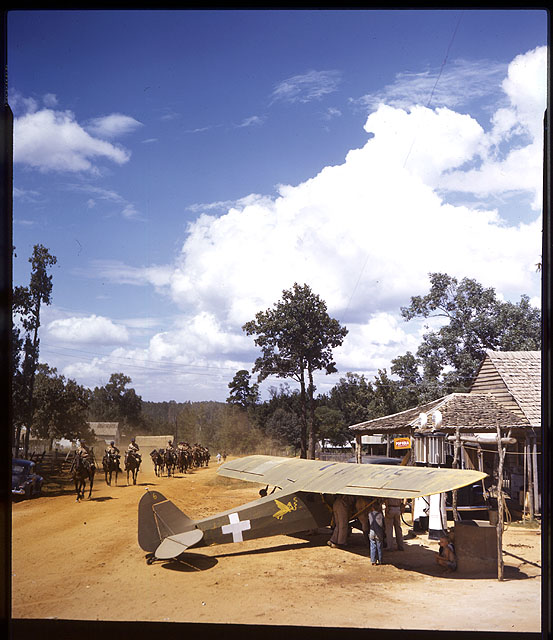
We have long known the vulnerability of wheeled trucks along roads; here's a picture from 1930s maneuvers...
The U.S. Army Aviation Museum, U.S. Army Aviation booklet on pages 6-7, 1993 Fort Rucker, Alabama states:
"In the summer of 1940, Lt. J. McCord Watson, Jr., called the Piper Aircraft Corporation to discuss the concept of using light aircraft to adjust Army artillery fire. The lieutenant had been working since 1937 with J-3 'Cubs'" rented from the local airport. On August 12, as agreed to, Piper representative Tom Case demonstrated a J-4 "Cub" at Camp Beauregard, Louisiana. The impressive results left no doubt as to the proposal's merit.By the summer of 1941, two-way radios were in use and manufacturers had provided 12 planes for demonstrations. The list included Interstate and Rearwin as well as Piper, Aeronca and Taylorcraft. Dubbed "Grasshoppers" by a senior officer as he watched a hapless candidate bounce unmercifully across one of the "boon dock" airstrips at Ft. Bliss, Texas, the tube and fabric squadron promptly won converts. Proposals to incorporate light aircraft into the Army were made on three occasions; however, each was met with orders for additional field trials.
On December 10, 1941, instructions were given to test out the theory at a Division level. Twenty-four J-3s were painted olive drab, marked with white crosses and sent along with 9 pilot instructors, 14 officers and 21 enlisted pilots to participate in the field maneuvers at Camp Beauregard.
The exercise made the point and on June 6, 1942, the orders for an organic air observation section to serve with the Field Artillery were finally issued."
armyavnmuseum.org/history/war/ww2/overview.html
Organic Army Aviation in World War IIMost of us would agree that the U.S. Army in WW2, particularly Patton's 3rd Army had Maneuver Air Support (MAS) via liaison "grasshopper" planes with Airborne Forward Air Controller (AFAC) observers inside, ground forward air controllers (GFACs) in tanks backed by P-47 Thunderbolt fighter-bomber planes.This article, written by Dr. John W. Kitchens, Aviation Branch Command Historian, U.S. Army Aviation Center, Fort Rucker, Alabama, was originally published in Army Aviation Digest in two parts, May/June and June/July 1992.
---------------------------------------------------------
On 6 June 1942, the secretary of war ordered the establishment of organic air observation for Field Artillery. Through companion memoranda sent to the commanding generals of the Army Air Forces (AAF) and the Army Ground Forces (AGF), the War Department issued specific instructions for organizing organic air observation. It also provided guidelines for relations between the AAF and this new air arm of the AGF.
For example, the air forces were to supply the ground forces with small one-engine planes, called "liaison-type airplanes," and spare parts. The air forces also were responsible for all third echelon aviation maintenance in the Army, basic flight training, and rating the student pilots "according to standards established for liaison pilots."
Organic air observation in Field Artillery was intended not to replace, but rather "to supplement the AAF's responsibility for aerial adjustment of artillery fire" from high-performance aircraft. The order of 6 June authorized two organic aircraft for each artillery battalion and two for each brigade, division, and group artillery headquarters, without affecting existing obligations of the AAF.
The establishment of organic Army Aviation in June 1942 complied with a recommendation from the office of the commanding general of the AGF. This recommendation followed a series of tests and experiments that had demonstrated the efficacy of organic aircraft for Field Artillery units.
The AAF of the World War II (WWII) period had evolved from the 19th century Balloon Corps, the Army Air Services of the WWI era, and the Army Air Corps of the 1920s and 1930s. The history of the U.S. Army's air arm from the Civil War era until 6 June 1942 is the common heritage of both the Aviation Branch of the Army and the U.S. Air Force (USAF).
After the birth of organic Army Aviation in 1942, the evolutionary path of the future Aviation Branch of the Army diverged from that of the future USAF.
During WWII, and until the establishment of the USAF in 1947, however, the large and powerful AAF and the minuscule new air arm of the AGF were both parts of the Army. Even during these early years, they often competed for resources and mission assignments.
The Louisiana Maneuvers
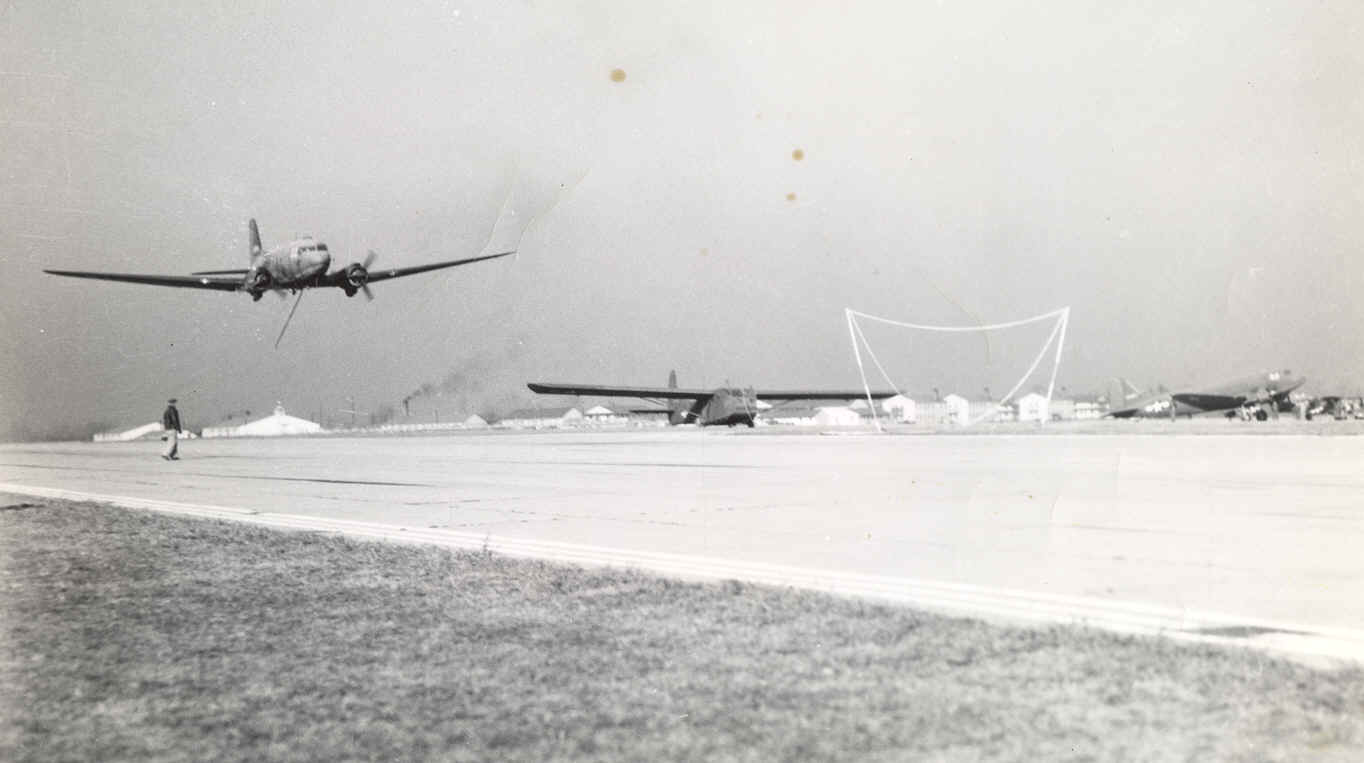
One of the many innovations pioneered by the Grasshopper reformers was non-electromagnetic message pick-up which even developed into live human pick-up capability! Who needs to land, anyway?The movement in the AGF that was to result in establishing a new Army air arm began around 1940. Joseph McCord Watson, Jr., a young artillery officer, had been experimenting with the concept of artillery fire adjustment from small aircraft.
In 1940, he requested that the Piper Aircraft Corporation furnish two Piper Cubs to experiment with fire adjustment during Army maneuvers. These experiments, conducted at Camp Beauregard, LA, in August 1940, proved successful notwithstanding the absence of radios in the aircraft.
In the fall of 1940, Major General (MG) Robert M. Danford, the chief of Field Artillery, and other artillery officers became interested in further testing the organic spotter-plane concept.
They were motivated by two major factors. First, Air Corps planes were not always available to provide artillery spotter support when needed. Secondly, some artillerymen were coming to believe that lightweight aircraft, piloted by artillery officers and dependent on ground commanders, could do a better job. Interest in the concept of using small organic aircraft for fire adjustment became more widespread as a result of an article by Major (MAJ) William W. Ford, "Wings for Santa Barbara." The article was published in the Field Artillery Journal in April 1941.
Army General Headquarters conducted maneuvers in Louisiana, Tennessee, Texas, and the Carolinas in 1941. Three light aircraft manufacturers, Piper, Taylorcraft, and Aeronca, placed 11 planes at the disposal of the Army during the maneuvers.
These cub-type planes, mostly Piper J-3s, flown by civilian pilots were tested for artillery spotting as well as for courier service and other liaison roles.
During the maneuvers, these 11 "Grasshoppers," as they were named by MG Innis P. Swift, commanding general, 1st Cavalry Division, flew about 400,000 miles in some 3,000 missions.
In comparison to the larger air forces planes, the Grasshoppers cost much less, could take off and land on almost any level surface, and could maintain much more effective contact with the ground units that they supported.
Furthermore, according to General Danford, the "only uniformly satisfactory report of air observation during the maneuvers... [came] from those artillery units where...light commercial planes operated by civilian pilots were used."
After the 1941 maneuvers, General Danford renewed his efforts to obtain War Department permission to conduct formal tests of light aircraft organic to Field Artillery units. On 8 December 1941, the day after the Japanese attack on Pearl Harbor, a War Department memorandum authorized Field Artillery to proceed with the proposed tests and directed the AAF to make 28 YO-59 (Piper J-3 or Piper Cub) aircraft available to Field Artillery as soon as practicable.
With the new liaison "L" classification introduced on 2 April 1942, the YO-59 became the L-4, the aircraft most widely used by organic Army Aviation during WWII. The AGF also used a few L-2 Taylorcraft and L-3 Aeroncas, but they were far less satisfactory.
Grasshoppers for Small Unit Insertions/Extractions
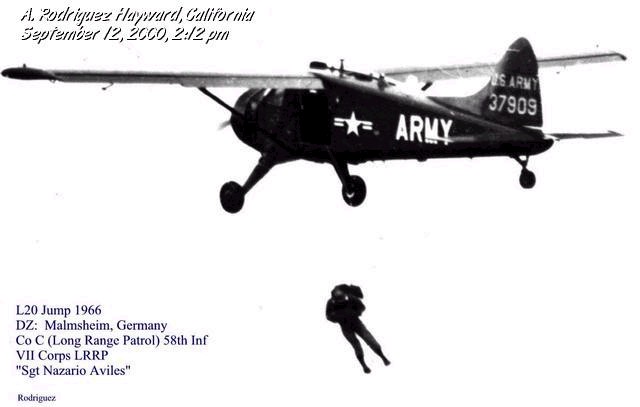
In the Pacific L-4 Piper Cubs were actually used to drop 11th Airborne Division paratroopers to take positions on Tagaytay Ridge and Patton considered using his Grasshoppers to do the same to get a crossing over the Rhine river. The 6th Ranger Battalion "Alamo Scouts" on the Philippines used STOL aircraft to insert/extract teams during WW2. The 11th Airborne dropped paratroopers one-at-a-time during Operation TABLE TOP in the Philippines....this is an important precedent to have if we can get the Army to have light, fixed-wing STOL aircraft again, to do small recon or combat team insertions without having to go beg the USAF to risk its ass. The Army used to have this capability from its own organic STOL fixed-wing aircraft like the U-6 Beaver.
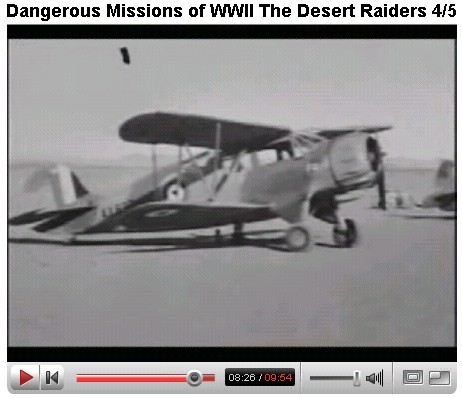
Other armies like the British SAS/Long Range Desert Group and Rhodesians used light STOL aircraft to move around their teams. A STOL Twin Otter was flown into the Iranian desert to survey the infamous "Desert One" landing site in 1980.
Where were the Grasshoppers at Arnhem?
One of the whines of the Arnhem post-mortem excuse-mongers is that the 1st British Airborne Division had a break-down in radio communication and couldn't coordinate their actions. This again shows inexcusable INCOMPETENCE on the part of Generals Browning/Urquart.
The British Army had Lysander liaison planes available that could STOL land to relay messages or if they couldn't land they could drop and pick-up messages. Lysanders could have easily landed and took-off from any of the British drop or glider landing zones. Browning/Urquart should have had Lysanders ready to resume communications if radios failed and then they could have shifted their 1st and 3rd battalions to take the water's edge route to reach Arnhem bridge to reinforce Frost, and flown all the way back to England if necessary to shift where the resupply drops were taking place to land where their new defensive perimeter was at Osterbeek. The Lysanders could have acted as radio relay aircraft and even dropped ammunition to Frost's men directly.
Again this is all yet another example of the lack of flexibility on the part of Britain's WW1 mentality linear war Generals who persecuted the non-linear mechanized war Generals from the ranks; General Percy Hobart etc. so by the time WW2 began even Churchill couldn't fire enough of them to find someone competent. Hobart had constantly used liaison aircraft during WW1 to achieve battlefield C2 and was a huge proponent of actions on the ground backed by close air support (CAS) attack aircraft. Had Hobart been running the Arnhem battle, he would have insured Typhoon fighter-bombers were on-call to the 1st and 3rd battalions who were stopped on the way to the bridge by using Lysanders as radio relay planes probably with himself inside ascertaining that his men were being blocked from the bridge--just like LTC John Paul Vann did overhead in an O-1 Bird Dog at the battle of Ap Bac in 1963, and Rommel (Storch)/Patton (L-4 Piper Cub) did during WW2.
 youtube.com/watch?v=CRYCx_G25ro
youtube.com/watch?v=CRYCx_G25ro
Flying Exhibition Today
 youtube.com/watch?v=MGVebC2SJsM
youtube.com/watch?v=MGVebC2SJsM
When U.S. Army Air & Ground Forces worked directly without bureaucracy & ego
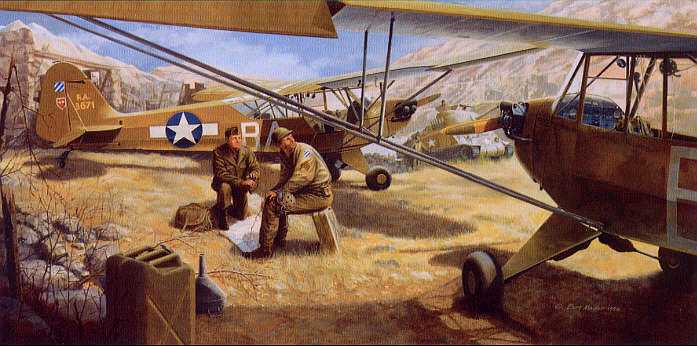
Burt Mader's beautiful painting "Maytag Messerschmits" shows a scene from 1943 Italy; A.W. Schultz, an artillery spotter (note 3rd Infantry Division "fuzzy TV set" patch) pilot of a Piper L-4 confers with an enlisted tank commander at a temporary field en route to Cassino. $95 Call (800) 731-0060, size 28 x 13-3/4; Military Aviation Art
"Once the division deployed to exploit a breakthrough, it moved out with two combat commands abreast and one in reserve. Each combat command contained two separate task forces, moving as much in parallel as the contours of the land would permit. The front of a heavy armored division could vary in width from several hundred yards up to twenty miles depending upon the terrain. During daylight hours, each task force had available four P-47 fighter-bombers under the direct control of an air force liaison officer who rode in the lead half track with the task force commander"
--Death Traps: the Survival of an American Armored Division in WW2, page 345 by Belton Cooper
Many of these pilots were enlistedmen like Staff Sergeants (SSG) James Stegall and Ernest (later Lieutenant) Kowalik. Enlisted pilots would stop this snobby non-sense that only college boys and officers can fly and instead inject some get-the-job-done, common sense into the ranks of Army Aviation. Many smart NATO countries have enlisted pilots. Ground-Mobile and co-located liaison aircraft is actually old German Army idea, began in the 1930s with the Fieseler Fi-156 "Storch" the world's first STOL aircraft.
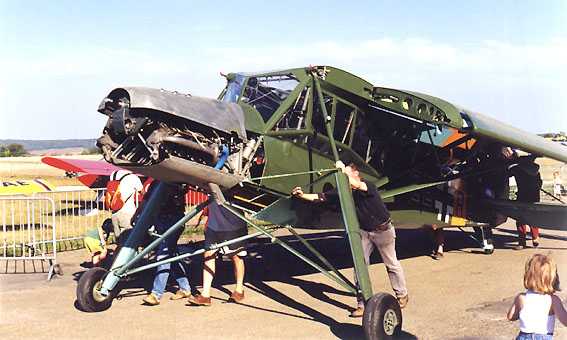
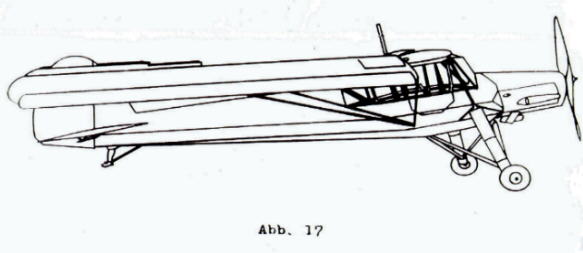
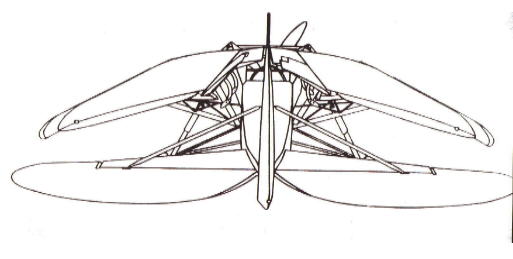
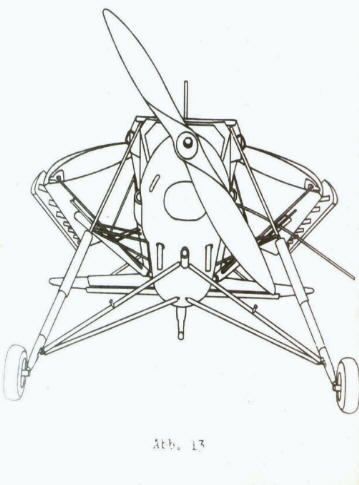
 youtube.com/watch?v=ZvfKT97Ft70
youtube.com/watch?v=ZvfKT97Ft70
The Germans were the first people to realize an Army liaison aircraft has to be simple to operate and maintain (fixed-wing) yet be able to land almost anywhere (STOL) and thanks to brilliant designer and WWI ace Fieseler, the Fi-156 "Storch" was born.
http://rwebs.net/dispatch/output.asp?ArticleID=12 reports:
"The Fi-156 Storch, as the design was quickly dubbed, could fly as slow as 32 mph, take off into a light wind in less than 150 feet and regularly land in 50 to 60 feet, less than twice its length. Its wings could be folded back along the fuselage, allowing it to be carried on a trailer or even tugged behind a vehicle."
Some Storches were fitted with skis to land in snow or extra tires to lower ground pressure:
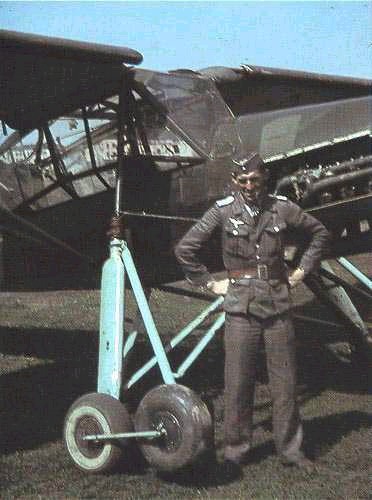
VIDEO: Today's STOL Descendants of the Storch and Cub in Action
 youtube.com/watch?v=OWDEYpqS0yw
youtube.com/watch?v=OWDEYpqS0yw
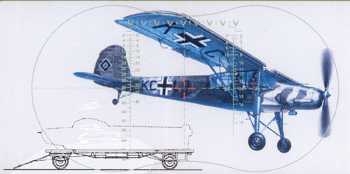
Storch and its trailer
Storch & the "Desert Fox", Field Marshall Erwin Rommel
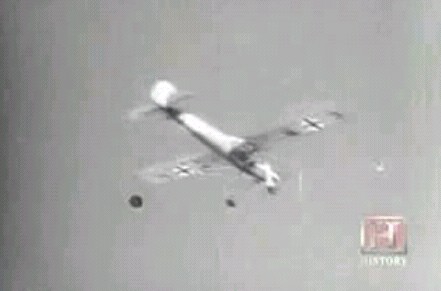
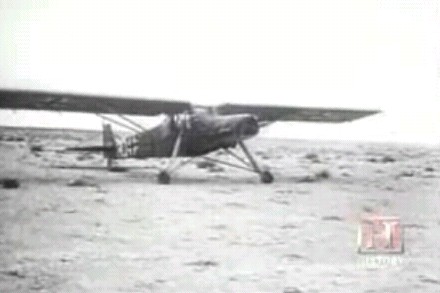
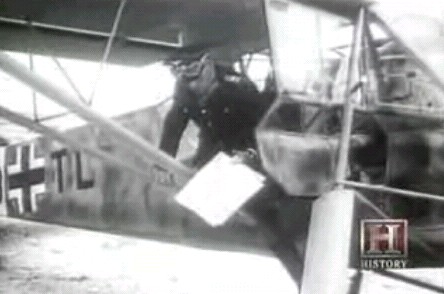
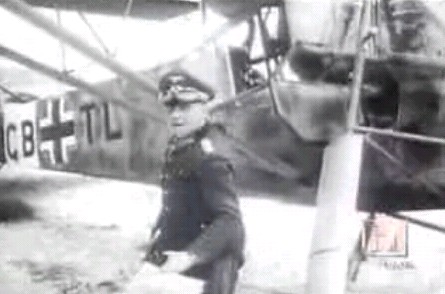
Storch STOL Special Operations: Rescue Mussolini @ Gran Sasso!
 youtube.com/watch?v=g-1doalaeGs
youtube.com/watch?v=g-1doalaeGs
Fortunately back then, the American Army had some smart, humble, competent and courageous people; who when they saw the Storch realized we needed our own STOL liaison aircraft and obtained thousands. U.S. "Grasshoppers" could land anywhere and could have their wings detached and placed on the back of trucks if they couldn't fly there. We had MAS.
Legendary Grasshopper pilot, SSG Jim Stegall writes about co-location:
For the next five days or so our unit pushed forward with heavy resistance in most areas. I adjusted fire on various targets like troop formations, like tanks vehicles or anything that we could find. On about the fifth or sixth day in the late afternoon, we were using an open field as our landing strip that was right next to my unit, the 155th Field Artillery Battalion. Other aviation units were also using the field that day."
For the Next Five Days After Landing at Salerno
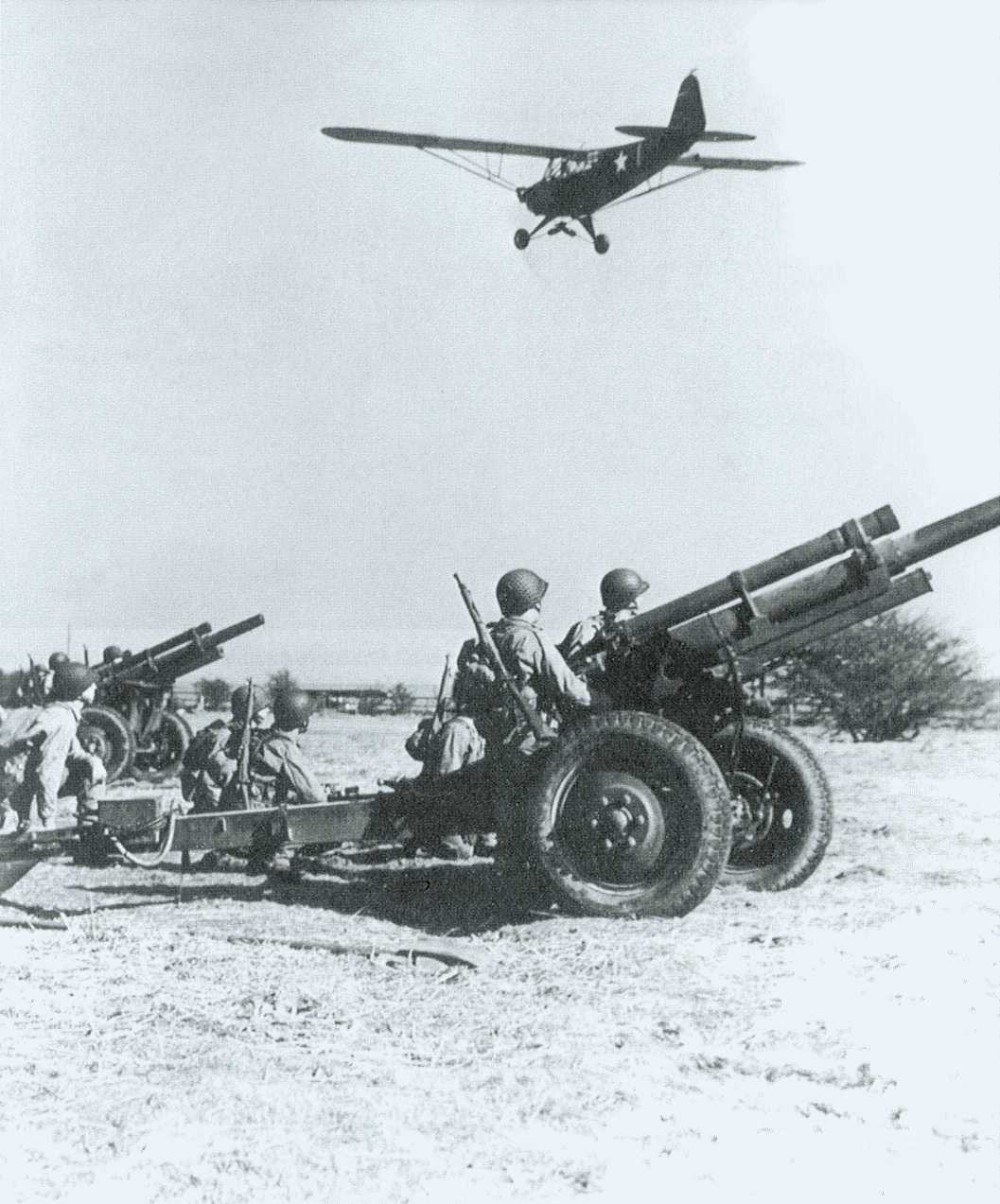
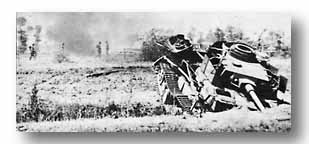
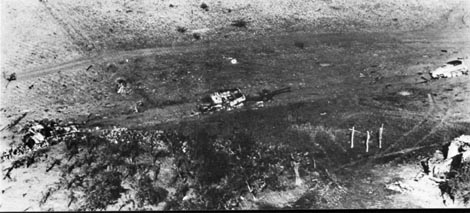
Grasshopper & Field Artillery interface = a deadly combination for the Axis enemy! Above is a German armored column destroyed by Grasshopper air observation and control of artillery fires; note the destroyed Panzer IV light tank. Jim Stegall called in artillery fire onto this enemy armored column 5 miles from the Salerno beachhead.
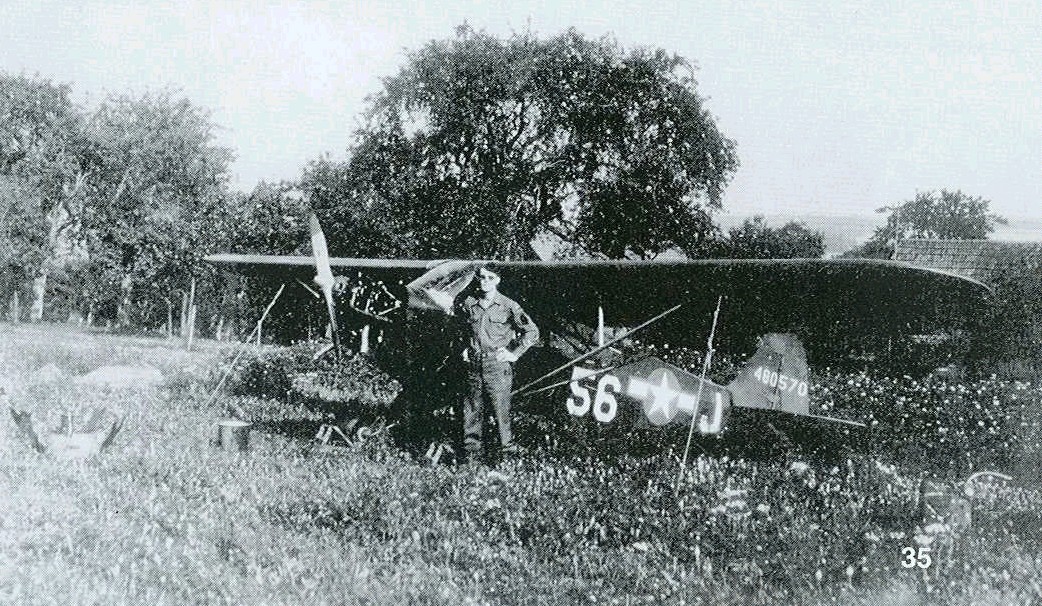
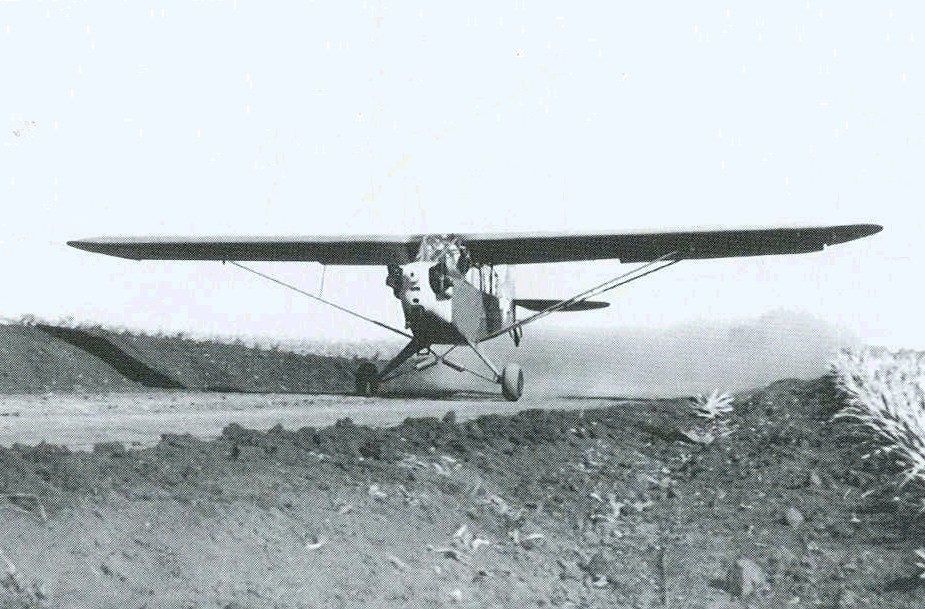
Grasshoppers could take-off and land anywhere...trails...grassy field...in rain, snow, mud...Army Grasshoppers flew off Army landing ships tank
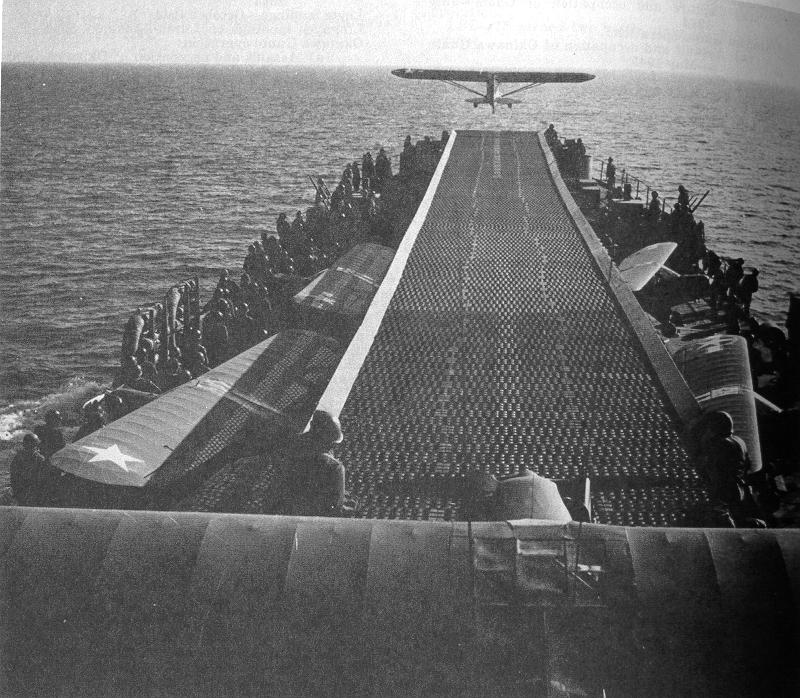
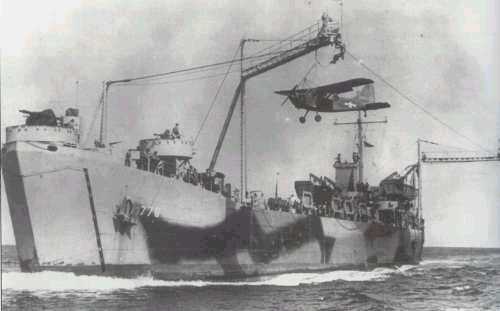
history.navy.mil/danfs/l16/lst-386.htm
An Army Piper L-4 Cub artillery observation Short Take-Off and Landing (STOL) plane takes off from an LST at Anzio, 1944. LST-386 had an improvised "flight deck" installed in 1943 and flew off four such planes during the landing on Sicily. Later LST modifications, like this one, could carry up to 10 planes and supported the Anzio landing and the invasion of southern France. During 1944, LST-776 evaluated an experimental catapult for launching light planes, as well as Brodie gear. In this system, a cable was stretched between booms to one side of the ship, and planes were launched from a quick-release trolley. LST-776 operated marine OY-1's over Iwo Jima and Army L-4's at Okinawa.
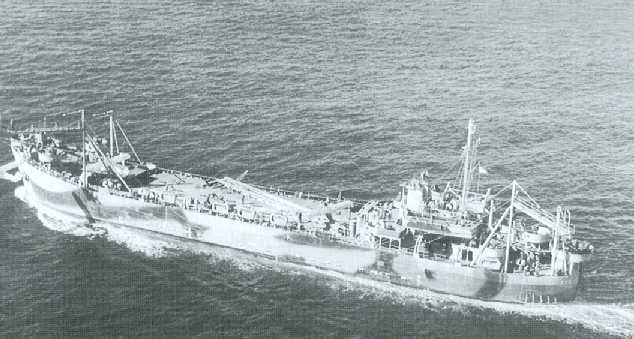
Grasshoppers took off from aircraft carriers (North Africa landings) and even from amphibious cargo ships (see above)! By WW2's end they had the fabulous "Brodie" system and catapults to launch & recover Grasshoppers for amphibious assault/seabasing.
militaryhistoryonline.com/wwii/articles/secretweapon.aspx
The Secret Weapon of the Pacific War
by Irwin J. Kappes
Well, strictly speaking, it's not quite "a secret weapon". Actually, there were two, not counting the ultra-secret atomic bomb. And both were unlikely candidates for the title. One was a jerry-built, rickety-looking device and the other was its opposite-a massive, utilitarian monster. In fact, neither was a "weapon" either, though their effects were very lethal. Confused? Obviously, this all requires a bit of explanation.
The first was the so-called Brodie device, an inexpensive but ingenious contraption invented by Captain James H. Brodie of the USAAF Transportation Corps during the early days of World War II. It enabled the takeoff of aircraft without benefit of a runway. This was important for the Army because there were many situations such as mountainous areas, swamps and jungles in which construction of an airstrip would have been impossible. Secondly, such take-off ability was often needed instantaneously and the success of an engagement with the enemy could depend on it. For the Navy, aircraft carriers were not always readily available when and where needed-for example during the Battle of the Atlantic when U.S. merchant shipping was suffering huge losses to Nazi submarines.
General A.D. Bruce, commander of the 77th Infantry Division summed it all up neatly: "The secret weapons of the South Pacific War were the [Brodie-equipped] Piper Cub L-4 and the bulldozer." The former could serve not only as reconnaissance planes, but to direct artillery fire from afar and could be launched from an LST (Landing Ship Tank). Moreover, they could do it with relative impunity because the enemy knew that firing on them would reveal the position of their artillery which would result in an immediate rain of incoming fire. It is no exaggeration to say that the enemy feared the Piper Cub more than they did the Mustang. This, despite the fact that the Cub's top speed was only 85 mph.
On the other hand, earthbound, clunky bulldozers were vital for clearing jungle areas and building an airfield in a matter of hours. Using their slave labor it would take the Japanese weeks and months to do the same thing. This often made the difference between success and stalemate. These two "weapons", un-sexy as they admittedly were, separately but sometimes in tandem, made an important contribution to the outcome of the Pacific War.
We know how the bulldozer worked, but the Brodie device requires a bit of explanation. A complete Brodie rig weighed less than 7,000 pounds and was highly portable. It consisted of two 65 ft. tubular steel masts, each with a 50 ft. arm protruding from each mast and extending out over the LST's port side. Stretched between the arms was a trolley cable that supported the Piper Cub from a hook mounted on its fuselage. The forward arm was in the "10 o'clock" position while the aft arm was at "9 o'clock". This provided additional lift in the take-off. Starting the launch aft, the Cub would rev the engine up to full speed while restrained in place by a friction brake. When the "launch" order was given, the Cub would be released, speed down almost the full length of the cable and the pilot would then yank the lanyard to disengage from the trolley and fly free. Landing was a little trickier. Shackled to the trolley was a landing sling consisting of three loops of nylon rope forming a rectangle 3 feet wide by 4 feet long. The pilot had only to engage one of the loops within the rectangle to be plucked out of the air and make a successful retrieval.
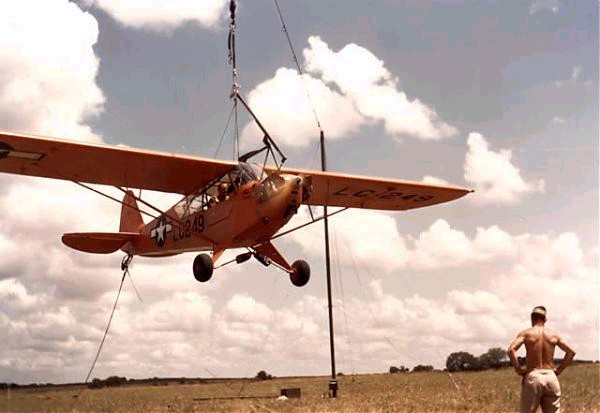
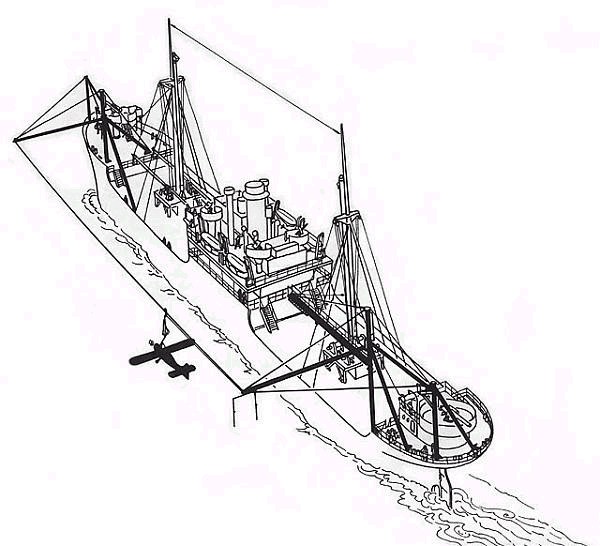
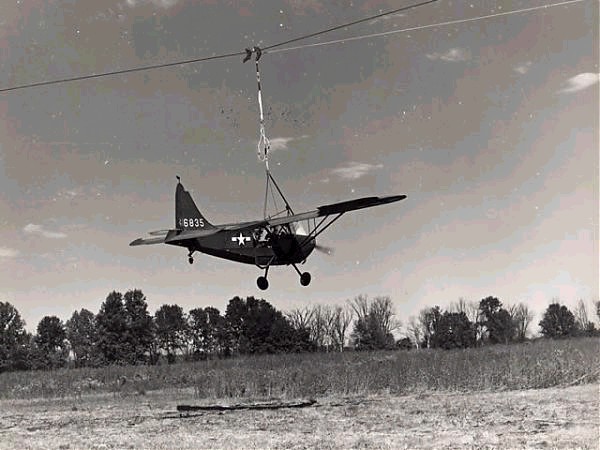
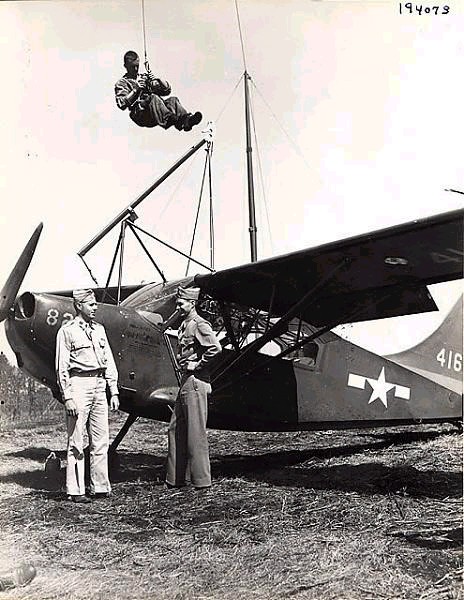
When the Brodie rig was under development in New Orleans, volunteer pilots eagerly lined up to participate, sight unseen. But it only took one look at the awkward rig and slender wire for most of the candidates to politely back out. In one case, the bravest of the brave pilots were practicing flying off the hook on an LST, circling the ship and then re-attaching as if rehearsing a circus trapeze act. They were noticed by the crew of a carrier just off their port beam. From the carrier came the message, "We see it, but we don't believe it."
One of the ace liaison pilots of the Pacific War was John C. Kriegsman who at the time was stationed with the Army's 77th Division on Leyte in the Philippines. After war's end he testified; "Through rumors and the grapevine, we found we were to secure a group of islands. It developed that they were near Okinawa, wherever that was. About that time we were issued two of the craziest-looking hooks we had ever seen on any aircraft. Along with the hooks were instructions how and where they were to be mounted on our Cubs. Mystery was the order of the day. We figured we were to hook something but did not know what.
Somehow, word came that we were to operate off an LST ship, of all things. A Navy Commander was to arrive on a transport ship to explain how the hooks were to be used. Several days passed and the transport finally arrived. The Commander was extremely vague. He was unable to supply a picture or even a sketch to explain how the LST was fitted to hook a Cub, or why it was necessary in the first place. He did say the LST was used for this purpose at Iwo Jima by the marines. [On D-Day plus 10 at Iwo Jima, LST-776 launched 4 Piper Cub L-4 spotter planes but lost one over the side].
LST-776, with a Brodie device mounted on its deck, did arrive late in the day before the convoy was to leave. The crew told us how the device worked, and what we were expected to do to get our two Cubs back on board without damaging them. Next day the convoy assembled early to move out for the Kerama Retto Islands. They were a small group of rocky mountainous islands with no beaches. With the convoy under way, we were the show of the day. All eyes and field glasses were on us as we gingerly flew around the LST valiantly trying to hook the 3' by 4' loop. From the curve of the hook to the top of the propeller we had about 20 inches to 'play' with. I managed in five passes.
When a plane was to land, the LST would be turned into the wind, and at full speed. The LST had little or no keel. As a result, the ship would roll gently. This means that those 50-foot arms over the side would make an arc maybe 30-feet high. The pilot would approach this loop in sort of a porpoise fashion. It was necessary for the pilot to get the rhythm of the ship as he made his approach, so that when he hooked-or God forbid, missed-the loop, the arm would not come crashing down on him.
Cubs were tail-draggers. When a pilot made a 3-point landing, he pulled the joy stick into his belly. It was as natural as pulling on one's trousers. Not so when you hooked the loop. You had to remember to jam the stick ahead at the slightest tug indicating that you were hooked to the loop. That kept the nose down so the prop would not go up into the cable and get all chewed to pieces.
Probably the worst thing that could happen was to think you were hooked when you were not, and you jammed the stick forward. Diving 30 feet straight down could make for a big problem. The [tolerances] were so close that extreme concentration was required.
After Okinawa, the 77th Division returned to Cebu Island in the central Philippines for an R & R and preparation for the next operation, which was to be the BIG ONE! A meeting was held in Manila for an evaluation of LST-776 with the Brodie device [known to its sailors as the 'U.S.S. BRODIE]'" for the invasion of the Japanese mainland. It was determined that it would be the perfect solution for air reconnaissance of the Kyushu defenses. The device proved its significance at Iwo Jima, Saipan and Okinawa but only eight of 25 contracted LSTs were Brodie-equipped when the war ended. In 1945, Brodie was awarded the Legion of Merit medal. But the story doesn't end there. Brodie envisioned even more significant peacetime uses for his invention: He foresaw light cargo routes and mail delivery/pickup in desolate areas such as the Arctic region, using his rigs to reduce the amount of fuel spent between landings. By decreasing the gas load, planes would increase the payload proportionately. And private individuals in the bush would set up their own airports in wooded or rolling back country. While practical and proven in wartime, the Brodie device has never found an important peacetime application-at least, not yet."
Through the years, the fabled but ungainly LST amphibious landing craft found several applications beyond its original purpose of landing equipment and personnel. A few were given a landing deck and made into "pocket aircraft carriers", others were converted into barracks ships, and one, the USS Garrett County, (LST-786) was made into a helicopter "mother ship" during the Vietnam War. Her unobstructed flat deck made her an ideal landing platform for several medium helicopters. A testimony to the LST's versatility is the fact that the basic design, with modifications, was followed from World War II through August of 1972-an unprecedented lifespan for a type of naval vessel. A total of 1,052 were built for the war and 146 in the postwar period. Many were transferred to foreign countries and some continue to serve various commercial purposes even today.
Written by Irwin Kappes. If you have questions or comments on this article, please contact Irwin Kappes at: t5016m@hotmail.com.
About the author:
Mr. Kappes served in U.S. Navy on destroyers in the Atlantic and Pacific during WWII. He holds an MBA from Boston University and retired after a 32 year advertising career with the Du Pont Company. He was also a retired Vice President with United States Hosiery. He is married and his hobbies include painting, writing, and travel. His hometown is New Castle, PA. and presently living in Tinton Falls, NJ.
Published online: 01/26/2006.
A L-19/O-1 Bird Dog combat pilot from Vietnam writes:
"Mike,
Great find on the Brodie rig picture.
The L-4 was used with this equipment during the invasion of New Caledonia in 1942 for three months. The guy in the bosun's chair is the crew chief who not only made sure that the pulleys were correct, on the L-4, he started the engine by propping it and then getting out of the way.
The amazing thing about the Brodie rig is that they not only launched the aircraft from the ship, they also recovered them on the cable while underway!
The stall speed on the L-4 was about 28 knots.
The ship could do 18, so all they had to do was find a 15 knot breeze, and the pilot would come in under the cable from the stern, fly the pulley onto the cable, and cut the throttle. He then had a brake handle on the pulley that would stop the airplane on the wire. He had to push the stick full forward to keep the prop out of the cable and cut the mixture to kill the engine.
The crew chief would then be swung out in his bosun's chair and attach the hook to the airplane and get it back on the deck for crew recovery and servicing.
The Museum at Ft. Rucker has a lot of information about these guys.
The picture you linked up is showing an L-5, probably during a test. The L-5 was a lot bigger airplane, but it had slots and slats so it could fly slow as well.
With the advent of captured airfields as the war progressed, this system was not used much after 1943."
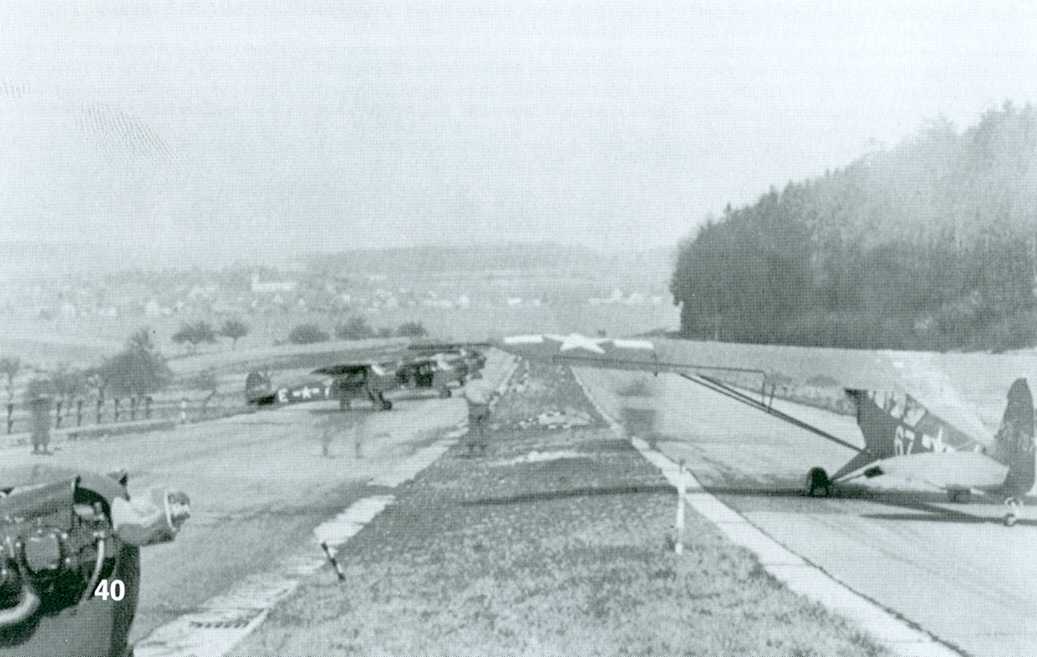
...and of course any small stretch of road...
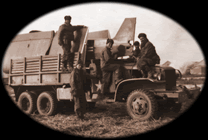
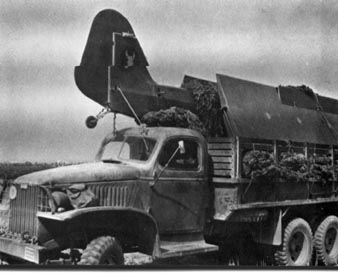

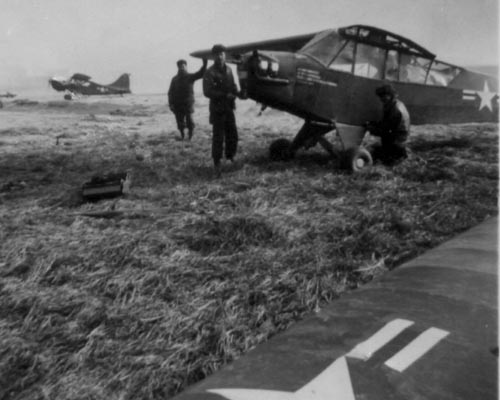
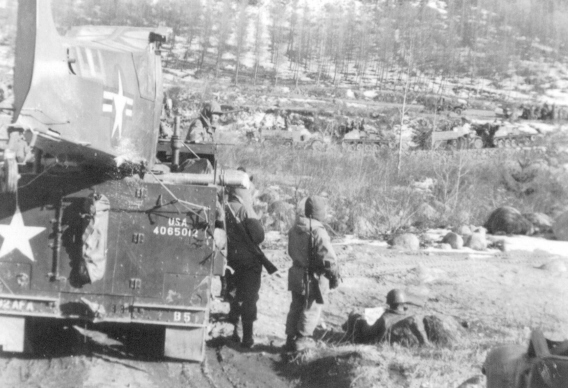
If they couldn't fly they could be TRUCKED! Most Grasshoppers wings could be detached others like the Convair L-13 had their wings fold like the Storch.
SSG Jim Stegall's Grasshopper came by truck rolling off a ship onto Salerno beachhead:
http://homepage.mac.com/ravnhaus/Stegall/salerno.html
EXCERPT:
"Next the division was ordered to Arzew which was a staging area near Oran. The whole division was there to prepare our equipment for an assault by sea and then to load on ships. I was assigned a 2 1/2 ton truck which would carry my L-4 onto the beach - wherever that might be. So, as the driver, I was to prepare the truck for underwater operation. Loud speakers blared out instructions by the numbers. We had a heavy grease mixed with asbestos which we put on spark plugs, wires, carburetors, ect. You can bet that I followed instructions. Wings were removed and lashed on the sides, the fuselage was rolled backward into the bed of the truck with the tail over the cab and was lashed down. Ready to go!
D-Day at Salerno
August 1943
After preparing for an amphibious landing, the 36th Infantry Division loaded on ships in the Arzew and Oran area of North Africa. My 2.5 ton truck carrying my L-4 observation plane was loaded on an AKA ship. This was a freighter and troop ship combined. I'm not sure what the AKA meant but the U.S. Navy which manned this ship called it an assault kargo (cargo). The Navy seems to like those K's. My truck and plane were lowered by crane down to the third or fourth level well below the waterline. I was assigned a bunk near the galley which was quite comfortable. A convoy of ships was formed of twenty or more ships with a destroyer or two or more and smaller mine sweepers and anti-submarine ships protecting the convoy.
The convoy sailed around in the Mediterranean for about two weeks. It was uneventful until about a week and a half had passed. The loud speaker on the ship announced that Italy had capitulated. This was met with mixed emotions by the troops on board. We were glad for the seeming victory but we grumbled about being deprived of the expected combat experience. Little did we know!
A day or so later the combat operation was revealed to us. We were to make an assault at Salerno, Italy. It was to be made primarily by the 36th Division with supporting units on September 9, l943. The night before the landing everyone was making preparations for the landing. One of the Navy enlisted men told me "I'm glad it's you going ashore and not me. We'll be comfortable on the ship and in our bunks while you guys will be digging in the dirt!". This is not an exact quote but is basically what he said. My only retort was something like "Well, I never did want to drown on a tub like this". Again, not an exact quote but close.
Dawn came on D-Day. The infantry had landed before dawn and had met stiff resistance. The Germans were waiting for us and the battle was on. So much for our worries of not seeing any combat. Ships were lined up away from the harbor. LST's' were being loaded and sent ashore. It was a busy scene. Troops, trucks, tanks and all manner of equipment were along the shore with smaller boats coming and going. A destroyer was out in the bay firing salvos into the mainland. On our ship LST's were coming alongside and the cranes would let down tanks, trucks, half tracks etc. Into the small landing craft. Troops went over the side on a rope net and into the LST's. All the while there was tremendous activity out in the harbor, on land, and fighter aircraft in the air.
My turn came about mid afternoon. The LST alongside was first loaded with tanks, half tracks and trucks. My truck was loaded near the front with a half track in front of me right in the mouth facing the ramp. He would be first off. I would be second. All loaded we headed for the shore. By this time it was a bee hive of activity. The infantry had moved on inland and beaches was secure for reinforcements and supplies. However, one of the beaches, maybe Red Beach, was never secured. As we neared the beach the LST ran up on the sand in about five feet of water. The ramp went down and off went the half track in front of me. I saw that he dropped off quite sharply but being a track vehicle it was no problem. As I came to the end of the ramp my front wheels dropped off into about five feet of water. I continued down the ramp but as the back wheels dropped off the ramp, the rear bumpers hung up on the end of the ramp. Being in front wheel drive the front wheels were spinning and digging into the sand. By then water was about waist high as I sat in the cab. I shut off the engine as the truck was only digging deeper in the sand. I jumped out into the water, waded ashore and hailed a caterpillar tractor manned by a G.I., probably from an Engineer Unit. He gave me a cable and I waded back to my truck and hooked the cable on my front bumper. All the while the tanks, half tracks and other vehicles seemingly waited patiently until I was dragged ashore. They then streamed out of the craft going around me on the beach.
I suppose I thanked the caterpillar driver or at least waved at him. I am not sure which. At any rate I owe him a lot. Safely on the beach, I turned on the key and the engine started! Evidently I had done a good job of waterproofing my vehicle. I joined my unit just off the beach where we spent the night. It was like the "Fourth of July"--but it lasted all night. Destroyers firing from the harbor, tracers in the air, sound of automatic gunfire, artillery outgoing and incoming, planes overhead. But for us we were just waiting until daylight to off load our planes and re assemble them. This was completed by about eleven O'clock on D+1.
I took to the air not really knowing what to expect. I found out pretty quick! Flying at about 500 feet I was passing over a wooded area. I was hearing a faint noise like cheap firecrackers and little winks of light were coming through the trees. I radioed my fire direction center and told them "I believe they're firing at me!" I was such a rookie. Fire direction radioed back "lets put some fire on this area. Give us coordinates". I adjusted fire on the wooded area and 'fired for effect' meaning several batteries firing at once. We pounded the area pretty well and then I went on to seek enemy targets. Later that day the fire direction center called me and told me the infantry had moved through that area and found many German dead along with some trucks and equipment destroyed. My first combat action was more luck than skill. As they say, I'll take that any day!
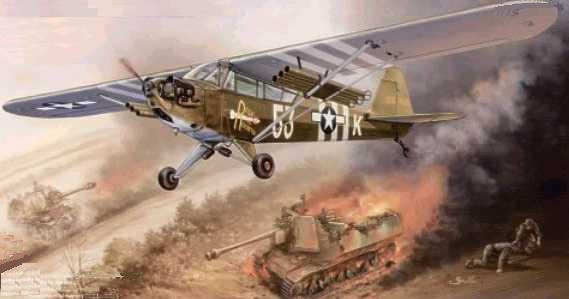
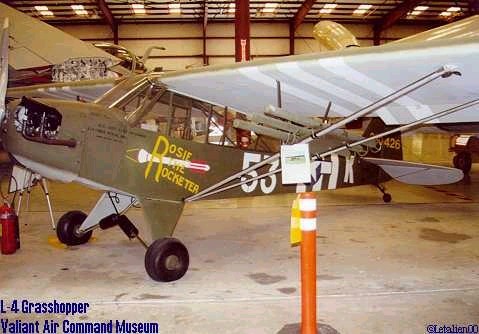
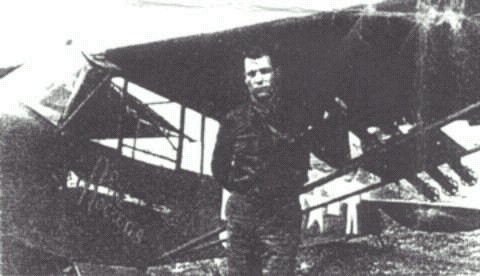
Major Charles "Bazooka Charlie" Carpenter, 4th Armored Division And His [2.36"] Bazooka-Equipped L-4H "Rosie The Rocketeer"
aeroweb.brooklyn.cuny.edu/specs/piper/l-4j.htm
Leland F. Carpenter, LeeBear35@yahoo.com, Johnsburg, IL
Here is some information about the "Rosie the Rocketeer" aircraft, and "Bazooka Charlie", the pilot.
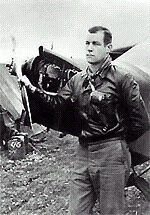
During WWII, a Moline man placed several Bazookas under the wings of His Piper Cub Scout plane. He then used the plane to attack German tanks. I believe his name was Carpentier or Carpenter. Can you give me any more information?
A: Charles "Bazooka Charlie" Carpenter, a native of Edgington in southern Rock Island County, graduated from Rock Island High School and Centre College in Danville, Ky. He was teaching history at Moline High School when he joined the Army in 1942. File Photo Major Charles Carpenter with his plane, "Rosie the Rocketeer," somewhere in France. His battlefield exploits in the tiny plane won him a variety of nicknames: "Bazooka Charlie", "The Mad Major" and "Lucky Carpenter."
In 1944, by then a major, he arrived in France, where his assignment was flying a Piper Cub on reconnaissance missions in front of the 4th Armoured Division of Gen. George Patton's Third Army. Ignoring regulations against arming the tiny recon planes, Major Carpenter attached 6 x [2.36"] Bazooka [recoilless rocket]launchers to the wings of "Rosie the Rocketeer" and began attacking German armour. Threatened with court-martial, he was saved that fate by Gen. Patton himself, who not only stopped the disciplinary proceedings but awarded the major a medal for bravery. Major Carpenter was soon known the world over. The Army newspaper, Stars and Stripes, featured him and his exploits several times, as did papers as far-flung as the New York Sun and the London Times. The Associated Press reporter Wes Gallagher, in a 1945 article in Liberty Magazine, said Major Carpenter was "a legend in an outfit where reckless bravery is commonplace." He told Gallagher that his idea of fighting a war was "to attack, attack and then attack again." By war's end, Major Carpenter had destroyed 6 German tanks, participated in several ground fights (he'd land on the battlefield and lend a hand), won a Silver Star and an Air Medal and been promoted to lieutenant colonel. Discharged from the Army after it was discovered he had Hodgkins Disease, he was given just two years to live. He made if for 20 years; he died in 1966 in Urbana, where he had taught school since the war's end. He is buried at Edgington Cemetery.
A model-make who knew LTC Carpenter writes:
reocities.com/qcsms/news/2006/2006_01.html
In my youth in the late '30's early 40's I was lucky enough to spend a couple of summers at the local Moline "Y" in a learners swimming class. I was even more fortunate to have a Moline High School teacher as our coach. His name was Charles Carpenter and if anyone had a boyhood hero, Charles was, and still is, mine. A year or two after these summer swimming classes, World War II broke out and Charles went off to war. He took light plane and glider training and before he could be assigned to gliders he become an L-4 pilot/ spotter/ and official pilot assigned to Major General John S. Wood of Patton's 3rd Army, 4th Armored Division. Charles went into France just a day or two after "D" Day and was Gen. John Wood's personnel pilot. This duty assignment allowed for some spare time so Charles had a project in mind and an Axis - German score to settle. (Part of this story is that before Charles went into the service, sometime after Dec. 7th, he had gotten word that his older brother had died at the hands of the Japs during the Bataan death march. So he signed up to go into the service with a mission to get even.) It seems that the story goes that on one of the earliest hunts, Charles got a bit overzealous in chasing down Germans and General Patton had to come and bail him out of trouble with some of the French authorities. So here was Charles, with an L-4, nice little airplane and time on his hands and being a crafty scrounger as most guys are in the Army...he found some old bazookas lying around not doing anything. With a little assist from some mechanics in one of the English airparks, a couple those 2.36" bazookas soon found a new home under the wings of the L-4. Now any good old airplane with some heavy ordnance hanging on it sure needed a name and so it was soon labeled "Rosie the Rocketeer." Probably Charles had heard the then new wartime song "Rosie the Riveteer." So Rosie came to be. According to several small articles from contemporary issues of the European Theater "Army Times," Rosie and Charles went out and nailed some German heavy armor. At the point in the article that the Army Times reporter caught up to Charles he had increased the weapon compliment to a total of 6 Bazookas and had already accounted for at least 5 heavy tanks and some German light skinned vehicles. I would tend to think that as word got around the German armored columns, those gents began to get a little nervous anytime an American Grasshopper spotter plane showed up overhead. "Bazooka Charlie" came back to the central Illinois area at the wars end and resumed teaching at the old Roosevelt Military academy in Aledo. He soon learned that the illness that he contracted and cut short his army active service was a terminal illness and he passed away as a relatively young man. I regret that I lost track of him as I grew up and not being aware of him until too late. What a story he could have told. There is no doubt that somewhere "up there" his brother met up with him and patted him on the back for a job well done. The first time I built the model of the L-4, I did some research and located Charles' widow and thru her was able to secure some of the material that she had accumulated relating to Charles' mission to go anywhere, after anything Axis related. The Heller kit goes together quite well. To make the specific modifications for this model took very little work Add a scale piece of sheet plastic representing a mounting plate on the right and left pair of wing support struts, and then 3 small pieces of tubing on each side to represent the Bazookas. I was able to secure some reasonably good pictures of Rosie on the ground with Charles next to her. The standard invasion markings were very easy to duplicate, and the tail number was very easy to read. In the pictures it seems that there is the appearance that the upper wing surface invasions stripes had been painted over rather crudely. The biggest issue was to hand paint a small decal representing the "Rosie the Rocketeer" logo. I was also able to find a small number set that represented the aircraft tail number and a larger letter set to represent the European theater aircraft I.D. lettering on the fuselage sides. At this point I am part way thru doing Rosie again.
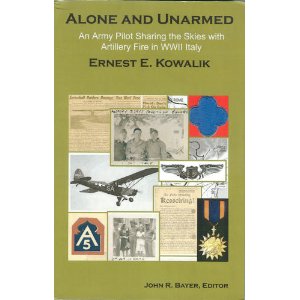
In his book, Alone and Unarmed, pages 267-268, Kowalik states that there were more than just Carpenter killing tanks with L-4s. He says there was a "Piper Cub Tank Busters of France" and that the founder knocked out 38 tanks. The Grasshopper pilot telling him this after the war, killed 18.
Alone and Unarmed is the story of a lone pilot, Staff Sergeant Ernest Kowalik, flying the military's version of the 65-hp Piper "Cub", during the Italian Campaign in WWII most of the time without benefit of a rear seat observer.
Flying without an Observer, because he was the "spare" pilot for the 88th Division Artillery HQ Battalion, Kowalik actually flew more than twice the average number of sorties and hours than the typical division Liaison Pilot, often at dangerously low altitudes.
Artillery spotting and scouting for the 88th Infantry "Blue Devil" Division, he saw a wide variety of action, from taking out large enemy guns and rescuing supply caravans from ambush, to making possible several significant breakthroughs of enemy lines.
Join Staff Sergeant (later Lieutenant) Kowalik as he relives significant episodes of the world's struggle for freedom in that time.
"Directing artillery fire from an unarmed, unarmored light aircraft was surely one of the most dangerous tasks performed on a daily basis during World War II. Flying from rough, unimproved airstrips, often within range of enemy shellfire, added to the perils faced by Field Artillery pilots, as did the ever present threat of bad weather. Such operations are covered in graphic detail by Ernest Kowalik, whose Alone and Unarmed is a welcome addition to the small number of books on a little known aspect of WWII."
- KEN WAKEFIELD, author of Lightplanes at War, The Flying Grasshoppers, and Luftwaffe Encore.
Pre-publication offer, only $19.95 plus $2.00 Media Mail shipping. Priority Mail extra.
Pay via Paypal to jrbayer3@yahoo.com, or send check or money order to:
The Glenn Curtiss Press
c/o Bayer
8501 E. Alameda Ave. #1031
Denver, CO 80230-6891
thetroubleshooters.com/br/br136.html
The 1st Battalion, 319th Infantry Division Ambush, April 11th, 1945
By Maurice "Bill" Costley
EXCERPT:
On the 8th of April, 1945, after taking the industrial city of Kassel the 80th began it's attack to the southeast. April 11th, mid-morning, the 319th Regiment's 1st Battalion, while being trucked on the autobahn near the town of Possendorff, was ambushed by the Germans. This ambush subjected the entire convoy's serial to intense machine gun fire from well-prepared positions in a line of woods, paralleling the left roadway.Charlie Company was leading, with some personnel and vehicles from Headquarters Company; "A" Company brought up the rear. The entire battalion, which included accompanying tanks, received fire at the same time. The firing began as "C" Company came upon a blown-up bridge, and was in the process of turning.
Organized resistance was formed nearly instantaneously, which was amazing due to the intense surprise fire. The GI's began marching fire, and with the assistance of the tanks, proceeded to methodically clean out the woods. Men from all companies participated in this, since all were fired upon at the same time.
This ambush so angered the GI's, that the Germans who survived the return fire were treated very harshly. It was also discovered that the enemy consisted of SS and Luftwaffe personnel being utilized as infantry. Some popped out from camouflage-covered holes, attempting to shoot the passing GI's in the back. The fight lasted less than 40 minutes. It was thought that the SS units were from Buchenwald, as many of the SS guards left the camp to engage the approaching Third Army.
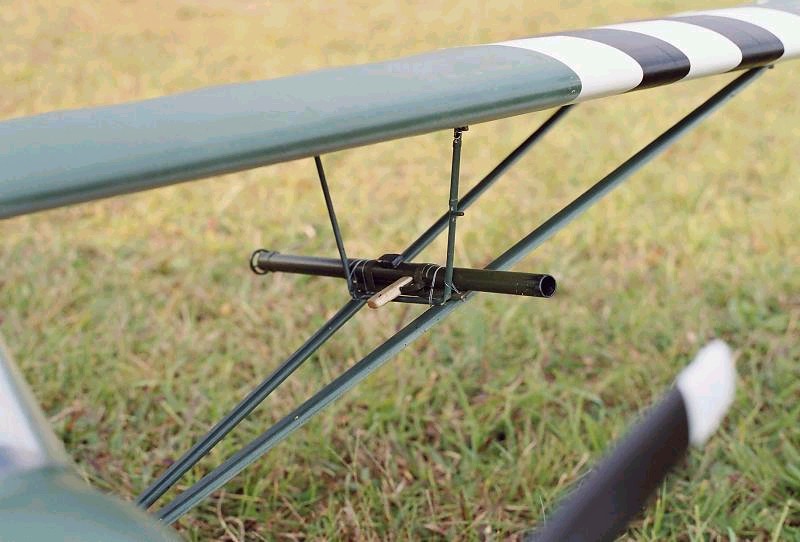
A notable happening here was the appearance of an L-4 Liaison plane with three infantry bazookas attached to each side of its wing struts. In a rather steep dive, it fired its bazookas into targeted German positions. This was done during the chaos of the battle, and not too many ground troops took notice. Three of the Soldiers who saw this event are living today, Maurice Bill Costley-San Diego, California, Elton Webb, of Houston; Texas, and Rudy Tomasik of Woodstock, Connecticut. For his action here, Rudy was awarded the Silver Star. The commendation was given for firing his jeep-mounted 50-caliber [heavy] machine gun into the woods, allowing the GI's time to reorganize.
The bazooka-firing L-4 was from the 4th Armored Division, whose line of march was to the battalion's right, not only on the autobahn, but also moving cross-country. The L-4 was "riding shotgun", thus observing what had happened.
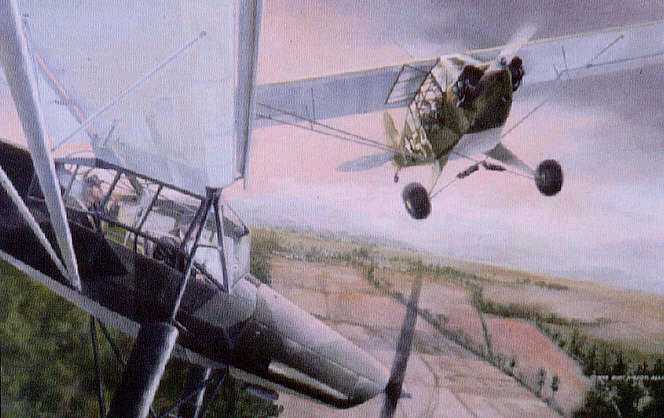
The last plane shot down in WW2 was a German Storch after being fired on by Americans in a Piper Cub using .45 caliber hand guns!
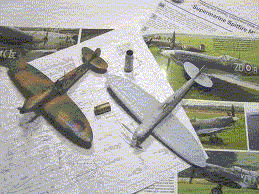 Piper-L4 Grasshopper
Piper-L4 Grasshopper
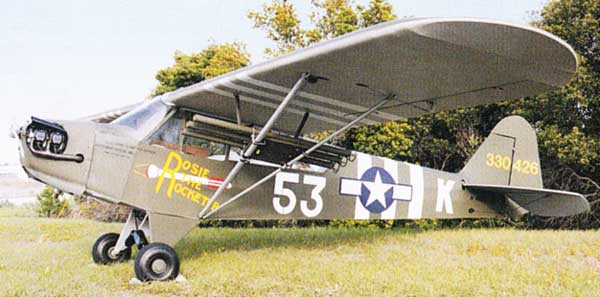
The Piper L-4 was basically, the all familiar Piper J3 Cub with more overhead windows allowing the pilot to check for traffic directly over the aircraft with minimal effort. It was used in the European and Pacific theaters doing any job assigned. In a few cases, they were actually credited with destroying enemy fighters. The folder ALSO includes a second model.. the Air Ambulance in two scales. $8.95
However, after WW2, we lost the fighter-bomber components of MAS to the USAF. The debacles in Korea like Task Forces Smith and Faith revealed how the USAF was AWOL when it came to CAS.
Stegall in Korea: life-saving MAS
The U.S. Army of the 1950s knew how to do STOL Well, even from Small Aircraft carriers at Sea
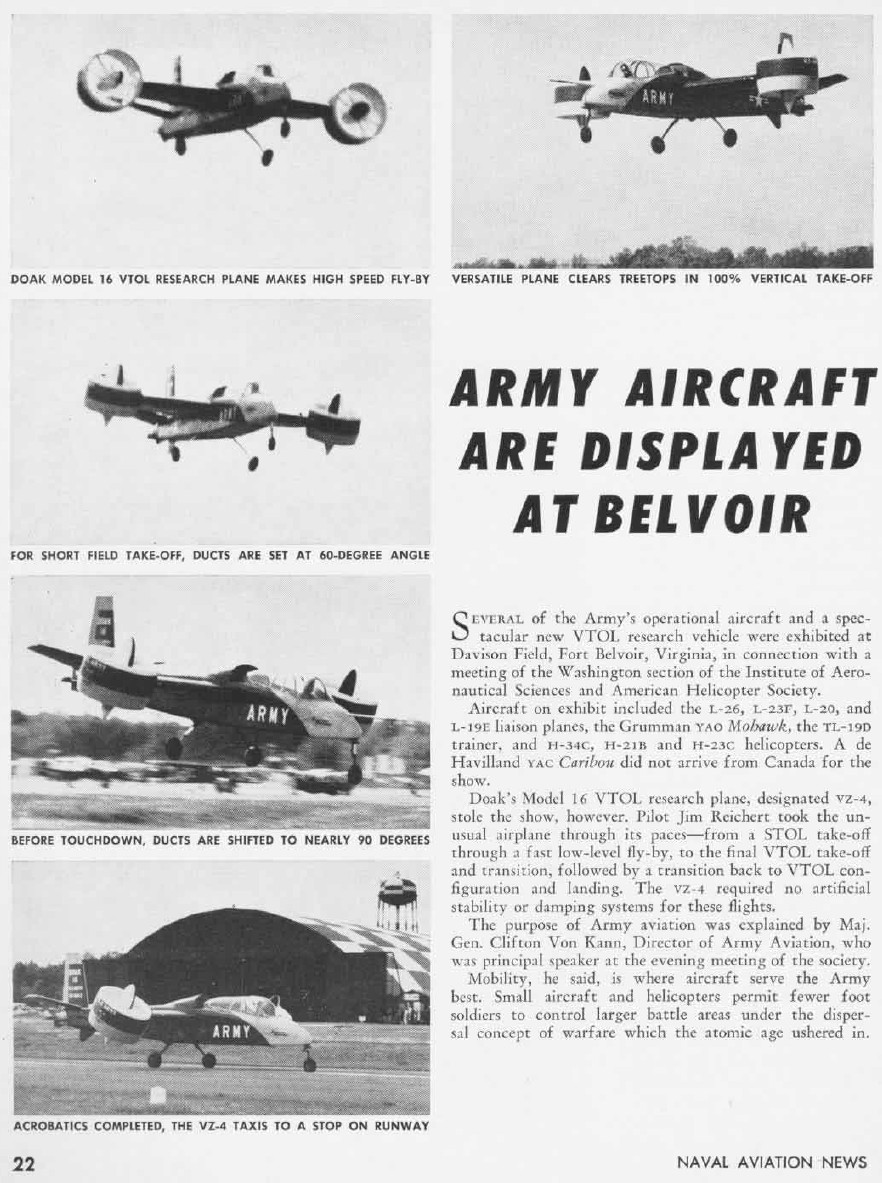
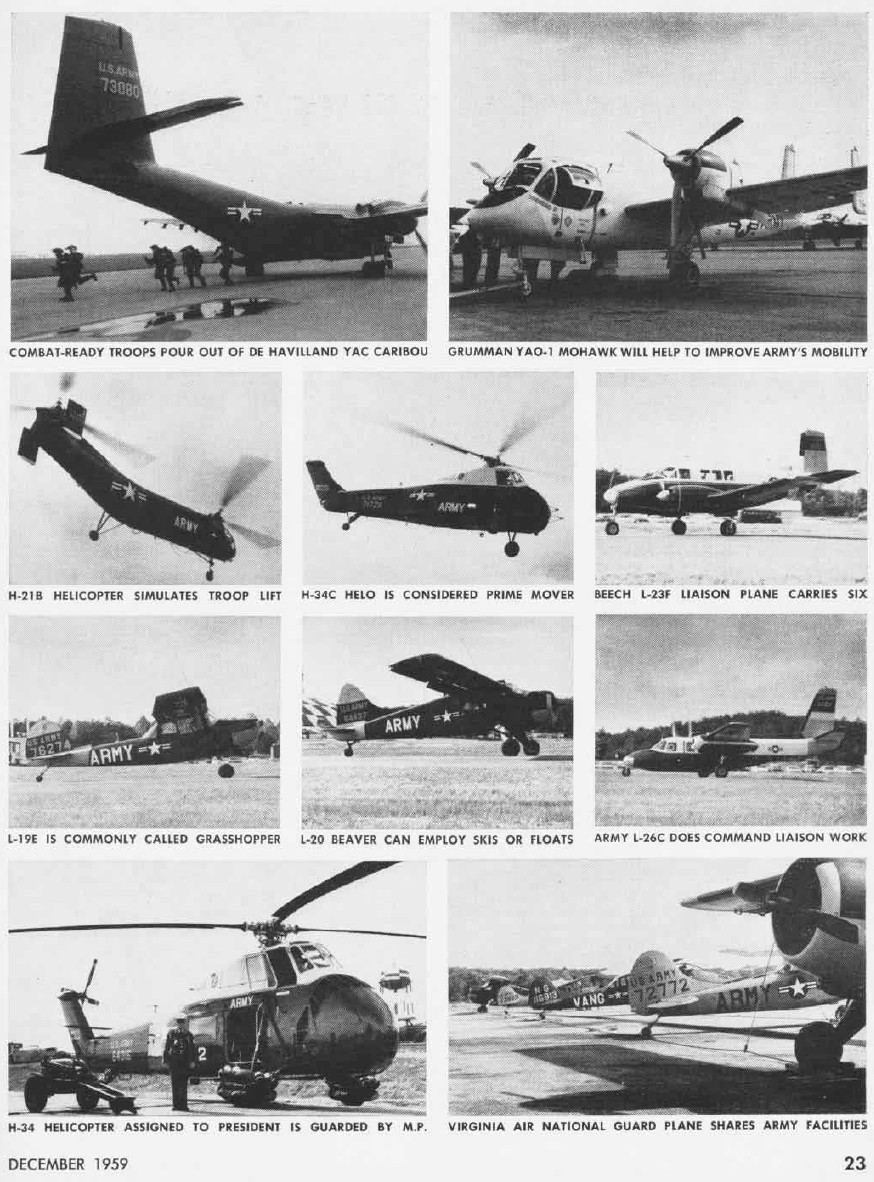
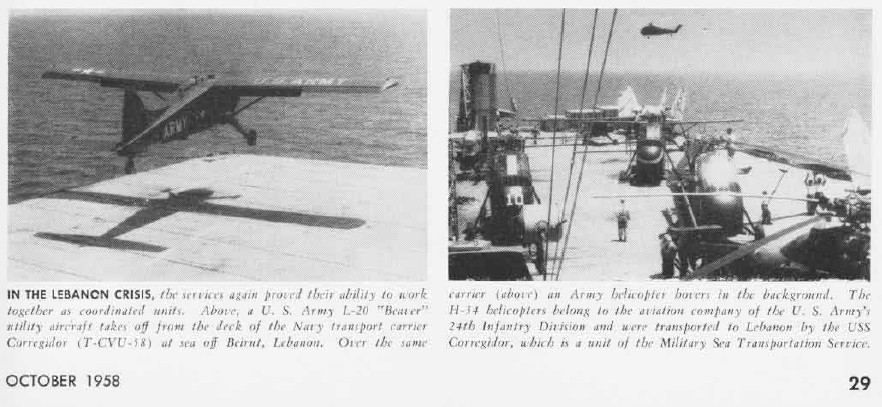
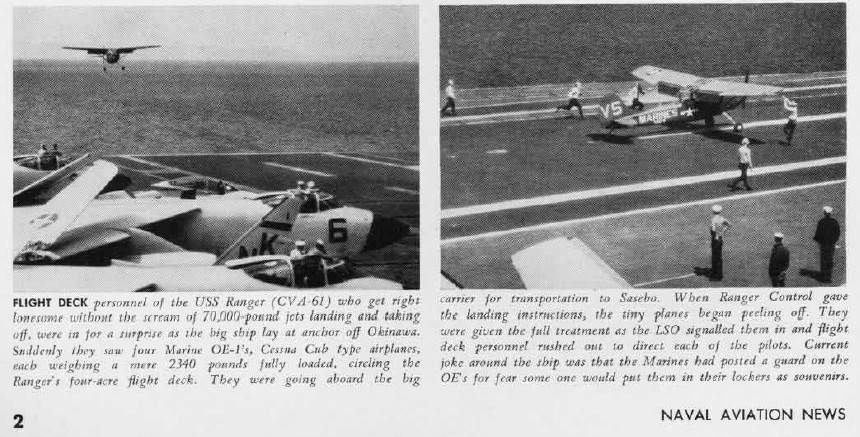
One of the tragic consequences of incorporating helicopters into the U.S. Army and marines is that egos drive everything and now we had egomaniacs who want their platform to get all the attention and budget. When non-adult narcissists comprise your military service they are not likely to have the HUMILITY needed to admit that their one platform cannot do it all and needs other complimentary platforms operated BY OTHER PEOPLE to get important overlapping capabilities to achieve the strongest synergy possible with minimum weakness enemies can exploit.
Before "rotor-head" egomaniacs took over and ruined Army Aviation, we could do STOL very well to include landing on the water.
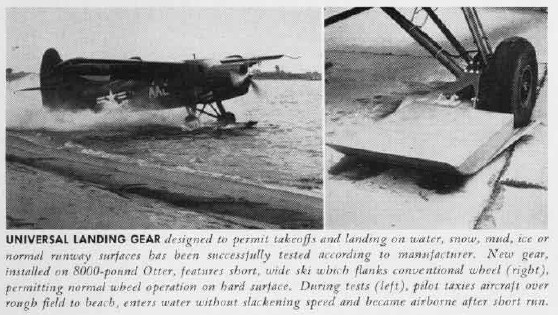
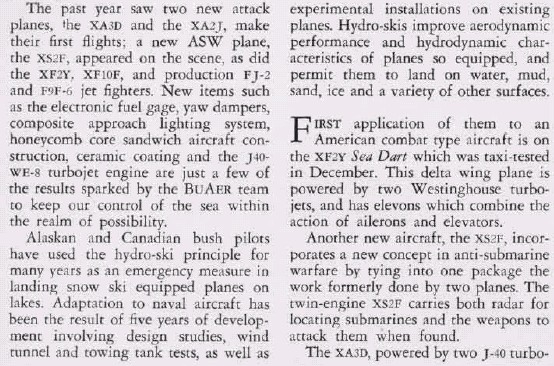
The reality that any aircraft could land on the water without a boat hull or floats has been SUPPRESSED from the general public by the military ego club racketeers who want to not get wet or dirty while on the taxpayer's dole. The PANTOBASE ski system to land on water, ice, snow as well as land with wheels able to work only impacts aerodynamic speed by 2%. If you keep on taxiing in the water to shore you don't even need to seal the fuselage. If you make the skis retract into the fuselage or wings by design, aerodynamic penalty is ZERO. Our emasculated military that physically wants to avoid direct interface with the earth is getting creamed in Iraq/Afghanistan and bodes ill for the future survival of the U.S.
With STOL fixed-wing aircraft the Army can fly fast enough to get shot down and cheap enough to not go broke, using a modest amount of helicopters to get from point A to B VTOL mobility and grasshopper MEDEVAC and resupply work done where VTOL hovering was needed.
Fortunately, by the time the Vietnam war flared up again, we still had grasshopper STOL fixed-wing aircraft to direct artillery fire when they spotted the enemy. Legendary Army leader, LTC John Paul Vann could fly the L-19 (O-1) Bird Dog and dropped ammo to troops in Korea and directed the battle of Ap Bac in 1963 from the air, almost saving the day.
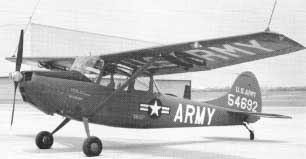
combatreform.org/johnpaulvann.htm
Vietnam: Maneuver Air Support Video: in praise of the O-1 Bird Dog
What Right Looks Like: we rediscovered it!
Isn't it funny that what we have been proposing: 4 x fixed-wing STOL observation/attack "Grasshoppers" be assigned to EACH ARMY MANEUVER BRIGADE was being done all along during the Vietnam war by the USAF GFAC/AFAC community!!!!
Add to that over 425 other O-1 Bird Dogs of the Army in Vietnam...
So we at one time knew what "right looked like".....
Then....
Vietnam ends...we get paranoid about SA-7 MANPADS, IADS, and the slower airplanes the USAF fighter-bombers jocks never really wanted around bothering their egos that there might be other types of aviation than theirs...and VOILA!!!! No more observation/attack planes!
Then add the O-1 Bird Dog retirement at the hands of the Army's "rotorheads"....and Congress stabbing us in the back in 1996 for the MICC-TT corporate welfare J-STARS BS 707 flying radar with light bright pegs..is that a T72 or a camel??? Hmmmm better blow it away just in case....
Now we have Soldiers without 24/7/365 air cover over Iraq (helos can't fly enough, too loud, UAVs can't see shiite) and the enemy able to sap the predictable roads at will...blow up pipelines....thank goodness of late they are ignoring us and our Club-FOB (Club Med in Iraq with cafeteria food and threat of death from rebel attacks] and instead killing themselves in the latest version of Shia vs. Sunni, Part 13 (centuries later). If the USAF is NOT INTERESTED IN DOING SUB-NATIONAL CONFLICT and nation-state ware AFAC missions, LET THE U.S. ARMY DO IT, perhaps through a Non-Linear Maneuver Brigade and/or Stability Corps. Lead, follow...or GET THE HELL OUT OF THE WAY, USAF.
airpower.maxwell.af.mil/airchronicles/aureview/1967/sep-oct/stoner.html
Document created: 21 July 2005
Air University Review, September-October 1967The Closer the Better
Colonel John R. Stoner
"They dropped the ordnance right in our laps-but that's exactly where we wanted it." This statement is typical of those made by company, battalion, and brigade commanders in November of 1965 when the 1st Cavalry Division (Airmobile) thrust into the middle of Viet Cong strongholds in the Central Highlands of South Vietnam. . . During Operation Shiny Bayonet, USAF forward air controllers (FAC) directed fighter air strikes against a Viet Cong force trapped between two battalions of the 1st Brigade in a space less than 200 yards wide. Each ordnance release was coordinated with the forward observer and carefully placed between the friendly forces at the expense of the trapped VC. . . . During the Ia Drang Valley battle, a 1000-pound general-purpose bomb was delivered to within 50 yards of the perimeter of the 1/7 battalion. This bomb was precisely placed at the request of the battalion commander and destroyed a Viet Cong human-wave attack. Our attacking fighters were controlled by both a FAC on the ground and a FAC overhead in an O-1 Bird Dog.
These are examples of the close air support provided to units of the 1st Cavalry Division during search and destroy operations in the Plei Me, Duc Co, Ia Drang Valley, and Bong Son tactical zones.
Conclusively, close air support in Vietnam has been outstanding. This is not an evaluation promoted by Air Force officers but is the central theme of expressions of thanks not only from General Westmoreland and Major General Kinnard, commanding the 1st Cavalry Division, but from the platoon sergeants and infantrymen within the active combat elements. Their statements have been accurate and dramatic. They have caused many in the close air support area to wonder if there has been a revolutionary development in tactical air operations.
ALO - Air Liaison Officer
CTOC- Corps Tactical Operations Center
DASC - Direct Air Support Center
FAC - Forward Air Controller
TACC - Tactical Air Control Center
TACP - Tactical Air Control Party
TACS - Tactical Air Control System
TOC - Tactical Operations CenterWithout a revolution, tactical air forces have been given the opportunity to do what Tactical Air Command has long been affirming: that we in the tactical air business can provide close air support to engaged ground forces with minimum reaction time. The resultant evolution, which spanned a number of years, culminated in modifying the Tactical Air Control System (TACS) into the control agency used today in employing tactical air forces. The need to modify and update the system became apparent during the early 1960s.
Prior to 1963, communications equipment needed by the combat elements of a division for requesting tactical air support was furnished by the Army. When a ground combat element, a company or battalion, required close air support, the request was transmitted to the next level of command, usually to the brigade command post. There it was analyzed to determine if organic artillery fire support means were available and possessed the desired capability. If not, the air request was approved and transmitted to the division for action. Once again it was acted upon, using the rationale that organic fire must first be considered. The same coordination and approval cycle occurred for the third time with the corps tactical operations center (CTOC). All these related actions within the Army structure, from the battalion on the line to the operations personnel within the CTOC, had to be accomplished before Air Force personnel were made aware that a requirement for close air support existed.
Once the request was finally received within the Air Force agency collocated with the corps, action to launch the strike was immediate. Unfortunately, to the layman within the Army, the Air Force appeared to be totally unresponsive in honoring requirements for close air support. [EDITOR: has anything changed? USAF got rid of ALL its observation/attack planes at end of Vietnam due to MANPADS/IADS hysteria!] All the time used in staffing the request from the battalion, the originator, to brigade, division, and through the corps structure degraded reaction time to an unacceptable degree. For example, during Joint Exercise Swift Strike II in June 1962, requests for close air support stipulating an on-target deadline of not later than 0800 hours were not made known to the Air Force until 1300 hours. Battles cannot be won when tactical air arrives some five hours late. [EDITOR: it happened all the time during the 3rd ID (M)'s OIF march to Baghad in 2003]
As a result of such experiences during most of the joint exercises, the Commander in Chief, U.S. Strike Command, requested that the Commander, Tactical Air Command, and the Commanding General, U.S. Continental Army Command, jointly analyze the organization for fire support coordination and determine the optimum arrangement to support joint forces of varying magnitude. A searching analysis of the system, coupled with the experiences described, revealed the following major weaknesses in the means for requesting and providing air support:
· Inadequate responsiveness of the system to the immediate close air support and tactical air reconnaissance needs of front-line Army commanders. Processing of requests through Army command channels is time consuming, and the delay in informing the Air Force of the air-support requirement is excessive.
· Lack of reliable communications, especially for the air request system and the forward air control system.
· Lack of trained personnel, continuously available, who are intimately familiar with the coordination and planning techniques for providing air support.
As a result of the requested analysis, Tactical Air Command promoted the concept that the Air Force should provide and man all the communications necessary to operate an Air Force immediate air request net which would enable tactical air control parties (TACP's) at each level of Army command to transmit requests for immediate tactical air support to the direct air support center (DASC). Tactical air control parties consisting of air liaison officers and forward air controllers were furnished jeep-mounted and portable-manpack radios to accomplish this task.
A DASC is collocated with each deployed corps or with a division conducting independent operations. The principal function of this facility is to provide a fast-reaction capability to satisfy requests for close air support, tactical air reconnaissance, and tactical airlift support. The tactical air control center (TACC) allocates sorties to the DASC to satisfy requests and passes scramble and control authority to the DASC.
The DASC is a highly mobile, air-transportable element of the Tactical Air Control System, designed to operate with the appropriate Army tactical operations center (TOC). It is subordinate to the tactical air control center, which is the air operations element wherein the Air Force component command plans, controls, and coordinates the employment of tactical air forces within an area of operations.
With Air Force-owned equipment employed, the significant change is in the procedure for requesting immediate tactical air support. The request can originate at any Army echelon. Below battalion level, the request goes to the battalion command post (CP) by the fastest means available. There it is evaluated by the battalion commander or his fire support coordinator, then passed to the forward air controller. He transmits it directly to the DASC over the USAF Air Request Net. Each TACP at intermediate echelons monitors the transmissions and coordinates all requests for close air support with his Army counterpart, the fire support coordinator. It should be noted that no Air Force representative in this network can disapprove a request; only the Army member can do so. If he does, the DASC is so notified by the TACP, and the request is canceled.
Meanwhile, the DASC checks with the Army TOC, plans the mission, and then orders the mission flown if a disapproval has not been received. Should the ground commander determine that the strike is not required after the aircraft has been scrambled, it can be diverted to lower-priority interdiction targets. The Air Force would rather waste a mission than wait for a prolonged period to obtain a positive approval.
With this system, Air Force response has been dramatic, placing fighters on the target in less than 30 minutes from the time the originator at the lowest combat echelon of the Army determined and made known a need for tactical air support.
This has been the evolution of the elements of the Tactical Air Control System primarily concerned with air-ground coordination functions. The result is apparent: the USAF Air Request Net is used today in Vietnam.
To insure that trained personnel were continuously available to Army commanders, a group of highly experienced and extremely competent tactical fighter pilots was assigned from Tactical Air Command to each Army corps and division stationed in the United States. The team, known as a tactical air control party, consisted of an air liaison officer (ALO), two forward air controllers, and radio maintenance technicians and operators, with the necessary radios to perform their functions. Most of the Air Force officers, in addition to being highly experienced in tactical air operations, were qualified parachutists knowledgeable in airborne operations and the organization and tactics employed by land forces.
Our people assigned as hard core became members of the corps or division staff, available continuously to teach Air Force capabilities and to integrate tactical air support into Army field training tests and major exercises. The three officers provided the nucleus and continuity necessary for daily operations and to insure that augmentation of additional forward air controllers was accomplished without difficulty during major exercises. Many of the hard-core teams prepared instruction pamphlets to guide augmentation personnel. The preface usually outlined the purpose of the pamphlet, which was intended not to replace Tactical Air Command manuals concerning ALO/FAC operations but to augment them with local unit procedures. In that context, they extremely valuable as a supplement and practical guide. The information contained based on the experiences of the hard-core members and tended to minimize the lost motion usually experienced by personnel when reporting to an Army unit to participate in a training exercise, particularly under field conditions. This action and the dedicated performance of the hard-core forward air controllers closed tile second gap. Trained personnel had been integrated into the Army staffs at every level of command.
These past actions and background provided the basis for the evolution of close air support to the tremendous job being performed today in Vietnam. Tactical Air Command was prepared to accomplish the mission when the 1st Cavalry Division (Airmobile), the first American division employed in Vietnam, was alerted for combat action. When the Division was ordered to deploy in late spring 1965, Tactical Air Command augmented the Division's permanent tactical air control party with all the additional air liaison officers, forward air controllers, maintenance technicians, and radio equipment necessary for combat operations.
The 1st Cavalry Division's tactical air control party organization assembled at Fort Benning, Georgia, contained 19 officers, 24 airmen, and 17 x MRC-108 jeep-mounted radio packages. At Division, in addition to the air liaison officer, the team included a fighter operations officer, reconnaissance officer, and an airlift operations officer. [EDITOR: TACP needs to be in all-terrain, armored M113 Gavin light TAFVs not flimsy jeeps] All but two of the officers were parachutists and had participated in numerous exercises with Army airborne units. With professionals in each functional area of tactical air support, adequate and meaningful planning could be provided to obtain support throughout the spectrum of tactical air.
The team of four qualified officers assigned at division level provided additional benefits once in combat operations. The 1st Cavalry Division operated throughout the entire II Corps area of South Vietnam from the China Sea to the Cambodian border. Simultaneous actions were planned and executed at the extremities of the area. With forces so dispersed, it was necessary to operate a forward division tactical operations center. With four officers assigned, the Air Force was able to place a tactical air control party with the main division TOC, allowing the air liaison officer and the fighter operations officer to be employed with the forward mobile division tactical operations center. During the first seven months of combat action, this split operation was required except for a cumulative total of 41 days. Additionally, the division ALO was able to spend much of his time visiting front-line units to insure that the commanders were getting the kind of air support they desired.
An air liaison officer and an assistant ALO were attached to each of the three brigade staffs. Forward air controllers were positioned with the eight infantry battalions, and a ninth with the Air Cavalry squadron. All nineteen officers, which included the four attached to Division staff, were qualified forward air controllers.
Once assembled at Fort Benning, the tactical air control parties prepared to deploy. They did not accompany the 1st Cavalry Division as an Air Force contingent per se. Each TACP was attached to a unit and reported to its respective Army commander for duty. Air liaison officers, forward air controllers, and their airmen, with all necessary equipment, were attached to their respective staffs and battalions prior to departure. They reported to their Army commanders at Fort Benning for duty and instructions and accompanied their respective units by ship to Vietnam. Once in place, they lived and worked with their attached unit. As a result, the Air Force people were integrated into the various Army staffs prior to entering combat action. With their equipment ready, they were prepared to perform the functions of a tactical air control party extremely well.
The functions of tactical air control parties are:
-to provide and operate an air request net
-to control close air support air strikes
-to advise the ground commander on Air Force capabilities
-to assist in planning air-ground operations.The first two functions are self-evident and are considered the classic tasks of the forward air controller. The other two, to advise his ground commander on Air Force capabilities and to assist in planning air-ground operations, are the real key factors to providing the timely, accurate, and discriminating close air support necessary to further the land battle. They were certainly the major factors leading to the outstanding tactical air support rendered to the 1st Cavalry Division in the highlands of South Vietnam.
The air liaison officers and forward air controllers at battalion, brigade, and division not only assisted but actually accomplished much of the detailed planning necessary to integrate close air support operations into the fire and maneuver of ground combat elements. The rapport established by living and working together brought our Air Force people into the planning cycle as coequal partners.
Whenever a battalion was committed to combat on the ground, the attached forward air controller accompanied the commander, tramping through sniper- and malaria-infested jungle with full field gear and portable radios, continuously available to advise and to request air support when necessary. It is in this role that a forward air controller devotes 98 percent of his time and effort. Here he is the Air Force tactician and is welcomed as a valuable and trusted member of the ground commander's staff. The forward air controller, in the air liaison officer role, frequently requested additional tactical air support for certain phases of operations, anticipating requirements before the ground commander saw the need. In some specific instances this action made the difference between success and failure on the battlefield for battalion-size units. For these reasons, within the 1st Cavalry Division's original Air Force contingent, no unit of battalion or brigade size left the Division base camp at An Khe, Republic of Vietnam, for combat operations without its Air Force tactician. He was undoubtedly in mind when a senior Army officer said: "Without exception, all of the Army officers of this Division are convinced that they have had the finest air support that men and machines can provide."
It has been stated that in Vietnam the nature of the conflict and the terrain make it extremely difficult if not impossible to control air strikes effectively from a ground observation post. This certainly applies to much of the area. It was soon apparent that it would be necessary to extend the sight of the ground forward air controller by providing him an airborne platform. This was accomplished by assigning four O-1 [Bird Dog] aircraft to the division TACP. With these few aircraft it was possible to position an airborne forward air controller on station above 1st Cavalry Division units. It is over remote, otherwise virtually inaccessible areas that forward air controllers flying the small O-1 Bird Dog aircraft have played an invaluable part in the unrelenting war against enemy training and supply bases.
The airborne forward air controllers were not additional officers brought in on a mission basis but were those attached to units within the Division who were in reserve. With the concurrence of the particular unit commanders, their assigned forward air controllers and brigade liaison officers were deployed with the division forward tactical operations center. From this forward location, they would operate the O-1 aircraft. As a result, two forward air controllers supported all combat actions, one on the ground as the liaison officer, the tactician; and one in the air, the technician. [EDITOR: the STOL capability of the O-1 Bird Dog meant it could be CO-LOCATED with ground maneuver units and NOT be dependant upon fixed air bases farther and farther to the rear]
Art by Anthony M. Stencel; more of his great paintings can be found at tonystencel.com and prints are available on his website for purchase. He is currently a combat artist with the USAF Art Program, and an old E-5 Sergeant MOS 81E30 Illustrator for the U.S. Army (1981-90) 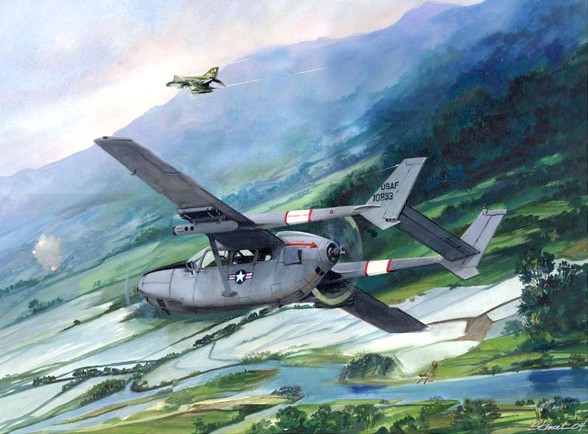
Here an O-2 SkyMaster has marked a target with a white phosphorous (WP) 2.75 inch rocket and a F-4 Phantom is inbound to strike the exact area; we lack this AFAC capability using visual pyrotechnics today; even on the ground, our M1 Abrams heavy tanks' 120mm guns don't have a WP round available for a CAS marking
The airborne FAC would [physically] mark targets and accomplish the final control of the fighter strike. This tactic worked extremely well. Both forward air controllers remained in radio contact at all times. The one on the ground, working with his Army fire support coordinator, would make final adjustments of his mark prior to releasing the fighters to strike. This was vitally important because close air support required by U.S. Army units had to be extremely accurate. It was necessary to place ordnance on targets within 50 yards of our troops during much of the combat action. This could not have been possible in the jungle environment, with no visual front lines or perimeters separating friendly and enemy troops, without the closest possible coordination between the FAC's. There was no room for error. [EDITOR: urban "jungle" another type of CLOSED TERRAIN---also requires this same VISUAL marking accuracy]
This was the Air Force organization and concept of operations for combat within the 1st Cavalry Division. Now, let's take a look at how well it performed under fire.
The Special Forces camp at Plei Me was attacked by a sizable North Vietnamese regular force during October 1965. The siege of the camp was crushed by tactical air forces. Some 500 fighter strikes were employed, directed by airborne forward air controllers assigned to the tactical air support squadron stationed in the South Vietnamese II Corps area. This air action kept the camp from being overrun. As a result of the attack on Plei Me, the 1st Cavalry Division was committed to what remains one of the greatest victories fought by American forces, the Pleiku campaign.
To insure that a South Vietnamese [ARVN M113 Gavin] armored column could travel with some security to Plei Me to relieve the beleaguered garrison, the Commanding General, 1st Cavalry, was requested to provide artillery support. One infantry brigade was subsequently committed in the area of the camp. Once U.S. infantry had been heliborne into Plei Me, the enemy withdrew, avoiding an engagement with American forces. The mission then became one to search for the enemy and neutralize the threat posed to the entire western part of the Vietnamese highlands.
At this time, the Division Commander was told that the North Vietnamese could have withdrawn to the north, west, east, or south. With this intelligence, his task of searching out and destroying a sizable enemy force seemed an impossible one. Nevertheless, it was the type of mission for which the air-mobile division had been designed. With an organic Army aviation group possessing 400 helicopters, the infantry and artillery battalions could be employed over vast areas at will. Once an area of suspected enemy activity had been searched without establishing contact, the troops could be moved many miles by helicopter to search out the next likely area of enemy activity. The mobility inherent within the division enabled it to operate throughout a land mass normally considered a corps area. Additionally, the fighting force could be positioned to occupy land which normally would be inaccessible to units relying on ground vehicular transportation. At one time during the Pleiku campaign, battalions were displaced by as much as 30 miles.
The problem of furnishing immediate and responsive tactical air support was compounded by the increased mobility of the Division. Pre-planned air strikes to support the initial action each day were routine. For example, pre-strikes of helicopter landing zones could he coordinated with the fire and scheme of maneuver of the infantry force the evening prior to an attack. With the preponderance of tactical air available in South Vietnam, not only were strikes of the landing zone accomplished but four or five likely landing zones in the vicinity could be neutralized as diversionary missions. The enemy knew as well as we the type of terrain required for a helicopter landing zone. By striking more than one, we kept him off balance while the infantry landed. These diversionary missions were not wasted because on several occasions secondary explosions from the diversionary strikes indicated that enemy supply areas and troop concentrations had been destroyed.
This tactic worked extremely well; but as the day progressed, operations became fluid and moved with an increased tempo. When one of the committed battalions displaced tactically to another area and encountered the enemy waiting, ready and willing to fight, close air support was needed with reaction time equivalent to that of the infantryman's rifle. For this reason, to insure that tactical air was available when the need was most critical, our TACP's employed the combat air patrol/air cover concept. Two fighters were kept on station over the ground force in the combat area from first light until last light every day throughout the 34-day Pleiku-Cambodian-border campaign.
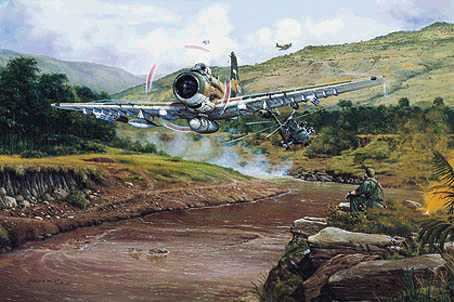
The air-alert fighters, coupled with the airborne and ground forward air controllers, provided a team that could employ aerial firepower in the close air support role with an absolute minimum reaction time. Propeller-driven A-1E aircraft were used for the air alert because they could be loitered for hours and still carry two tons of ordnance. Additionally, the A-1E possessed radio equipment with which the pilot could monitor Army command and fire support frequencies. The pilot could hear the progress of the battle and became a part of it prior to the request to attack. In several instances the pilots pleaded to strike prior to receiving approval from the ground commander. This capability indeed reduced the time necessary to deliver ordnance with extreme accuracy.
[EDITOR: we use A-10s as the air alert fighters and AY-65 Vigilante IIs as the AFACs]
It was obvious that the air-alert fighters would not be used for close air support in every case because the ground elements were not in continuous contact with the enemy but were on search and destroy operations. They did, however, represent a tremendous firepower capability, and the Division did not want to have them return to their home bases once their loiter time had been expended if they could be used profitably. For this reason, the Assistant Division Commander for Operations, the Operations Officer, Intelligence Officer, and Air Liaison Officer planned and implemented a division-level interdiction program to support and complement the overall ground action and future scheme of maneuver. For example, after the siege of the Special Forces camp at Plei Me, the next operation was to the west and north searching for the North Vietnamese regulars who had attacked the camp. The enemy, however, could have withdrawn to the east. For this reason the interdiction plan ordered attacks on the hill mass to the east of Plei Me for the next 5-day period. Prior to landing troops in the Ia Drang Valley-Chu Pong Mountain region next to the Cambodian border, the interdiction support using the combat air patrol fighters was shifted to that area. During one day, 17 secondary explosions were received, indicating a very lucrative series of targets. These attacks con-finned intelligence reports pinpointing the location of the North Vietnamese regiments that had been sought for some three weeks. The next action was to deploy the battalion commanded by Colonel Hal G. Moore into a landing zone called X-Ray. There he fought the largest single battle of the Vietnam war until that time.
As Colonel Moore's battalion was landed at the base of Chu Pong Mountain, an airborne forward air controller and his flight of air-alert A-1E aircraft were overhead. Once the battalion established its position at landing zone X-Ray, Colonel Moore realized that he was in the midst of an overwhelming number of the enemy. He immediately requested all available fire support, tactical air support, armed helicopters, and ground-based artillery. At this time the airborne forward air controller marked the likely target area, within 50 yards of the ground troops, confirmed his marking round with the ground forward air controller, and committed the fighters. The first bomb was on the target two minutes after the requirement was received from the ground commander.
Follow-on tactical air sorties were requested by the ground forward air controller. During the first 24-hour period, 100 fighters had been used in support of this action. The ground forward air controller directed strikes throughout the night, placing firepower within 30 yards of friendly foxholes.
During the five days of this bloody battle, 330 fighter strikes provided close air support. Colonel Moore and his heroic battalion counted 1224 enemy dead and estimated an additional 1300 killed by tactical air power and artillery.
First lieutenant Charles W. Hastings, the ground forward air controller, employed tactical air in the same target area simultaneously with artillery without compromising safety. This fine officer was decorated for valor by both the Vietnamese and the U.S. Army during the Ia Drang battle at landing zone X-Ray. During the second day of the battle, I said to Colonel Moore, "How is my forward air controller doing?" He answered, "John, he is doing a magnificent job, but remember he is my forward air controller." In addition to tactical air support rendered, the Ia Drang Valley was the occasion of the first B-52 strikes truly integrated into the scheme of maneuver and responsive to the needs of a U.S. Army division commander. Once the ground elements became disengaged, it was suspected that the enemy had withdrawn into Chu Pong Mountain. The Commander, 1st Cavalry Division, did not want another attack from a flank position while continuing to search and clear the Ia Drang Valley. B-52s were requested, to neutralize the high ground overlooking combat elements of the Division. For six days B-52 aircraft bombed in very close proximity to the left flank of the ground combat elements. This was possible because the axis of attack and the time over targets were an integral part of the joint battle plan.
Many have queried the effectiveness of heavy bomber operations. Within the 1st Cavalry Division we could only assume that they were an unqualified success because there were no further attacks from the strategic position afforded by Chu Pong Mountain. One prisoner captured during the final phases of the Pleiku campaign stated that his people feared the B-52s because they could not determine where the bombs would fall until they hit the ground. Also, trenches did not afford them protection. This particular prisoner had ordered his troops to obtain rice and ammunition from a cache nearby. A B-52 strike occurred during their absence; they did not return.
To summarize close air support of the U.S. 1st Cavalry Division (Airmobile), 12 to 14 aircraft were used daily for the air-alert concept to insure an immediate reaction should close air support be necessary. When additional strikes were required, they were alerted using the USAF Air Request Net. These follow-on flights would be on target within 20 to 30 minutes, For example, during the day that 100 fighters were employed at landing zone X-Ray, two flights of F-100s arrived before the original air-alert fighters had completed their attack. This pattern held throughout the 24-hour period. It is doubtful that our forward air controllers could have employed them any more rapidly or used additional strikes.
A treatment of tactical air support would be incomplete without an analysis of the logistical phase of operations. Air forces' participation in combat usually is equated to bombs on target, and bombs cannot be dropped unless the logistic pipeline flows properly.
During the siege of Plei Me, Highway 19 leading from An Khe to Pleiku had not been secured, so it was necessary to airlift all the fuel, ammunition, and rations into the combat zone. Initially it was determined that Army CV-2 [Caribou STOL] transports and helicopters organic to the 1st Cavalry Division could sustain the necessary air line of communications. Once the Division was committed, however, it became obvious that the logistics support mission assigned to the helicopter force was degrading the Division's capability to operate tactically. On the morning of the third day, helicopter fuel reserves had been reduced to one-tenth of that required to sustain daily operations.
Air Force tactical airlift was pressed into this vital mission on an emergency priority, primarily to carry fuel into the tactical zone. The requirement was to deliver 140 x 500-gallon fuel bladders daily. The morning after the Air Force had assumed this responsibility, the Division Materiel Officer and I counted 134 bladders positioned at Pleiku Airport. He was much relieved and pleased because he had not realized that tactical airlift was so responsive. Each C-130 carried 10 to 14 of the bladders, which were offloaded without shutting down the aircraft.
Our C-130 crews were unsung heroes of this phase of the campaign. I congratulated one pilot, a first lieutenant, for delivering 14 bladders in one trip. He replied, "Colonel, if I can hide an extra one from the loading crews, I will have 15 on my next trip." He more than likely accomplished this feat and carried a fuel cargo in excess of 55,000 pounds.
Air Force C-130 aircraft were used throughout the 34-day campaign to position fuel for the helicopters. Deliveries were made to Special Forces camps near the Cambodian border and to the forward command post location of the brigade commander charged with land operations. They were operated into the same landing strips used by Army CV-2 transports and C-123 aircraft. [EDITOR: only if the runways had been improved to take the C-130's weight and lengthened to 3, 000 feet] The impact of the C-130 capability was dramatic when compared with the other transports accomplishing the same mission. The CV-2 could lift two bladders, the C-123 four, compared to the C-130's 10 to 14.
There has been an evolution in procedures and organizational structure to insure the closest possible coordination for providing tactical air support to our land combat forces. We must continually improve TACP communications equipment and provide the necessary mobility to the forward air controller to insure an even quicker response time to immediate requests, primarily in the close air support area. Close air support weapon systems should have the inherent capability to deliver the ordnance accurately, the closer the better.
All these factors are being worked on continuously within Tactical Air Command; however, they are only tools to be used by people. The key is to plan air-ground operations jointly with the Army, working together as coequal partners at all levels. In this regard, air liaison officers and the forward air controllers are basic to the USAF Air Request Net and the Tactical Air Control System in immediate support of land forces in the battle area. The FAC moves with his assigned ground unit to be in a position to respond to tactical air requirements requested by the ground commander. Here is the necessity for a close personal relationship between USAF supporting personnel and their Army counterparts. The ALO and FAC know the Army problem and develop the mutual understanding necessary to relate the task to Air Force capabilities.
The ALO's and FAC's attached to the 1st Cavalry Division learned to understand, under fire, that tactical operations in some cases meant clearing a few hundred yards of territory. Additionally, they realized that a seemingly insignificant encounter could become total war for them and their infantry counterparts when they were pinned down by sniper fire. Thus, these USAF people came to understand land commanders, platoon leaders, and the infantry rifleman's problem. They knew his fears and learned to anticipate his needs. They knew and understood because they were there.
When the original Air Force team was replaced, the Assistant Division Commander stated that his Air Force tactical air control parties understood and appreciated the Army airmobile concept as few others do. He stated, "Our TACP's are considered to be full members of the 1st Cavalry Division and much credit should go to them for a breakthrough in the Army's understanding of how to obtain and fully utilize Air Force support."
This evolution is dynamic and continuing. [EDITOR: and self-defeating. As soon as the sub-national conflict aspect of Vietnam ended, bye bye AFACs! Nation-state wars required the sexy fighter-bombers the fighter jocks lusted for!!! Time to prepare for the Soviet armored hordes at Fulda Gap!]
Hq Tactical Air Command
Contributor
Colonel John R. Stoner is assigned to Tactical Air Command's Deputy for Plans. He enlisted as an aviation cadet and was commissioned in 1944. He served during World War II as a B-26 pilot in the Ninth Air Force, European Theater, 1944-45. He graduated from Air Tactical School, Tyndall AFB, Florida, 1949, and Air Command and Staff College in 1957, remaining as a member of the faculty until 1961. With the 11th Air Assault Division at Fort Benning, Georgia, he participated in the two-year field test of the airmobile concept, then, accompanied his unit, redesignated 1st Cavalry Division (Air mobile), to Vietnam. He served as the senior Air Force Liaison Officer with advance elements of the 1st Cavalry at An Khe, flying the O-1E Bird Dog on forward air controller missions. Colonel Stoner has been in his present assignment since April 1966.
Disclaimer
The conclusions and opinions expressed in this document are those of the author cultivated in the freedom of expression, academic environment of Air University. They do not reflect the official position of the U.S. Government, Department of Defense, the United States Air Force or the Air University. [EDITOR: if he says anything TRUE, we can say he's an idiot and not do anything that will change the status quo for the better]
The O-1 Bird Dog heroics of men like Congressional Medal of Honor winner Wilbanks begs the question:
IF THE USAF WILL USE THE HEROISM OF THESE MEN TO POLISH SERVICE IMAGE WHAT ABOUT THE METHODOLOGY THAT ENABLED THE ACTS TO TAKE PLACE?
The Predator UAV piping in TV imagery can't see shiite and would not have spotted the enemy troops as the human Wilbanks was able to do. Are the USAF taking any steps to FIGHT FOR HUMANS TO STAY IN THE LOW-LEVEL AIR SPACE TO ACT AS AIRBORNE FACS?
Not just no! but hell no!!!!
Like after Korea, after Vietnam the USAF went back to its fighter-bombers-for-everything BS and only had the A-10 forced upon them by the reformers and a desire to spoil the Army from having the fixed-wing Cheyenne helicopter gunship. High altitude FBs can't do the low altitude o/a AFAC "MAS" mission.
Had Wilbanks been in an ARMORED and properly ARMED o/a plane HE WOULD NOT ONLY HAVE NOT DIED he would have killed more of the enemy in the first place. In a historical technotactical context, a two-seat, heavily armored contra-rotating prop SKYRAIDER for example. We could have had these type aircraft in 1967, that we did not is shame on the USAF, USN, USMC and to a lesser extent, the Army.
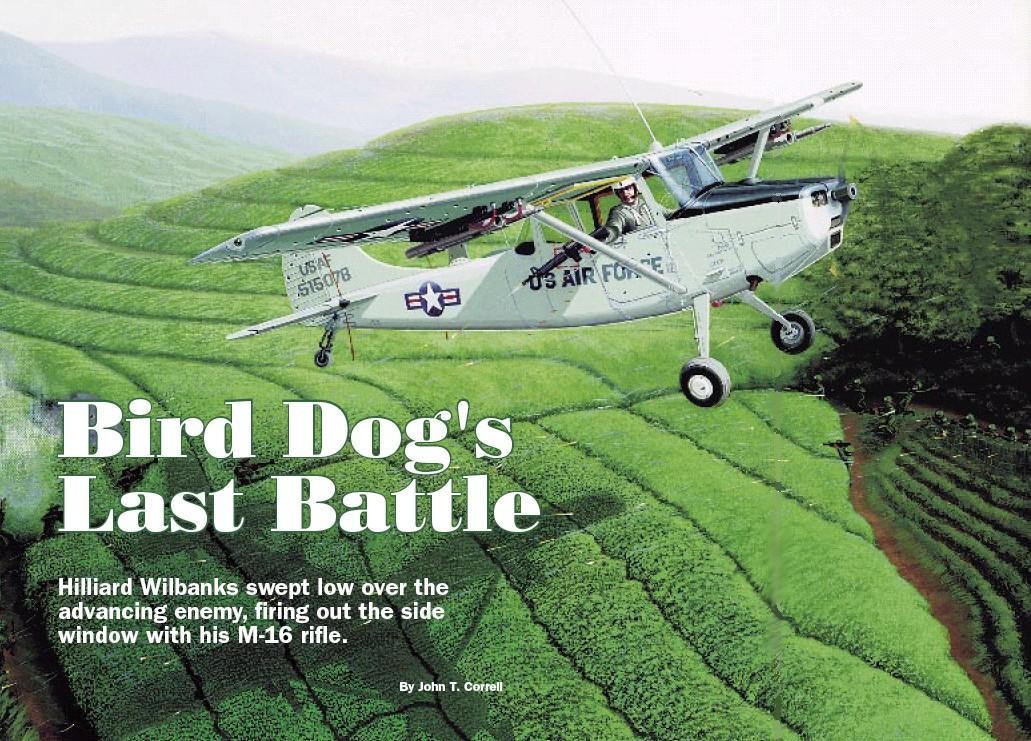
An Air Force Art Collection painting by Stewart Wavell-Smith, "FAC Tea Party," depicts Wilbanks' last mission.
airforce-magazine.com/MagazineArchive/Documents/2007/March%202007/0307battle.pdf
March 2007 , Vol. 90, No. 3
Hilliard Wilbanks swept low over the advancing enemy, firing out the side window with his M-16 rifle.Bird Dog's Last Battle
By John T. Correll
Habersham County is nestled in the foothills of the Blue Ridge Mountains in northeastern Georgia. The population today is only about 36,000. Forty years ago, it was even less, but despite that, seven of Habersham's sons lost their lives in the faraway war in Vietnam. One of them, Hilliard Almond Wilbanks, was posthumously awarded the Medal of Honor.
Hilliard Wilbanks grew up in the small town of Cornelia, where he played the piano at his church and was right guard on the football team. Opportunities in Cornelia were limited, so when he finished high school in 1950, Wilbanks enlisted in the Air Force. He then served almost four years as an air policeman in Strategic Air Command.
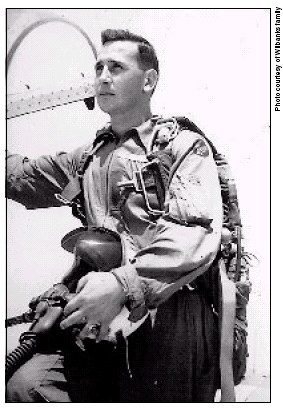
Wilbanks in 1955 was a second lieutenant [2LT] undergoing basic training at Laredo AFB, Tex. (Photo courtesy of Wilbanks family)
In 1954, Wilbanks qualified for the aviation cadets, and in 1955, he earned his commission and pilot wings. His first duty as an officer was as a T-33 instructor pilot at Greenville AFB, Miss. Subsequently, he was an F-86 Sabre pilot and an aircraft maintenance officer in Alaska and Nevada. In 1966, he trained as a [n] [Airborne] forward air controller at Hurlburt Field, Fla., and went to Vietnam, where he flew the O-1E Bird Dog.
By Feb. 24, 1967, Wilbanks had flown 487 combat missions. He had already received the Distinguished Flying Cross and 17 Air Medals. He was scheduled to finish his tour and leave Vietnam on March 18. He already had orders for Laughlin AFB, Tex., where he would have been an instructor pilot in the T-37 flight training program.
He was eager to see his wife and four children, including twins who were born two weeks after he had left the United States for Vietnam. He had survived almost 11 months of dangerous duty, but his luck was about to run out.
No Guns, No Armor
The Air Force's forward air control system was disbanded after the Korean War and had to be rebuilt in 1962 for Southeast Asia. In Vietnam, there were no regular battle lines. Typically, enemy forces and targets were concealed by jungle cover and the situation on the ground was difficult to see from the air.
To help pilots put their ordnance on target and to lessen the risk of hitting allied forces and civilians, the rules of engagement required that all ground attack strikes in South Vietnam be directed by a [n] [Airborne] forward air controller. FACs flew low and slow in small spotter airplanes, conducting visual reconnaissance in the same area every day. They became familiar with the terrain and regular activity in their sector and thus would notice if any big changes took place. They knew the places where an enemy might hide. FACs were based with the Army units they supported, so the forces in action below were not strangers. Like Wilbanks, most FACs had previously flown fighters, so they also understood the problems and capabilities of the strike flights.
The first FAC aircraft in Vietnam was the lightweight Cessna O-1E Bird Dog. It could reach 150 mph in an emergency, but the normal cruising speed was 104 mph. The Air Force first obtained Bird Dogs from the Army, where they had been in service since 1950 with the designation L-19. The O-1E had two seats, but FACs usually flew alone. The Bird Dog carried no ordnance except four 2.75-inch white phosphorous smoke rockets, used to mark targets. Small-arms fire from the ground could easily penetrate the cockpit. Later in the war, FAC aircraft would add armor and weapons, but in the early days the pilots were starkly vulnerable. Fortunately, the Viet Cong understood that the FACs directed the attack fighters. To avoid bringing down an air strike upon themselves, they seldom shot at the FACs unless an engagement was already in progress.
At this stage of the war, FACs had a divided command structure. They were assigned to a support squadron at an air base for administration, maintenance, and supply. However, they lived with the Army, and their mission orders came through a different chain. The FACs' operational boss was an air liaison officer, or ALO, attached to an Army headquarters. Wilbanks was assigned to the 21st Tactical Air Support Squadron at Nha Trang, but, in actuality, he worked for the ALO for the Central Highlands, Lt. Col. Norman Mueller. Mueller-a FAC himself-was attached to the U.S. Army advisory team working with the South Vietnamese 23rd Division, headquartered at Ban Me Thuot.
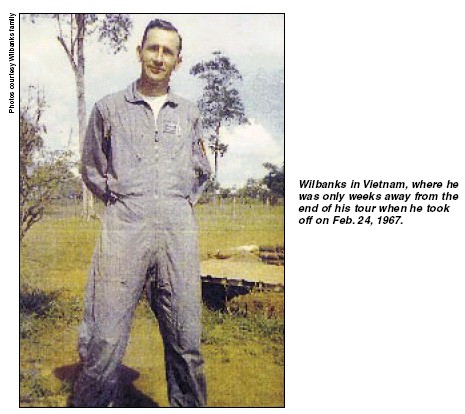
Wilbanks in Vietnam, where he was only weeks away from the end of his tour when he took off on Feb. 24, 1967. (Photos courtesy Wilbanks family)
Mueller and his FACs were responsible for the southern half of II Corps, the largest of the four military regions in South Vietnam. Their area covered seven provinces, about 10,000 square miles. Normally, Mueller had about 30 x FACs, but replacements had been slow in arriving and in February 1967, only 12 were assigned. They flew numerous missions every day. "There were no holidays," Mueller said.
For most of his time in Vietnam, Wilbanks had been the senior sector FAC at Bao Loc, a provincial capital on the southwestern flank of the Central Highlands, about 100 miles north of Saigon. As the end of his tour approached, though, an opening occurred at Da Lat. "I reassigned Captain Wilbanks there in recognition of his hard work," Mueller said.
Ambush at the Plantation
Da Lat, higher up in the mountains, was considerably cooler and less humid than the coastal plain. South Vietnam's military academy was there. The climate was ideal for growing vegetables for the Saigon market. At these higher elevations of the Central Highlands, plantations with chest-high tea bushes predominated. The cultivated areas were interspersed with jungle.
Yet the roads and the railway south were often disrupted and harassed by the Viet Cong. North Vietnamese Army units passed through the area regularly. The NVA infiltrated down the Ho Chi Minh Trail in Laos, cut through Cambodia, and crossed the border into central South Vietnam. To intercept the infiltrators, U.S. Special Forces manned outposts at 20-mile intervals and the 23rd Ranger Division of the South Vietnamese Army conducted regular sweeps in company strength or better.
On Feb. 22, 1967, an NVA battalion arrived in the area of Di Linh, about 15 miles from Wilbanks' former base at Bao Loc. There, the NVA regulars joined forces with the local Viet Cong. On Feb. 23, the communists captured a large tea plantation. They forced the owners and workers to help them build an ambush site on the two hills overlooking the road that ran north from Saigon to Da Lat. Laboring through the night, they dug hundreds of foxholes and several machine gun emplacements among tea bushes, all carefully camouflaged.
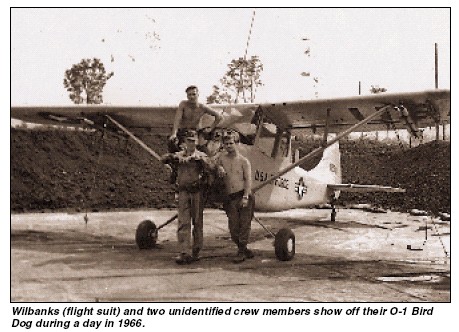
Wilbanks (flight suit) and two unidentified crew members show off their O-1 Bird Dog during a day in 1966.
The next morning, unaware of the ambush, the South Vietnamese army company stationed at Di Linh notified division headquarters at Ban Me Thuot that it was heading out for its regular sweep of the area. The company walked into the ambush at the tea plantation and was all but annihilated. The officers and the NCOs were killed. The radio bearer, who had been cautioned to never let the enemy capture his radio, threw it down a well behind the plantation house. Thus, the ambush was not reported. The NVA dragged the dead out of sight, penned up the survivors with the other captives, and reset the ambush. The day wore on and nothing was heard from the company. Around noon, two Ranger companies from Bao Loc set out to see what had happened. Capt. Daryl Westby, who had replaced Wilbanks as the sector FAC at Bao Loc, flew overhead reconnaissance. By late afternoon, Westby had flown three sorties but had not found either the missing ARVN company or the enemy unit.
Mueller, in his own O-1 Bird Dog, flew down from Ban Me Thuot to help. Army advisor Maj. Robert A. Snell came along in the back seat. They met Westby at Bao Loc. Mueller said they would take over the FAC job for a while to give Westby a break to eat and rest. Mueller was having trouble with the radio in his airplane, so he left it at Bao Loc and took Westby's Bird Dog instead. Mueller called Wilbanks, who was airborne near Da Lat, and asked him to come join the search. Wilbanks had flown hundreds of reconnaissance and combat missions in the area. "He knew the isolated communities, the trails, the streams, the formidable jungles, [the] Green Beret activities, the tea plantations, and the native travel and work patterns better than anyone," Mueller said.
At Di Linh, Mueller and Snell saw the Rangers from Bao Loc approaching the tea plantation. Everything looked normal. Two flights of F-4 Phantoms were orbiting overhead, awaiting a call to action, but they were very low on fuel and had to leave. The most logical place for the enemy to be was a wooded area to the southwest, and Mueller directed the F-4s to expend their ordnance there in a single pass. They did so and headed home to Cam Ranh Bay.
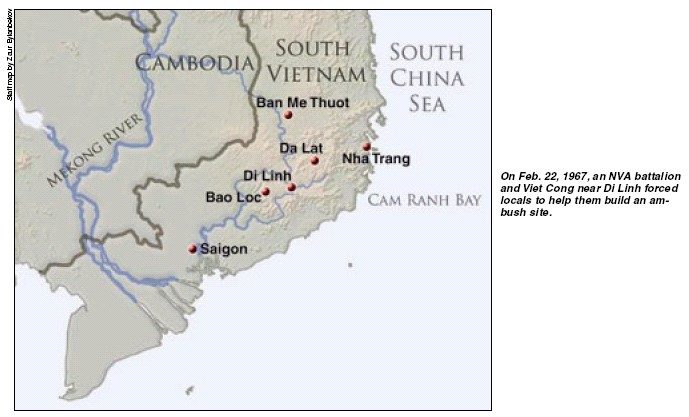
On Feb. 22, 1967, an NVA battalion and Viet Cong near Di Linh forced locals to help them build an ambush site. (Staff map by Zaur Eylanbekov)
The Trap Is Sprung
Wilbanks arrived and checked in with Mueller, who was busy with the F-4 strike. As the 23rd Battalion Rangers approached the tea plantation, Wilbanks flew visual reconnaissance ahead of them. He was in constant touch by radio with Army Capt. R.J. Wooten, the senior American advisor. Three helicopter gunships were in the area in case Wilbanks needed them. Two more flights of fighters were on the way. Wilbanks scanned the familiar slopes of the hills overlooking the road, looking for signs of change. He noticed lots of them, including the camouflaged emplacements among the tea bushes.
He had found the enemy force. He radioed a warning to Wooten that the Rangers were walking into an ambush. The NVA was either monitoring the FAC radio frequency or else sensed that Wilbanks had seen them. Even though the Rangers were not yet fully in the crossfire, the NVA and Viet Cong opened up with everything they had. The trap was sprung.
Wilbanks quickly vectored the helicopter gunships onto the enemy positions. Wilbanks fired a smoke rocket to mark the target for the gunships as the whole hillside erupted with fire. "My unit had been advancing eastward and the lead elements were working up a slope unaware of the prepared VC positions just ahead," Wooten said in his report of the action. "When the VC battalion learned their positions were discovered, they opened up on my forces and the two FAC planes above with 60mm mortars, Czech 12.7mm machine guns, .30-caliber machine guns, American BARs, and countless shoulder weapons. Two of my companies were pinned down and the forward elements suffered heavy casualties."
Two miles to the south, Mueller was flying low over the area bombed by the F-4s, looking for signs of the enemy force, and calling in a report to the Bao Loc sector command post. He was on the UHF radio frequency used by the fighters and did not hear the exchange between Wilbanks and the Rangers on the FM frequency.
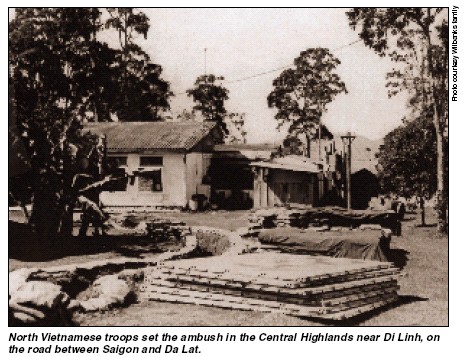
North Vietnamese troops set the ambush in the Central Highlands near Di Linh, on the road between Saigon and Da Lat. (Photo courtesy Wilbanks family)
Mueller did not know the enemy battalion had been flushed until a stream of .50-caliber tracers swept within a few feet of his airplane. Mueller put the Bird Dog into a vertical bank and pulled through several four-G turns before eluding the tracers. Then a second gun on the other side of the road opened up. This time, the tracers tracked Mueller for more than a mile before he ducked low behind a clump of trees to get away from them. Meanwhile, the helicopter gunships, directed by Wilbanks, attacked the enemy positions and momentarily suppressed the ground fire. However, one of the helicopters took a .50-caliber hit in its hydraulic system. The pilot reported he might not be able to make it back to base. Wilbanks released the other two helicopters to accompany the damaged one as escorts.
Wilbanks Presses the Attack
The NVA and Viet Cong, seeing the gunships leave, boiled out of their foxholes and launched a fresh attack. They charged down the hill toward the exposed forward elements of the Ranger force.
The fighters would not arrive in time to help. Whatever was to be done from the air, Wilbanks would have to do himself. He took the Bird Dog down in a dive and fired a white phosphorous smoke rocket into the middle of the enemy ranks. That stopped the advance temporarily as the NVA turned their attention and fire toward the small airplane. Wilbanks attacked again, but his supply of rockets was soon gone.
The only weapon he had left was his M-16 [5.56mm] rifle, which he carried for self-defense in case his airplane was shot down and he had to defend himself on the ground. Three times Wilbanks swept low above the enemy force, firing his rifle on full automatic out the side window and changing clips between passes. The M-16 was not in the same league as regular aircraft armament, but on full automatic, it spat out 700 rounds a minute and at the altitude Wilbanks was flying, the ground was well within lethal range. It was sufficient to slow down the NVA and Viet Cong and give the Rangers a chance to withdraw to a safer position.
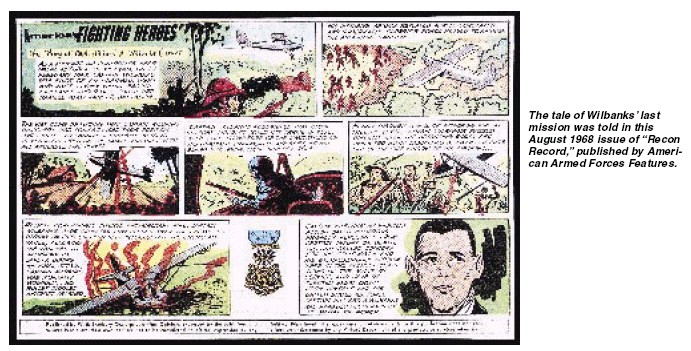
The tale of Wilbanks' last mission was told in this August 1968 issue of "Recon Record," published by American Armed Forces Features.
Despite his evasive maneuvering, Wilbanks was an easy target for the enemy rifles and machine guns. "Each pass, we could hear his plane being hit," said Wooten. Mueller, having shaken off the tracers, turned back toward the plantation and saw Wilbanks ahead, diving and jinking over the worst areas and firing on the enemy. "Twice I advised him to break it off and get some altitude, but got no response," Mueller said.
When the jinking movements stopped, Mueller knew that Wilbanks had been hit. "We joined on his left wingtip and could see his helmet slumped forward," Mueller said. "He was either unconscious or already dead. ... We flew in loose formation until he crashed."
"On the last pass, I estimate he was only 100 feet off the ground and directly over his objective," said Army Capt. Gary F. Vote, another American advisor. "He began making what appeared to be erratic moves, going first up, then down, then banking to the west. He then flew over my position. At this time, I felt he was wounded and looking for a friendly landing site, so I jumped up and waved my arms. However, as his plane banked again to the south, I could see that he was unconscious. His aircraft crashed 100 meters from my position."
Mueller reported, "The plane flew into the tea bushes at a very shallow angle and flipped onto its back right between the opposing forces." Mueller noted the time as 6:04 p.m.
Rescue Too Late
Wilbanks was still alive when Vote and two other Rangers got there. They cut away his harness and pulled him out of the bullet-riddled airplane. However, the Rangers and Wilbanks were pinned down beside the wreckage by intense fire from the hillsides.
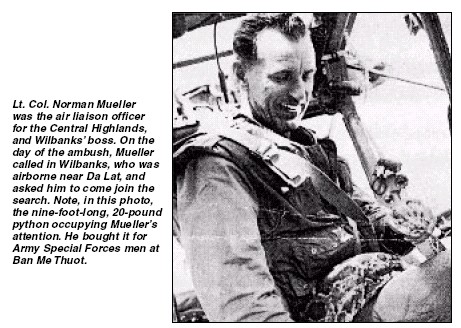
Lt. Col. Norman Mueller was the air liaison officer for the Central Highlands, and Wilbanks' boss. On the day of the ambush, Mueller called in Wilbanks, who was airborne near Da Lat, and asked him to come join the search. Note, in this photo, the nine-foot-long, 20-pound python occupying Mueller's attention. He bought it for Army Special Forces men at Ban Me Thuot.
Mueller summoned back the two helicopter gunships that had left on escort duty. They came sweeping in to attempt the rescue, but took heavy battle damage from the ground and had to pull out. Mueller put out an urgent call for "any Dust Off" (medevac helicopter) within reach of the area. An unarmed UH-1 Huey, airborne in the vicinity of Da Lat, responded.
To get in, the helicopter would have to avoid the kind of withering fire that had driven off the gunships. Mueller had the Huey approach from the west with the glare of the setting sun behind it and in the eyes of the gunners on the ground. To draw away the attention and fire of the enemy, Mueller made a pass at "moderately low altitude" on the eastern edge of the NVA position, then doubled back for another pass several hundred feet higher.
The distraction worked. The Huey swept in, almost without opposition, and picked up the Rangers and Wilbanks.
By this time, the strike forces had arrived and they obliterated the enemy position. The NVA withdrew to the south, pursued into the night by F-4s, F-100s, and A-1s, aided by AC-47 gunships dropping flares. The Huey headed to Bao Loc and medical help for Wilbanks, but it was too late. He died en route.
The Rangers lost 36 men in the ambush at the plantation, but it could have been much worse. The commander of the Rangers said later, "If it hadn't been for Captain Wilbanks' harassment of the enemy, my losses would have been two or three times as large."
"He did everything he could to stop the VC from taking our forward squads," said Sgt. 1st Class Clifton Tanksley, senior NCO advisor to the South Vietnamese Rangers. Tanksley had gone with Vote to pull Wilbanks out of the wreckage. "It looked for a while like nothing they could do would stop him because they were all firing at him. Me and all my men are proud to fight beside a man like him."
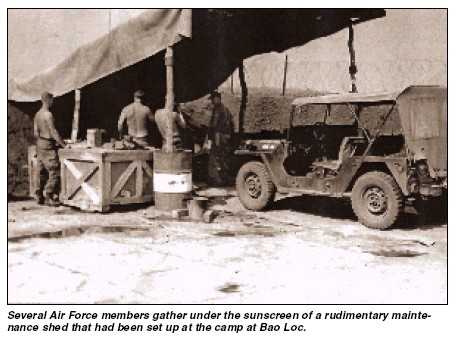
Several Air Force members gather under the sunscreen of a rudimentary maintenance shed that had been set up at the camp at Bao Loc.
Medal of Honor
The Medal of Honor was awarded posthumously to Wilbanks for his actions in this engagement. It was presented to his wife, Rosemary Wilbanks, at the Pentagon, Jan. 24, 1968, by Secretary of the Air Force Harold Brown and the Air Force Chief of Staff, Gen. John P. McConnell. She was accompanied at the presentation by her two older children and by her husband's parents. Norman Mueller, who was to be a steadfast friend of the family in the years that followed, was there as well.
The citation for the Medal of Honor said that "Capt. Wilbanks recognized that close support aircraft could not arrive in time to enable the Rangers to withstand the advancing enemy onslaught. With full knowledge of the limitations of his unarmed, unarmored, light reconnaissance aircraft and the great danger imposed by the enemy's vast firepower, he unhesitatingly assumed a covering, close support role. ... His daring tactics successfully interrupted the enemy advance, allowing the Rangers to withdraw to safety from their perilous position."
In 1984, the Air Force presented the town of Cornelia a reproduction of Wilbanks' Medal of Honor portrait that hangs in the Pentagon. It was placed on display in the town library.
Most of the memorials and remembrances came later, though.
In September 2000, the Forward Air Controller Memorial was dedicated at Hurlburt Field, honoring the 219 FACs who were killed in action in Vietnam. Wilbanks is recognized by a bronze plaque on a pedestal near an O-1E Bird Dog aircraft. Mrs. Wilbanks was there to place a wreath, as was Angela Bennett, whose father, Capt. Steven L. Bennett, an OV-10 FAC, had also been awarded the Medal of Honor, also posthumously, for valor in Vietnam. (See "Impossible Odds in SAM-7 Alley," December 2004, p. 52.)
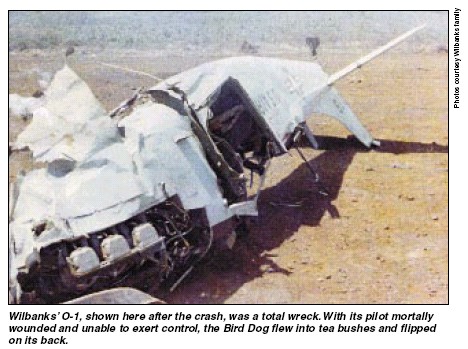
Wilbanks' O-1, shown here after the crash, was a total wreck. With its pilot mortally wounded and unable to exert control, the Bird Dog flew into tea bushes and flipped on its back. (Photos courtesy Wilbanks family)
In April 2001, Wilbanks was inducted into the Georgia Aviation Hall of Fame at Warner-Robins, Ga. It was a formal affair, at which Mueller spoke. Wilbanks' flying suit, blue service uniform, dog tags, notebook, and other personal items are exhibited there at the Museum of Aviation.
The Air Support Operations Building at Ft. Benning, Ga., was dedicated to Wilbanks in October 2001. Mrs. Wilbanks was presented the Vietnamese Ranger badge on behalf of the U.S. Ranger advisors. In September 2003, USAF Pilot Training Class 55-P, of which Wilbanks was a member, sponsored a granite bench with his name on it at the National Museum of the U.S. Air Force in Dayton, Ohio.
There have been numerous other remembrances as well. The most recent came at the new Air Force Memorial, dedicated in 2006 and overlooking Arlington National Cemetery and the Pentagon. Wilbanks' name, along with those of other Medal of Honor recipients, is prominently inscribed on a granite wall. Wilbanks' hometown of Cornelia built a six-foot-tall, two-sided, black granite memorial marker, dedicated in July 2001. On its sides are a laser-etched portrait of Wilbanks, an image of his O-1E Bird Dog, and the citation for his Medal of Honor.
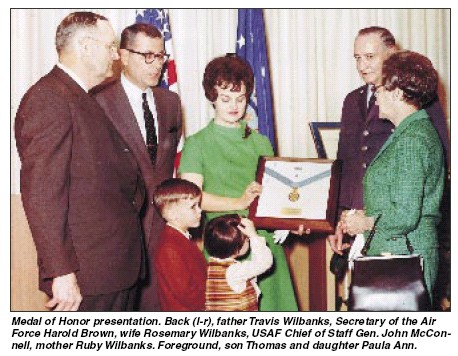
Medal of Honor presentation. Back (l-r), father Travis Wilbanks, Secretary of the Air Force Harold Brown, wife Rosemary Wilbanks, USAF Chief of Staff Gen. John McConnell, mother Ruby Wilbanks. Foreground, son Thomas and daughter Paula Ann.
Mrs. Wilbanks placed a wreath and the memorial was unveiled by the four Wilbanks children, Paula Ann Wilbanks Tharp, Thomas Eugene Wilbanks, and the twins, John Hilliard Wilbanks and Deborah Louise Wilbanks Almand. Several of the Hilliards' grandchildren were there, as were other members of the family. Norman Mueller spoke, recounting the events of the Medal of Honor mission, and Jonathan Myer, who had known Wilbanks in FAC training, sang his composition, "Willie Wilbanks' One-Man War."
Air Force F-16s flew overhead in the missing man formation, and the International Bird Dog Association conducted a flyover in O-1Es. A light rain was falling, but 1,500 people-almost half the population of the town-turned out for the ceremony. The monument stands on the grounds of the Cornelia Community House, some 250 yards from where Hilliard Wilbanks was born.
John T. Correll was editor-in-chief of Air Force Magazine for 18 years and is now a contributing editor. His most recent article, "The Pentagon Papers," appeared in the February issue.
So Who killed the U.S. Army's O-1 Bird Dog?
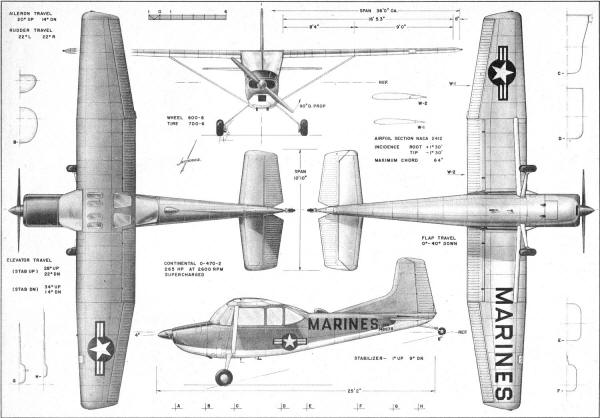
Why factions within the U.S. Army! the Dumb marines had improved Bird Dog IIs--but retired them, too!
Compare what we know is true today with the typical BS Army defeatist crap you gotta love--straight from their Transportation Museum at Fort Eustis, Virginia!!
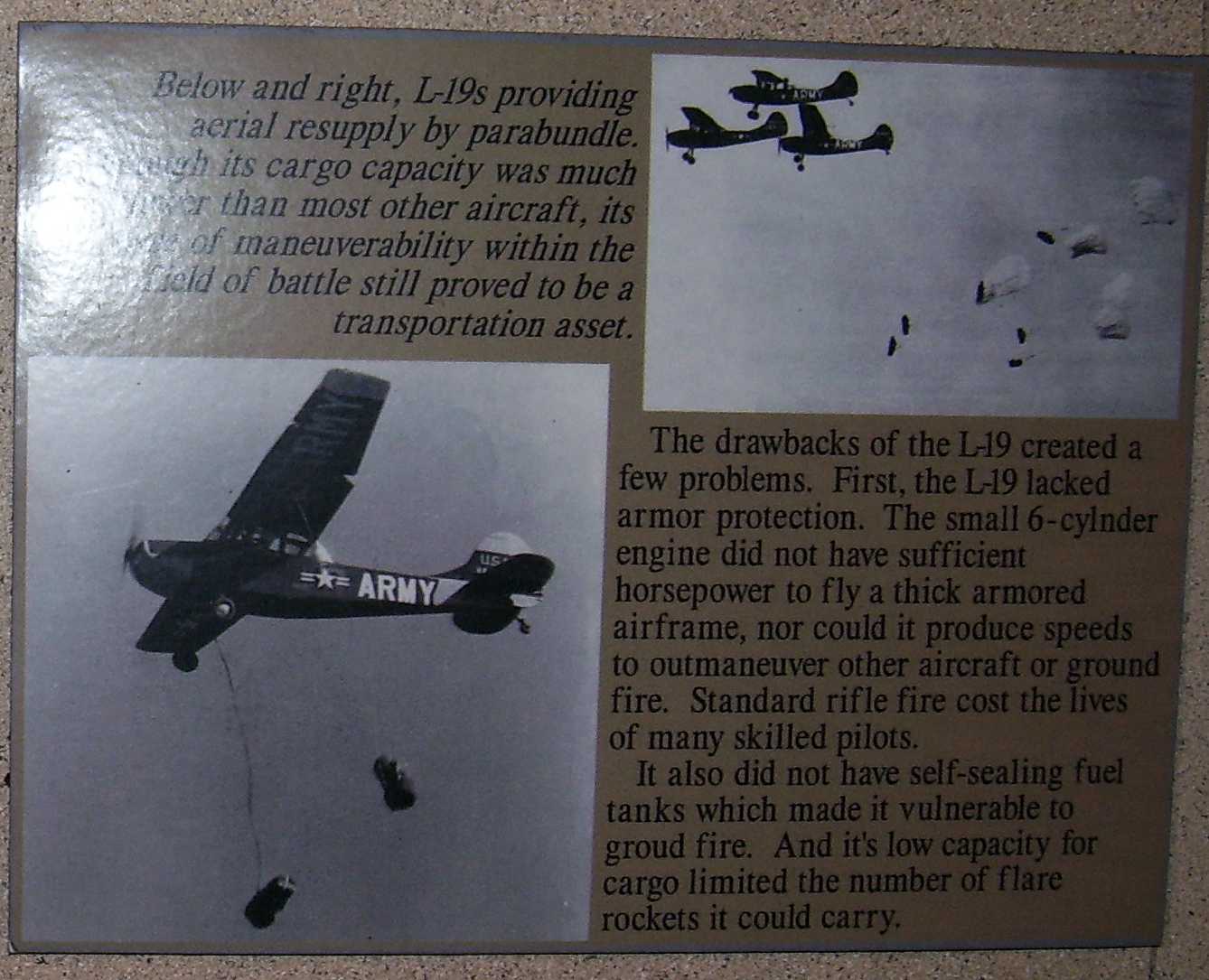
1. Dark Green Army Bird Dogs lack power and speed to avoid ground fire from enemy looking up at them against the blue sky (hint, hint)
2. Bird Dogs lack power to have armor protection or carry much parabundle payload
3. Bird Dogs lack self-sealing fuel tanks to keep highly volatile gas fuel from exploding...
You then mosey on down (walk) to the other side of the museum and lookee here what you find?
Why its a fuking PT6 turboprop engine!
Powering the Army's UV-18 Twin Otter (flew into survey landing site for Desert One Iran rescue in 1980), the C-12 Huron, U-21, even the LACV-30 hovercraft...so you mean to tell us the U.S. Army WAS NOT aware of the PT6 turbine engine?
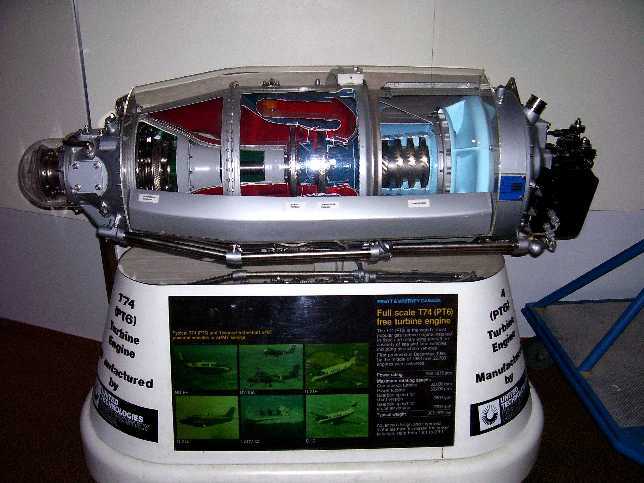
The world's most used turboprop that could give a Cessna 170 ehh O-1 Bird Dog all the fuking power (550 shp) and speed required to carry more payload, dodge enemy fire assuming we are smart enough to PAINT IT IN SKY GRAY CAMOUFLAGE....and add self-sealing fuel tanks for the less volatile JP-8 turbines use and have an ARMORED bullet proof body....
Nahhhh!!!!
No, it sounds like to us the "rotor-heads" by 1974 had taken over the Army Aviation reigns and they didn't want the easy and affordable Bird Dog to be improved--lest their fuking helicopters would have a competitor for the scout role...so they squeezed out the Bird Dog by benign neglect...now we don't have Shiite that can fly continuously 24/7/365 over Iraq to keep an eye on the Shiites..what a pile of Shiite, huh? We need a MANNED observation/attack plane for "Aerial tracking" in a SASO/COIN sub-national conflict...we would already have it if we had not retired our Bird Dogs...doesn't a "tracker" need a "Bird Dog", anyway?
WHY are we replacing the OH-58D Kiowa Warrior (Bell Jet Ranger) with the ARH Model 407 (Bell Long Ranger), both helicopters, loud, noisy, slow, unarmored, painted in the wrong damn dark green color.... ???
Its pretty well established that we could have and should have instead a LARA STOL type O/A fixed-wing plane instead; a "Bird Dog II". What if someone could have talked sense int othe U.S. Army in the 1970s? Let's take a look.
Revisiting the O-1 Bird Dog with the Landing Party of the U.S.S. Enterprise
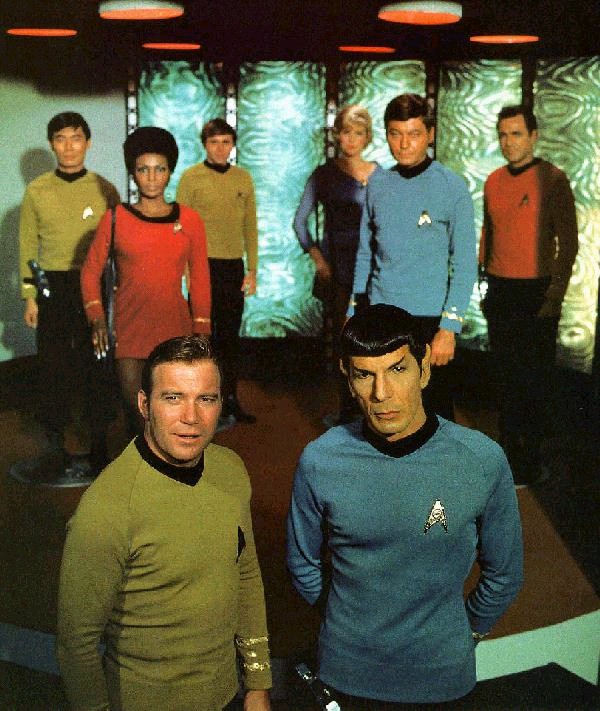
Let's join Captain Kirk, Dr. McCoy and Spock and the other guy "Bailey" (who is designated to die in event of any phaser firefights) as they jump through the time portal and go back in time to 1970.
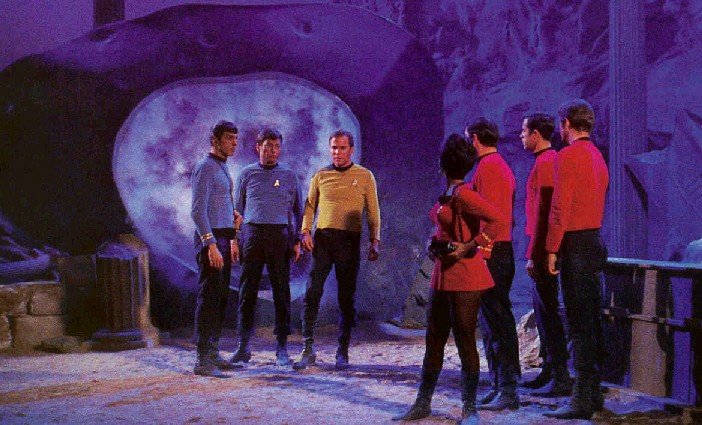
The place is the Pentagon, of course. A hole in the wall has magically supplied them with "costumes" of the late 20th century before Scotty beamed them down to the planet.
BRRRRRRRRRRRRRRR
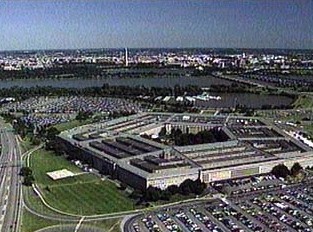
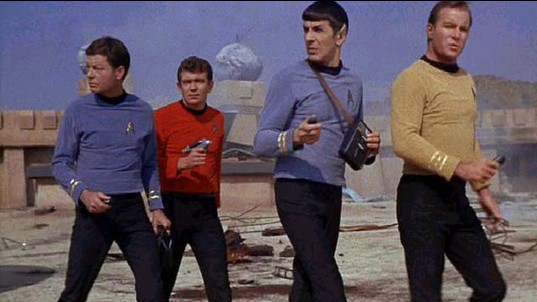
Kirk, Spock, McCoy are now in the corridor of the Pentagon by the I-Love-Me Wall of Secretary of Defense (SecDef) portraits. Melvin Laird walks by, "Can I help you gentlemen?"
Kirk: "Yes....Sir. We are looking for the Army..."
Spock: "Chief of Staff's office"
SecDef Laird motions to the directory sign. "You can look it up over there. But wait, I will have my marine guard show you, he's not doing anything".
The Star Trek team is escorted by a young marine corporal to the Army Chief's office.
Spock: "The Vietnam war is still raging at this time. They are having trouble finding the enemy who hides in closed vegetated terrain in Vietnam".
McCoy: "Damn it, Spock, must you be so logical? Our boys are dying over there".
CPL: "You guys must not be from around here. Where are you from? Aren't those English uniforms? Vietnam is a---pardon the expression---shit hole. They hear us coming for miles away in our choppers or sit and wait when we hump up to them, then ambush us"
Kirk: "Hump? Spock, what does he mean?"
Spock: "This is a pejorative term for walking with large amounts of weight on your body seriously draining your energy and slowing down your speed so you are easily targeted by the enemy"
CPL: "Man! that's one way of saying it!"
The Trekkers enter the chief's office.
Kirk: "we are here to see the Chief, we are experts in Counter-Insurgency Warfare"
The secretary smiles and laughs.
"We see a lot of them these days!...do you have an appointment?"
Kirk looks at Spock befuddled.
McCoy is outraged. "You guys didn't schedule an appointment?"
PART 2
Teaser from last week's episode:
The Landing Party is in the office of the U.S. Army Chief of Staff circa, 1970. In period costumes of the Royal Navy.
Kirk looks at Spock befuddled.
McCoy is outraged. "You guys didn't schedule an appointment?"
Fade to the U.S.S. Enterprise in
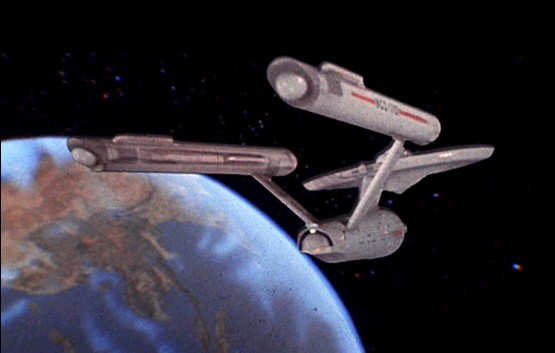
"space....the final frontier....these are the voyages of the....."
Theme music
Fade back to the Pentagon...
The secretary as efficient as ever, looks down at her appointment book.
"I can get you in right now for about 15 minutes"
Kirk is ecstatic.
"Who shall I tell him is here?"
Kirk replies as he straightens his tunic;
"Captain James T. Kirk, 1st Officer Spock and Ship's doctor McCoy. Our escort Ensign Bailey will wait out here with you if that's ok?"
The attractive secretary looks over Kirk's bod approvingly as she gets up and tells them she'll be right back.
Kirk: "I think I'm going to like being in the 20th century"
McCoy: "Don't get too comfortable, you have a ship, remember?"
General William Westmoreland shakes their hands and invites them in to sit at his conference table.
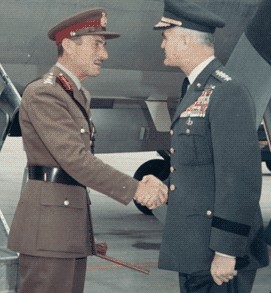
Kirk: "we are from the Navy..."
Spock: "British Navy..."
Kirk: "We have been watching your history.."
Spock: "Operations in Vietnam"
Kirk: "We see that you plan on retiring your O-1 Bird Dog observation aircraft and make up for it by using loud helicopters, which will be a big mistake, you are going to need it in future wars"
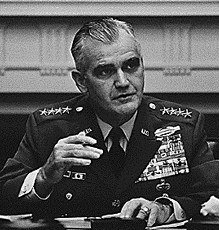
Westmoreland: "We are under tight budget pressures to cut back, the war has cost us a lot in men and materiel...my aviators say the new LOACH helicopter can take up the slack"
Spock: "That is fundamentally incorrect, sir. You have over 425 Bird Dogs now over Vietnam plus Forward Air Controllers like the Ravens in all kinds of fixed-wing observation/attack aircraft that have enabled you to date to keep track of the enemy, if you go to all helicopters, the enemy will elude you and by 1974..."
Kirk cuts Spock off from revealing too much information and that they are from the future...
Kirk: "what we are saying is that experiences in Malaya have shown you need to patrol large areas at a time to catch....the....enemy...before...he...can break the peace"
Westmoreland: "Does he always talk that way, your captain? How do you know about the Ravens in Laos, they are top-secret?"
Kirk and Spock shrug.
Westmoreland: "Anyway, Bird Dogs fly with volatile aviation gasoline and are unarmored, they are not survivable. My aviator guys say they can fly low just above the tree tops, what they call, 'nap of the earth' and avoid enemy ground fires"
McCoy: "General, you are on track before this war is over to lose over 4 THOUSAND helicopters, half in accidents, the other half shot down. Our men need observation that doesn't get its ass shot down, so we can get them before they get us".
Westmoreland: "I have heard your arguments, we have no choice, the Bird Dog has had it, we're going to retire it in favor of helicopters...the Air Force never wanted us to have them in the first place..."
Kirk sensing their mission is at a loss, stands up.

Kirk: "Wait sir, one last thing. This isn't about the Army...or the Air Force...or even the Navy...its about US. The United States of America...a nation...that has the technology or will have the technology...to make that Bird Dog fly faster...farther...and with armor protection. Turbine engines don't need AVGAS, Sir...have some faith in the American people that they will provide you the technology to keep the Bird Dog dominant over the battlefield...we can do this...future generations are counting on you...."
Westmoreland: "I should have you over here on exchange duty as my speech writer....I will consider it. Thanks for your time."
Kirk, Spock, McCoy with Bailey in the lead, leave the Pentagon.
Spock opens his tri-corder. "The portal should open any minute now, by that personally operated vehicle called a 'Pinto'".
McCoy: "Don't you mean a car, Spock?"
Spock: "Yes".
The landing party jumps through it and vanishes while a guard watching a closed circuit TV camera sees them disappear.
Guard: "I need a break. Where did they go?"
U.S.S. Enterprise circling around the planet.....
Kirk in his captain's chair.
Kirk: "So Spock, whatever happens to that O-1 Bird Dog?...did we violate the prime directive?"
Spock looking into his ship's history banks, replies.
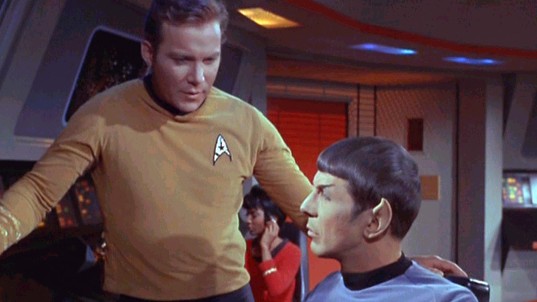
"I'm getting mixed signals. The Americans pull out from Vietnam and pass on their helicopter-centered warfare style on to the South Vietnamese but its too hard for them to maintain and doesn't give them appreciable overmatch against the North Vietnamese who regroup and invaded in 1972 and in 1975 until they succeed".
Kirk: "Continue"
Spock: "Where the Bird Dog helps is in later wars. Westmoreland doesn't retire it, but puts money into it and has turbine engines and armor fitted. He gets into a fight with the Air Force chief but prevails. He even has the wings fold so Army units can tow it by a truck or a M113 armored personnel carrier, later known as a 'Gavin' by proponents of the one technique of warfare that was successful in South East Asia".
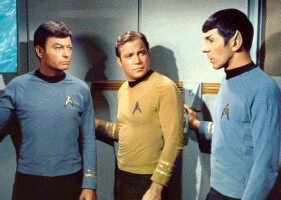
McCoy: "Did we save any lives? Must you be so logical all the time, Spock?"
Spock: "Why of course, it would be illogical if I were not"
Kirk: "If I remember my U.S. history correct, they go on to invade Iraq needlessly under the misguidance of the neocons after the 9/11 attacks, but the new Bird Dogs were critical in preventing the rebels from laying land mines, saving many lives, we don't know how many exactly. By the time the American people impeached the corrupt junior Bush in 2007, the Soldiers were able to hang on in Iraq with less than 900 dead before pulling out....that's pretty good for a counter-insurgency"
Spock: "Estimates are that if the Americans had opted for the helicopter-only approach after Vietnam they would not have had effective air surveillance over Iraq while running daily "presence patrols" in wheeled trucks easily blown up by rebels on roads they couldn't avoid...by 2010 the country would have went bankrupt and the easily ego-manipulated marine corps would have been sent in to shoot protesters back home surrounding the White House of the next neocon president McCain illegally elected by rigged computer voting machines. The American death toll would have been 10, 000 or what the Soviets suffered in Afghanistan."
McCoy: "Thank goodness we were able to reason with the Army. No one would be so stupid to do that"
All chuckle.
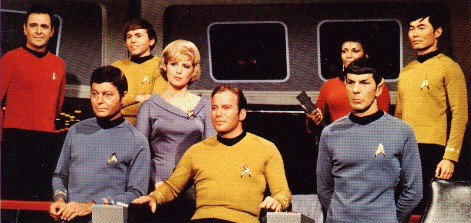
Kirk: "Mr. Sulu, Warp factor 1, take us out of here"

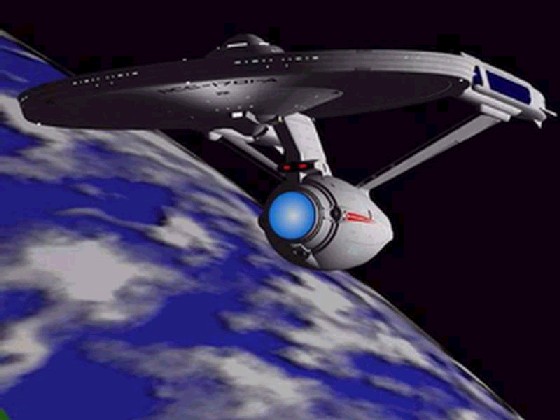
THE END
Now for the quaint, "politically correct" Bird Dog history...courtesy of the U.S. Army Transportation Museum...
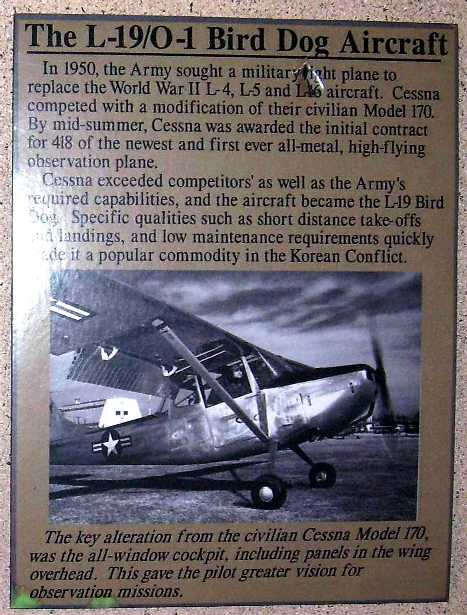
Bird Dogs could Land Anywhere...ask Bush pilots up north about STOL flying (capability lost)
Fuel blivets can be towed by a ground vehicle over soft terrain. We even had giant fuel blivet tires that could float on the water and be towed on roads at high speeds.
Why not fit a STOL o/a grasshopper plane with ruggedized bush tires and fill them with DIESEL FUEL and as the diesel engine uses the fuel from them nitrogen is pumped back in to maintain pressure for landing? If the rear wheel was enlarged to float, perhaps the entire aircraft could land on water for recon team insertions/extractions....
Bird Dogs could lay communications wire (capability lost)
Bird Dogs are easy-to-maintain and inexpensive to operate so WHEN WE NEED SOMETHING IN THE AIR IT CAN GET INTO THE AIR TO DO THINGS LIKE SPRAY TO DEFEAT BIOLOGICAL ATTACKS...(capability lost)
The Cessna Bird Dog was the most popular light aircraft used by the U.S. Army for liaison and observation in the post-war period. More than 3,500 machines left the assembly lines from the end of 1950 and remained in service until the late 1970s, taking part in the Korean War and Vietnamese War (see also History of the O-1 Bird Dog).
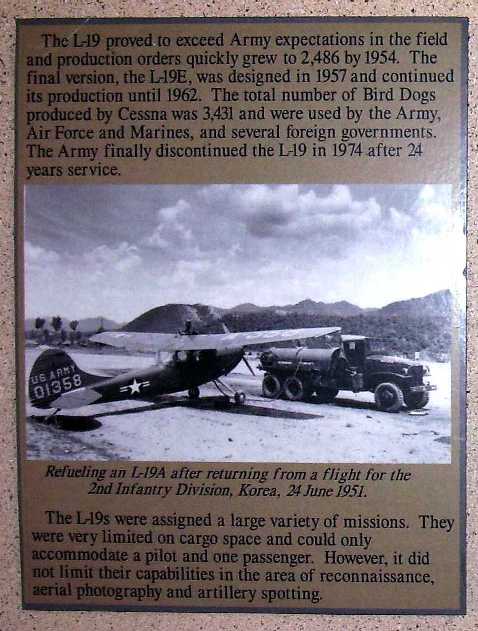
The Bird Dog was derived directly from the Cessna 170, a commercial model in production in 1950. From the first order for fourteen planes in June 1950, the numbers increased dramatically, until by October 1954 the total production of L-19As (as they were originally designated) was 2,486. Two years later another 310 TL-19D training planes were ordered, while in 1957 the final version appeared, namely the improved and more powerful L-19E, which brought the total production to 3,431 machines. In 1962 the different versions were renamed, in sequence, O-1A, O-1B, TO-1D and O-1E.
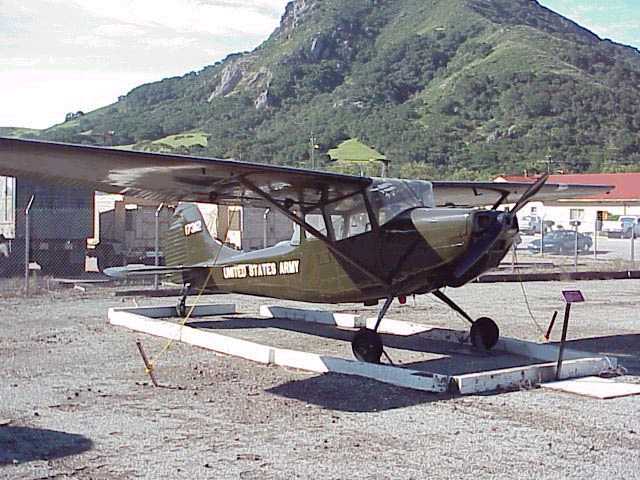
Few aircraft were as important for the efficient conduct of war operations in Vietnam as the small, unarmed Cessna O-1B, previously known as the L-19. Spearhead of the FAC (Forward Air Control), it formed part of the U.S. Army organization until 1965, when all fixed-wing observation aircraft were supposed to be turned over to the USAF [OV-1 Mohawks were swept under the rug as "sensor platforms"]. Flying at low-level and reduced speed, their duty was to discover objectives, for the most part concealed in the jungle, such as groups of guerillas, convoys traveling along the Ho Chi Minh Trail, or enemy units lying in ambush for unsuspecting government troops. Having spotted the enemy, they would immediately radio the DASC (Direct Air Support Center) which, as a rule, would be able to get attack aircraft to the spot within half an hour [EDITOR: TOO LATE. Targets need to be attacked IMMEDIATELY after being spotted by the man/men in the observation/attack plane itself] (see also Fire Support Coordination - Tactical Air Support). The latter were again guided by the Bird Dog pilots who, in addition to pinpointing the objective with smoke or magnesium flares, would check the effectiveness of the strikes, if necessary correcting the aim. However, the O-1s were an easy target for the enemy, who could often hit them with ordinary rifle fire, without recourse to heavy anti-aircraft fire. Many Bird Dog pilots lost their lives while carrying out their duty; they were usually officers with years of experience, veterans of many battles. Among the finest fighters, they succeeded in converting their little unarmed planes into formidable offensive weapons.
However, even early on the hubris of the Army helicopter enthusiasts failed in the heat of battle and Bird Dogs were brought to the forefront again:
http://vietnamresearch.com/air/aircraft.html
O-1F: Early Army combat experience in Vietnam pointed out quite forcefully the need for a fixed-wing Forward Air Control (FAC) aircraft to replace the OH-13 Sioux and OH-23 Raven helicopters initially used in that role. The two ageing helicopters were quickly found to be totally unsuited for observation work in the 'hot and high' conditions routinely encountered in Southeast Asia, and both the Army and USAF therefore fell back on the much more capable O-1. The Bird Dog's performance was excellent in comparison to that of the Sioux and the Raven, and the Cessna also had a far better maintenance record and considerably lower operating costs.
O-1F
The Army, for its part, decided to use the O-1 in the FAC role until a more suitable light helicopter could be introduced into service, and therefore procured limited numbers of O-1F and O-1G Bird Dogs on loan from the USAF. The O-1F was essentially a standard TO-1D that had been converted first to USAF O-1D FAC configuration through the deletion of its dual controls, and had later been further modified through the addition of underwing hardpoints and a VHF radio. Most O-1F aircraft operated by the Army were returned to the Air Force or turned over to the South Vietnamese following the November 1966 introduction into Vietnam service of the Hughes OH-6 Cayuse light observation helicopter (LOH). However, some examples of the O-1F remained in the Army inventory through the mid-1970s.
However, if something is good and institutionalized there is a chance it will be retained and improved. The vulnerability of the O-1 Bird Dog due to its low speed and lack of armor led to the creation of the ultimate "grasshopper" plane, the OV-1 Mohawk. The Mohawk can land and take off just like a Bird Dog to be co-located with ground troops for MAS. And it could attack what it saw like a P-47 fighter-bomber. Then again, the USAF assholes complained and the Army pussies knuckled under.
So even though Mohawks were extremely successful owned by ground maneuver divisions in Vietnam, they were taken from the troops and made into surveillance platforms for Corps and higher headquarters flown from air bases far to rear. The Mohawks were retired in 1996 despite being relatively little used with lots of life left. The smart Argentine Army uses them now.
The USAF half-heartedly did slow AFAC work with O-1s, then realized they needed something faster and did the cheapo O-2 Skymaster then the expensive OV-10 Bronco thing (couldn't buy OV-1s and admit that Army was right all along) until Vietnam ended. Forgetting all about the success of their F-100D "Misty" Fast FACs over North Vietnam, the USAF began to obsess about large nation-state wars against integrated air defenses (IADs--RAND's bogeyman) requiring planes at least flying 500 mph above 10K and "stealthy" and dropped the OV-10 slow AFACs. They had A-37 Dragonflies that could do both slow and fast FAC missions but their heart was never in helping the rival Army so they too were given away to more practically-minded foreign militaries. The result is today that the fabulous A-10 Warthog is hampered by a lack of ANY AFAC and the USAF so far has refused a back-seat AFAC observer to make it more effective at spotting targets. The USMC who backed out of the OV-1 program years before, populated by their own egomaniac flyboy club, then realized they needed such a plane for Vietnam as long as marine narcissists designed it, lest they be seen as admitting the rival Army was right all along. However years later, when some of their OV-10s were shot down in Desert Storm (no Army OV-1s were shot down) they too, gave up on slow AFACs for MAS and are now in the same mess as the Army despite all their chest beating how great they think their air/ground integration is. A short time later, the USMC gave up on two-seat OA-4 SkyHawks for fast FAC missions, too.
 BUILD-A-MODEL:
BUILD-A-MODEL:
fiddlersgreen.net/models/aircraft/Cessna-Birddog-Collection.html
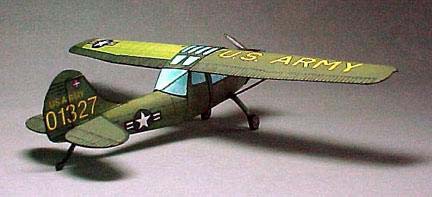
Cessna-Birddog-Collection
The Cessna L-19/O-1 Bird Dog is a liaison and observation aircraft. It was the first all metal fixed wing aircraft ordered for and by the United States Army since the U.S. Army Air Forces separated from the Army in 1947, becoming its own branch of service, the U.S. Air Force. The Bird Dog had a lengthy career in the U.S. military as well as in other countries. This is a downloadable cardmodel from Fiddlersgreen and comes in 12 different versions as of 9/09. $12.95
Perhaps------simple piston OH-13 and small turbine helicopters like the OH-6 "LOACH", UH-1 Huey and AH-1 HueyCobra in Vietnam were able to be temporarily co-located and be continuously flown overhead. I say "perhaps" because they were congregated into one huge aviation unit centrally located. Carlton Meyer believes small piston-engined observation & attack helicopters could be "Killer Bees" that swam all over the battlefield to dominate it.
However, they were also easy to shoot down in the stupid "Fulda Gap" green camouflage color we painted them in and their lack of armoring and sturdy fuel tanks and flight systems. We lost 4,000+ in Vietnam. Now we are losing GREEN helicopters in tank desert and blue sky Iraq.
From Bird Dogs to JetLongRangers: the deconstruction of U.S. Army Aviation

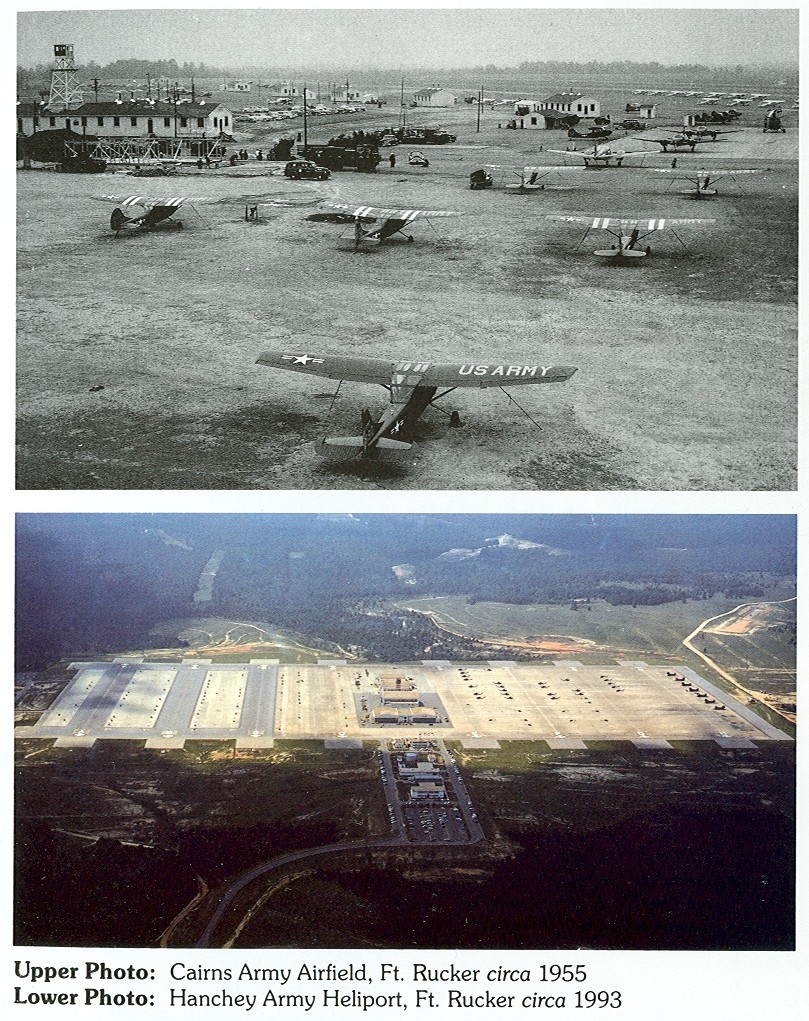
Compare the "progress" of going from SIMPLE, EASY-TO-MAINTAIN fixed-wing STOL Grasshoppers that could OPERATE IN THE FIELD to today's COMPLICATED, EXPENSIVE, DIFFICULT-TO-MAINTAIN, UNABLE-TO-OPERATE-IN-THE-FIELD VTOL helicopters of today. This is regress not progress.
Here's a very abridged history of American Armed Helicopters.
First common armament of helicopters was door gunners for self-defense. This was soon found to be inadequate. LZ suppression was attempted by fixed-wing aircraft, but at the time (early 60's) the USAF had few prop-driven aircraft capable of loitering. In order to save the airmobile concept Army takes over LZ suppression duties and develops heavily-armed versions of UH-1 utility helicopters. Partially successful, armed utility helicopters suffer from speed and loiter deficiencies due to vastly increased weight over non-armed helicopters. This lead to the specialist AH-1 gunship, more or less a more aerodynamic version of the transport, with no extra gear or cargo space for utility purposes increasing speed and loiter time. Combined with improving fixed-wing support by the USAF from A-1s, A-37s, OV-10s (which disappeared again as the war ended) this proved successful.
Army attention turned towards "the real war" against the USSR and saw the gunship as a way to provide its own rotary-wing CAS support. This lead to overly ambitious and complex Cheyenne helicopter which was cancelled fairly late in it's development (we will see this again!). Focus of cold war begins to direct attention more on the numerical armor discrepancy between NATO and USSR and the gunship is seen as possible anti-tank platform. This leads to the AH-64 Apache, well armed, armored and faster than AH-1 but much slower than Cheyenne and fixed-wing A-1, OV-1s, OV-10s, A-37s. Even then AH-64 is seen as very vulnerable on high threat battlefield leading to LONGBOW variant for stand-off radar Hellfire ATGM missile launches. For full effectiveness, Longbow needed to be used in conjunction with some sort of FO and scout helicopters were the Army's doctrine of the time. Army helicopter scouts of the time suffered from same deficiencies of the original armed utility helicopters, they were slower, had less distance and loiter time then the Apache. On top of this, they were also far less survivable on mid to high intensity battlefield. This lead to very expensive (by ARMY standards) Comanche helicopter system.
Designed to be faster, farther ranging, have a lower signature, more survivable if engaged then current scouts, and well-armed to deal with immediate threats. System was targeted by budget RMA hawks as a "cold war relic" (it was to some degree) it was canceled on the verge of being accepted into service (and that saves money how exactly again?). Army aviation now had a real crisis of aging airframes and limited utility capability emerging. Army's plan consists of procurement of Advanced (and who says the Army lacks appreciation of irony and sarcasm) Recon Helicopter (ARH) and Light Utility Helicopter (LUH). Makes sense at first glance except....chosen ARH the Bell 407 JetLongRanger is still not capable of going as fast, as far, or being nearly as survivable as the Apache. So what good is it and how does it save us money again? On top of that, LUH Eurocopter EC-145 selected is specified for ONLY DOMESTIC use by NG and state-side units. This increases our eroding and already insufficient transport and utility capability how?
Sooo... Armed utility helicopters work, except for when transporting large helicopter formations. For major helo airlifts, specialist escort gunships and fixed-wing support (that can loiter and make multiple passes) are needed. If the Army just needed another gunslinger why not have used the AH-60 Battlehawk? Commonality galore, better speed, range, weapons load, and survivability then the Army's armed scouts. If the Army truly wanted to address reduced lift and utility capabilities and to reduce operating costs and workload on the aviation brigades, why not have combined the ARH and LUH program to procure an armed utility helicopter (ALUH)? Still can act as manned eyes or armed reaction for brigade and has capability to perform a many of the internal brigade cargo helo missions, reducing wear and losses of larger more centralized Blackhawks. Please let the apologists explain that one to me, for I am at a loss for even a ridiculous rationalization.
The answer is that separate ARH + LUH = more human people in Army units getting salary or drill weekend pay. The over-riding function of military bureaucracies is to JUSTIFY THEIR EXISTENCE. 2 helicopters doing the job of one BETTER is true efficiency and that we cannot have. If the LUH had been the MD90 NOTAR it would have been a better combat scout than the loud, noisy Bell JetLongRanger chosen for ARH. IN fact, the Eurocopter is still better than the Bell JetLongRanger in terms of payload/speed to put more "icing" on a less than stellar cake.
Different helos = more Army units, more bureaucracy, more drain from Congress of tax dollars and egos to stroke being in command.
Disposible people deserve disposible helicopters, and trucks and tents.
We have become the Italian Army with a wannabe Nero as President without any Roman Legions!
The Romans didn't cart around crap with them when they went campaigning.
While post-Vietnam UH-60 Blackhawks and AH-64 Apaches are sturdier but now are far more complex; these helicopters are too difficult to keep flying, are still noisy and slow and painted in the wrong camouflage color; result?
NO MORE AIRCRAFT CO-LOCATION WITH GROUND UNITS AND BYE BYE MANEUVER AIR SUPPORT!
The militocracy of BS had finally squeezed the last vestige of functional reality from the pussified Army. Now we are buying crap helicopters in desperation to have something for folks to fly.
The Unmanned Air Vehicle (UAV) movement is nothing more than an unspoken attempt to get continuous flight overhead surveillance/observation but without having to face off the USAF and Army narcissistic egomaniac pilot "mafias" with the fact that both have fu*ked up miserably.
The problem is with the UAV "work-arounds" (unmanned Grasshoppers) is they do not "work"!
UAVs lack peripheral vision and investigative instinct that manned humans in the aircraft can provide = result U.S. troops no longer have effective Maneuver Air Support and they are dying at a rate of 2 a day in Iraq!
Here is an example from Iraq:
popularmechanics.com/science/defense/1214542.html?page=4&c=y
EXCERPT:
After six [mortar] rounds explode around Camp Fallujah, Ramshur takes a phone call from the Army 2nd Brigade Combat Team, 1st Cavalry Division--the Blackjack Brigade."Air's not available," Ramshur says to his crew. "Arty has the target."
The marines murmur. Artillery is an area-fire weapon, not a precision instrument. But it is all that is immediately available.
Saliba places the crosshairs of the Pioneer's optical camera on the mortar tube and reads off the 10-digit grid on the screen. The coordinates are sent to the Tactical Fusion Center and the Blackjack Brigade.
After several minutes, Ramshur finally says, "Shot out."
The marines crane forward to watch the explosion from a 155mm artillery shell fired from nearly 3 miles away. When a large gray puff pops up a football field away from the tube, the crew measures the miss distance and types in: Add one hundred, right fifty. That is, fire the shell 100 meters farther and 50 meters to the right.
Several minutes later, a large cloud of dirt erupts inside the courtyard. The crew's next command: Fire-for-effect.
A few minutes later, two bright orange flashes light up the courtyard, with a third about 100 meters to the south. When the smoke clears, the tube is still standing. The next volley delivers the same result--close but not effective. No secondary explosions. No visible damage to the tube.
During the ensuing lull, the three insurgents run from the safe house, pick up three mortar rounds, drop them down the tube and run back to the house.
"You wouldn't catch me playing dodge with 155s," one of the Watchdogs says.
Ramshur calls the Blackjack Brigade Intelligence Center, then tells his crew, "We're getting Predator."
Launched from a site near Baghdad, the Predator is 13 ft. longer than the Pioneer and packs a Hellfire missile with an 18-pound warhead. The most remarkable aspect of the Predator deployment is that a crew at Nellis Air Force Base in Nevada--7500 miles away--is guiding the UAV. A few weeks earlier, the Watchdogs helped a Predator destroy a moving pickup with a mounted machine gun--one robot leading another robot to the target.
"Break, break," Ramshur says. "Predator's been diverted. Anvil has the mission. Stand by for talk-on."
Anvil is the call sign for a flight of two marine AV-8B Harrier jets flying at 19,000 ft. Meanwhile, the insurgents make another round trip sprint. Twelve rounds have been launched at Camp Fallujah--each one with the potential to add to coalition casualties. The brass wants the duel to end.
"What do you think, guys?" asks Ramshur. "The tube or the house?"
"House!" chorus the marines.
The house where the insurgents are hiding between rounds has a dome roof, a walled courtyard and an overhang at the front door, where a sentry is posted. Once the Harriers close in, Ramshur radios the details of the house's location to a Forward Air Controller, who lines up the jets.
"The house is the first one north of the vacant lot on the northeast corner," Ramshur says. "Has a dome roof. Wait--it's where that truck is. Got it?"
A truck pulls up to the house and five men walk inside, carrying something in their arms.
"Supper time," says Sgt. Roneil Sampson, an imagery analyst. "They're changing shifts. Domino's delivery."
Ramshur reads a secure text message: Air is cleared hot.
Impact is less than a minute away. The courtyard door opens. A man walks to the truck and slowly drives off.
"Boot muj sent out to get the Coke," says one marine. "Luckiest bastard on the planet." Both video screens flash bright white, as if a fuse has blown. When the picture comes back into focus, the marines see that the center of the roof is now a huge black hole.
"Now that's what I call a shack," Ramshur says. "Great job, Watchdogs. Great job."
Operation al-Fajr continued for another 11 days--sector by sector, block-by-block, house-by-house--until the Multi-National Forces had secured most of the city. The death toll: 38 U.S. troops, 6 Iraqi troops and an estimated 1200 insurgents. By mid-December exiled residents began to return to their homes.
Another Revelation; Why can't we find the enemy: where are our air observers?
Studying recent conflicts, even those pitting nation-state force against nation-state force moving brazenly in the open, a disturbing truth emerges: WE CANNOT SPOT THE ENEMY FROM THE AIR. During Operation Anaconda, the USAF could not hit targets requested by 101st Soldiers. During Operation Iraqi Freedom, Rangers after parachuting in to take an airfield motor on to hold the Hiddith dam but had artillery rain down on them for days and these weapons were not silenced by air strikes. Its obvious to any honest student of military affairs that rebels are free to lay road side bombs in Iraq as our growing casualties prove. UAVs do not work; they do not see as well as a human being can and cannot actively investigate lest they crash even more than their current 50% rate. Why can't we find the enemy from the air?
Awhile back Army enlistedmen could be left-seat observers in Army scout helicopters and right seat observers in fixed-wing aircraft basically, Airborne Forward Air Controllers (AFACs). Not only have we since Vietnam wrongly discarded 2-seat observation/attack planes, replacing them with loud and slow helicopters often in the wrong camouflage color, we have also ELIMINATED THE ENLISTED AIR OBSERVER WHOSE SOLE MISSION IN LIFE IS TO STUDY HOW OBJECTS APPEAR FROM THE AIR. In a naked grab for power, Army Aviation Branch in the early 1980s discarded the enlisted air observer from the seat opposite pilots, replacing them with ANOTHER OFFICER. With the desire to build their own empire and Army Aviation becomes a branch (1983). Rather than keep the enlistedman observer they say they need two rated pilots who are WOs or full-fledged officers which expands branch clout. Now we have EVERYONE IN THE AIRCRAFT FOCUSED ON FLYING IT AND NO ONE FOCUSED ON FINDING THE ENEMY.
To interface ground maneuver units, Army aviation has OFFICERS without aircraft to fly to act as Ground Forward Air Controllers (GFACs), we can't call them what they are---people would understand what's going on and call us on our bullshit so like calling ISO shipping containers "conex boxes" they call these guys "LNOs".
1. We lose the SYNERGISM of enlistedmen WHOSE SOLE PURPOSE IS TO OBSERVE, NOT FLY BUT OBSERVE WHAT'S GOING ON THE GROUND.
Bye Bye a lot of ground detection fidelity! To find an enemy trying to hide from you (C3D2) you need to know your "beat" as it appears from the air during constant patrols--you can't do this if your mind is worried about aircraft emergency procedures as a back-up pilot.
2. These enlisted observers would also be IDEAL GFACs (not grounded pilot LNOs) on the ground when not IN THE AIR having focused on the art of detecting the elusive enemy.
3. If the pilot is injured or killed the enlisted observers can (swallow hard) BE PREVIOUSLY TRAINED IN HOW TO FLY A HELICOPTER IN AN EMERGENCY.
4. Army Aviation "branch" now that its got so much "clout" should step up to the plate and say:
WE NEED TWO FLIGHT CREWS PER AIRCRAFT FOR A BLACK AND GOLD ROTATION instead of trying to weasel it out of Congress by the two rated pilots BS and losing ground observation fidelity and an unmatched GFAC capability.
5. The U.S. Army needs to reinstate enlisted air observers to act as AFACs in existing OH-58D Kiowa Warrior and ARH Bell 407 scout helicopters, and as GFACs on the ground to help maneuver units find the elusive enemy.
6. The U.S. Air Force needs to modify many of its A-10s into two-seat versions to have their own enlisted AFACs/GFACs in the back to help locate, identify and verify targets. One option would be to CO-OPERATE with the Army and have Army enlisted observers fly in the back to act as AFACs when not on the ground as GFACs organic to the BCT's RSTA (defacto Cavalry) squadron. Either way, the USAF needs to fully exploit the A-10 with a back-seat observer and start doing its CAS job or relinquish it to the Army to do.
7. The Army needs to trailer and container mobilize all its helicopters for rapid deployment and forward location operations to better support ground maneuver elements by conserving fuel and flight time.
8. Each Brigade Combat Team should have some easy-to-maintain, fixed-wing STOL "grasshopper" observation/attack aircraft like the Thrush Vigilante 2 under their direct control in the (Artillery) Fires unit to insure they have Maneuver Air Support (MAS) out to their front. Targets found by the AFACs in Vigilante 2 Grasshoppers but beyond their light gun and rocket weaponry to dispatch would be handed off to Army AH-64s and/or USAF A-10s to fully destroy.
9. A ground-mobile MD-900 stealthy NOTAR LUH helicopter detachment for resupply, MEDEVAC and recon team insertion/extraction in the Headquarters is also needed.
strategypage.com/articles/3IDAAR/chap13.asp
Chapter 13 Aviation Operations
Third Infantry Division (Mechanized) After Action Report - Operation Iraqi
Freedom
Army aviation played a key role in the defeat of the Iraqi regime and bringing freedom to the Iraqi people. The speed and flexibility of Army aviation directly contributed to the success of the division and proved invaluable during Operation IRAQI FREEDOM (OIF). This chapter addresses the issues that require immediate attention to enhance our capability to support Army aviation across the operational continuum.
Lessons Learned
Divisional attack helicopter battalions are best suited to conduct close attack operations and shaping operations in the heavy division The responsiveness of Army aviation is directly linked to the command and control architecture and the nested long range communications available Army Transformation Initiative (ATI) degraded the general support aviation available to support the division Close combat attacks and enroute combat maneuvers must be included in our training base The aviation support battalion lacks depth in the current MTOE to sustain all tactical logistics (TACLOG) functions in support of the brigade Long range communications must be procured to overcome and sustain continuous offensive operations Close attack operations require enhanced optics to acquire and identify with confidence threats on the battlefield beyond the three kilometer capability of our current forward looking infrared (FLIR) Army aviation must expand its capability in doctrine, training, and resourcing to address the shortfalls in liaison operations
Topic A - Liaison Officer Distribution and Equipment Requirements
Issue: Aviation liaison officer distribution and equipment requirements
Discussion: 4th Brigade was fortunate that the attack battalion had additional captains to augment the increased demand for aviation liaison officers (LNOs). In addition to the position of the assistant division aviation officer (ADAO), the division required LNOs for in each brigade combat team, the division tactical action center (DTAC), and as an attack planner. The general support battalion provided an LNO to the division rear. Liaison officer distribution greatly impacted the ability of the attack battalion staff to plan, execute, and battle track operations. The battalion was left with one aviation captain and a chemical officer to execute operations. No MTOE equipment was available for these LNOs. Limited resources were stripped away from other staff sections to fill the void in both mobility and communications to support liaison operations. The liaison officer concept benefited both the BCTs and the battalion and directly contributed to the success of the brigade in supporting operations. This was especially true with the air-ground integration and support to 3rd BCT. This liaison concept must be maintained as we relook the role of the attack battalion in the heavy division. The liaison officer is critical in the planning and execution of close attack operations. They provide a link to rotary wing aviation that is similar to the Air Force air liaison officer (ALO) or the marine corps air and naval gunfire liaison company (ANGLICO).
This function must continue to be developed to provide responsive attack and lift assets to the BCT in the heavy division. The adjustment to the MTOE is the start point for the continued success of this liaison team.
Recommendation: Provide a liaison team with sufficient personnel to conduct 24-hour operations with the ability to plan, execute, and track the employment of aviation assets. The recommended number of teams is four in the attack battalion and two in the assault battalion. Each team is composed of 1 x15B, 1x 93P30, 2x 93C.
Increase attack and battalion MTOE to provide up armored high mobility multipurpose wheeled vehicles (HMMWVs) for each liaison team with a similar communications suite provided to the air traffic service (ATS) company in the Tactical Terminal Control System (TTCS). An additional M998 for the other half of the team is provided for mobility. Incorporate Force XXI battle command brigade and below (FBCB 2 ) and tactical satellite (TACSAT) into the liaison teams package.
Revise doctrine through the Army Aviation Center, Director for Combat Development to expand the role and functions of the heavy division liaison officer.
The Army Aviation Center develops introduction of basic liaison skills and functions to include integration into the military decision-making process (MDMP) at the Basic Course and expands on this function at the Captains' Career Course (CCC). All liaison officers should attend the Joint Firepower Controller Course after finishing the CCC.
Liaison officers should be post command captains and, at a minimum, CCC graduates.
Topic B - Restructure of the Aviation Support Battalion MTOE
Issue: Restructure the aviation support battalion MTOE to support combat operations.
Discussion: The aviation support battalion is a critical component of the 4th Brigade to sustain air and ground maintenance. This structure works well in garrison, but does not have the depth or the requisite functions to support combat operations. This is due to a shortfall in the ability to support the six TACLOG functions. This is further magnified at the maintenance support team (MST) for both air and ground, as they do not have the necessary equipment or personnel to perform these functions. As a result, the ground MST that supports the division cavalry squadron is augmented, when possible, by the division support command (DISCOM) to reinforce the ground MST capability. The ground MST lacks the missile support and the necessary test and diagnostic support to keep both M1 and M3s fixed as far forward as possible. This is also true for the air MST, but sufficient depth between aviation unit maintenance (AVUM) and aviation intermediate maintenance (AVIM) structure mitigate some of these shortfalls, provided the aviation support battalion (ASB) is not operating in excess of 12 hours from the division cavalry squadron to accommodate logistical resupply windows. Of the six TACLOG functions that a forward support battalion provides, the aviation support battalion lacks the capability to support "move" and "sustain" functions. It is only 50% mobile and lacks a medical company. The ASB assisted 4th Brigade by placing all of A company's equipment on the ground and using 5T and stake and platform (S&P) trailers to move the ammunition and the Class IX and additional Class I requirement 4th Brigade needed to support fluid offensive operations. Emplacing a palletized load section (PLS) will offset this problem. Two additional TACLOG functions that demand an increase in capability to sustain combat operations are "fuel" and "arm." The daily Class III (air) bulk demand was 30,000 gallons per day. The internal bulk capability after removing the forward arming and refueling point (FARP) augmentation requirement of the ASB is 20K, and the difference in the daily bulk fuel requirement was overcome by making multiple turns to the bulk fuel distribution point. Although this work-around enabled 4th Brigade to maintain an adequate quantity of JP8, it was not feasible to sustain over a long duration. This negligible short fall can be easily overcome by providing additional 5K tankers to the ASB. The last critical shortfall in the ASB was the lack of depth in the "arm" function of the battalion. The density of ammunition specialists and equipment available does not support the ammunition basic loads (ABLs) that are maintained by the attack helicopter battalion and, if necessary, the division cavalry squadron. This function requires an ammunition transfer point (ATP) capability based on the density of munitions maintained and distributed to the subordinate battalions. Success in these TACLOG functions is doctrinally solved by corps throughput or augmentation. At the initiation of this operation, many of the echelons above division (EAD) assets required were not in theater or still conducting reception, staging, onward movement, and integration (RSOI). The outlined TACLOG enhancements are critical to meet the sustainment requirements of 4th Brigade. An MTOE review will identify by line the shortfall of personnel and equipment required to fulfill the same functions of the FSB in support of the BCT Recommendation: Review the MTOE and make corrections to reflect the necessary requirements to sustain all TACLOG functions in support of the brigade. Procure required equipment to support medical, fuel, ammunition, and move functions of the aviation support battalion.
Topic C - Army Transformation Initiative (ATI) Degradation of General Support Aviation Battalion (GSAB) Support to Heavy Divisions
Issue: Army Transformation Initiative degradation of general support aviation battalion (GSAB) support to heavy divisions.
Discussion: 4th Brigade underwent the restructuring of the general support aviation battalion as a component of the Aviation Transformation Initiative (ATI). This reduced the number of UH-60 airframes from 24 to 16. This reduction of aircraft degraded the ability to conduct internal support to the brigade and external support to the division during combat operations. The number of available aircraft based on maintenance was 12 of the 14 on hand. Of these aircraft and crews available, five were available to support both internal and external general support missions. We maintained two command and control aircraft to support 4th Brigade and division command group, two immediate personnel recovery aircraft for downed aircrew extraction, two casualty evacuation aircraft to augment medical evacuation (MEDEVAC), and one downed aircraft recovery team (DART) aircraft. This is extremely inadequate when looking at the battlespace the division covered and the length of our ground lines of communication (LOCs) to support combat service support (CSS) functions. The battalion did conduct high priority parts runs back to Kuwait, but the frequency was not sufficient to meet demands. Additional Chinooks from the corps were provided on one occasion to support emergency Class V operations. The augmentation of a minimum of one heavy lift platoon to conduct routine GS mission sets to support CSS operations would have alleviated some of our shortfall. Changing the MTOE back to the 24 aircraft structure prior to ATI would enable the battalion to support these critical general support mission sets. This would provide the division greater capability to conduct airborne command and control, airborne retrans, augment MEDEVAC, provide limited infiltration/exfiltration of small dismounted units, and most importantly reinforce the move TACLOG function to support sustainment operations.
Recommendation: Change the MTOE back to provide the general support aviation battalion 24 aircraft in the heavy division. This will provide the airframes to support the troop to task required to sustain heavy division operations and provide the depth in airframes necessary to support CSS operations.
Topic D - Enhanced Optics Requirements
Issue: Generation I forward looking infrared (GEN IFLIR) is a serious deficiency in the Apache and has shown little improvement in 20 years.
Discussion: The enemy in OIF hid much of its combat power, to include deadly ADA systems, in and around urban areas and under groves of palm trees. This became more evident as 4th Brigade closed on Baghdad. Aircraft operating in and around the Euphrates River basin identified numerous air defense artillery (ADA) and armor family of vehicles (AFVs) dispersed in the farms and palm groves east of the river. GEN I FLIR was unable to assist the pilot with early identification of systems hidden in this manner. The lack of fidelity to identify threats in the close fight denied the aircraft the ability to make maximum use of its weapons stand off. The 1-3 ATKHB commander required visual identification in order to prevent fratricide. At distances exceeding 3 km at night, positive identification was impossible. Although it greatly improved our ability to fly in the 0 % illumination conditions that existed for the majority of operations flown, its ability to see large wires and towers around urban terrain is also questionable and places undue risk on the pilot and mission. Furthermore, even in close distances, the GEN I FLIR is incapable of differentiating between Soldiers and civilians, further complicating air-to-ground integration in close combat attack missions on the urban periphery.
Recommendation: Purchase and install GEN II FLIR as soon as possible for the AH-64 fleet. Prioritization should be given to division attack helicopter battalions in the DA Master Priority List (DAMPL) sequencing.
Topic E - Close Combat Attack Training
Issue: Static hover fire techniques in attack by fire (ABF) and battle positions (BPs)
Discussion: Enemy ADA units had improved since Operation DESERT STORM in their ability to target attack helicopters. ADA systems were placed in the tree lines and in urban areas to exploit Apache vulnerabilities. On one occasion, the enemy employed an obviously lucrative target, a T72 tank, in the open with the expectation of drawing Apache helicopters into an ADA ambush. Fire to the exposed flanks and rear of the aircraft was constant in many attacks. Intelligence confirmed the use of ADA ambush experts in the Iraqi military.
Recommendation: Incorporated moving fire and dynamic engagements during peacetime training, especially in the Longbow cockpit training (LCT) and during Table V-VIII aerial gunnery densities where we can practice actual engagements on stationary and moving targets. Change the MTOE to provide 21 aircraft to perform security tasks during actions in the ABF.
Issue: Lack of doctrinal, standardized maneuvers to break contact and/or suppress enemy enroute.
Discussion: The current FM 1-112, Appendix F is titled "Air Combat." Some of this appendix discusses "air-to-air combat" but also discusses "air to ground combat" and some team and company TTPs. This confusing appendix represents the only "current" attempt to address this subject in doctrine. Enroute combat maneuvers (ECM) were re-created by 1-3 ATKHB from previous air combat maneuver doctrine. This TTP is a method to react to enemy fire enroute, suppress and, reorganize to continue the mission. Having a common, trained TTP throughout the battalion proved invaluable.
Recommendation: Forward ECM as a TTP to Army Aviation Branch to be incorporated into training and doctrine.
Issue: Lack of doctrinal, standardized maneuvers for running fire engagements.
Discussion: The aircrew training manual (ATM) and gunnery manuals discuss running fire engagements. It does not, however, discuss implementation of these tactics, supported training/gunnery, or control at the team, platoon, or company level. Close combat maneuvers (CCM) was re-created and refined by 1-3 ATKHB from tactics used in Vietnam and over water engagements in Korea. These running fire tactics were organized into circuits based on the enemy, using two methods of attack. Running fire provided enhanced accuracy during rocket engagements and added security during 30mm engagements. Team members and command and control shared a common picture of the situation.
Recommendation: Forward CCM as a TTP to Army Aviation Branch to be incorporated into training, Table VII/VIII gunnery tables and doctrine.
OBSERVATION PLANES NEED TO BE MANNED AND ARMED SO WE CAN IMMEDIATELY ATTACK THE ENEMY BEFORE HE DRIVES AWAY IN A TRUCK!
BREAD
So, what we need to do is get our fixed-wing Grasshoppers back for continuous overhead presence via an armored, armed platform that can survive...
We can easily assign 4 x trailer-mobile observation/attack aircraft (OV-1 Mohawks, AY-65 Vigilantes, CH-801s etc.) to a battalion or a brigade to get this air-ground synergism just like the P-47s of WW2.
The O/A aircraft might belong to the field artillery as the Grasshoppers were or to the Scouts or RSTA squadron. Artillery is far back to facilitate a STOL landing strip. Scouts/RSTA look for the enemy and can shine laser beams which the O/A aircraft can direct other aircraft to attack or attack using its own 2.75" Hydra 70mm rockets.
BUTTER
...and realize the place for helicopters is for movement from A to B with point V/TOL delivery of forces, overhead convoy escort and reactive CAS (fu*k calling it close support) as needed. If scout helicopters can be NOTAR and silent then some low speed/altitude scouting.
The way to do this is by creating "Joint Attack Pathfinders" who would own their own OV-1 Mohawks or AY-65 Vigilantes moved by trailers and M113 Gavins with bulldozer blades to set up impromptu runways with Envirotec "Rhino Snot" in M149 water buffalo trailers for them as they work together to locate the enemy and bring both firepower and maneuver to bear. A 400 gallon load of Rhino Snot in a water buffalo trailer sprayer can seal 10 x 30 foot helicopter landing zones or 1 x 300 foot long STOL runway. Preventing one aircraft crash due to "brown out" would more than pay for 10 years of Rhino Snot and all the trailers you could ever want. It would also save lives.

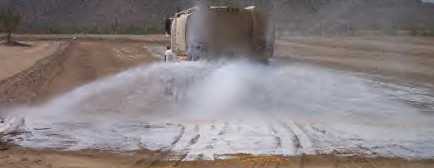
Environmental Products & Applications, Inc.
Manufacturer of Envirotac II Soil Stabilizer
73-710 Fred Waring Drive, Suite 220
Palm Desert, CA 92260
Phone: (888) 674-9174
Fax: (760) 779-1815
Mobile: (909) 908-3052
Email: Info@Envirotac.com
Website: www.envirotac.com
New Grasshopper MAS Mission: Anti-UAVs
IAF needs a two-seat manned observation & attack plane to patrol their border areas and be already in the air to hunt down and destroy terrorist UAVs. Recently a manned IAF aircraft shot down a Hezie-B UAV which could have had high explosives; FOX is showing aircraft video of the drone going down in flames.
foxnews.com/story/0,2933,207259,00.html
Monday, August 07, 2006Haifa, Israel's Third Largest City, Hit by Heaviest Hezbollah Attack Thus Far
BEIRUT, Lebanon
Israeli troops shot down an explosive-laden drone aircraft Monday, FOX News has learned, as Israel continued its assault on Hezbollah guerrillas along the southern border of Lebanon.
The drone, an Ababil, was shot down over the Mediterranean Sea near the port city of Haifa, the Israeli Defense Forces told FOX News. Officials believe it may have been headed for Tel Aviv. Ababils are Iranian-made aircraft that can be shot from a pneumatic launcher, according to Globalsecurity.org.
Israeli media said the unmanned aircraft had the capacity to carry 40 kilograms of explosives, nearly as much as the more powerful rockets Hezbollah has been firing into Israel for the last 27 days.
The drones have a guidance system, which allow them to be targeted more accurately than rockets.
The drone was shot down as three large explosions rattled Beirut, capping a day of intensified airstrikes and border raids on Hezbollah, including an Israeli commando offensive in Tyre to destroy guerrilla rocket launchers.
The Israeli army said it was the first time Israel had downed a Hezbollah drone, though it was the third time the militia had tried to send an unmanned vehicle into Israeli airspace since November 2004.
The first two drones were on reconnaissance missions. Israel's Channel 2 reported that this time it was an Iranian-made craft with explosives on board, apparently targeting an Israeli city.
The army could not confirm whether the drone carried a payload, and said its naval vessels had been sent to recover the wreckage.
In the first two sorties, before the current round of fighting, the drones, named "Mirsad 1" flew over Israel for some 20 minutes while filming.
World events have proven us correct, again: sub-national terrorist group Hezbollah has been shooting truck-mobile rockets to kill Israeli civilians from Lebanon. The IAF needs MANNED observation/attack planes (and so does the U.S. Army!) not bunches of noisy UAVs that lack any or much armament...the Vietnam war lesson of having O-1 Bird Dogs to spot and A-1 SkyRaiders with 2 tons of ordnance ready to strike enemy targets immediately is costing Israeli and American lives.
Where do you think mobile Theater Ballistic Missile and Cruise Missiles with weapons of mass destruction warheads targeting info will come from?
It can come from spies, being poorly located in obvious tent cities, but if we are smart on the ground and are dug-in and in camouflaged "Battle Boxes" the enemy will need to try air recon to get targeting info using UAVs. We need to be smart in the air, too and deny them UAV recon capability.
http://news.yahoo.com/news? tmpl=story&u=/nm/20050411/wl_nm/lebanon_israel_dc_3
Hizbollah Flies Drone Over Northern Israel
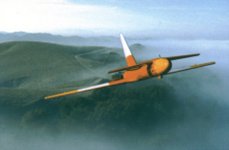
Mon Apr 11, 4:47 PM ET
World - Reuters
By Hussein Saad
TYRE, Lebanon (Reuters) - Lebanon's Hizbollah guerrillas flew an unmanned surveillance drone over northern Israel on Monday, the group and the Israeli army said.
"In response to repeated and continuous enemy violations of Lebanese airspace, the surveillance plane Mersad 1 carried out a reconnaissance mission in the skies of occupied northern Palestine, flying over several Zionist colonies," a Hizbollah statement said.
The flight at 5.15 p.m. (1015 EDT) flew as far south as Acre on the Israeli coast, the statement said.
Israeli security sources said the small aircraft flew for several minutes over Israeli territory and then returned to Lebanon before Israeli aircraft could intercept it.
"A short while ago, a UAV (unmanned aerial vehicle) flown by the Hizbollah terrorist organization flew over western Galilee in Israeli territory," an Israeli military spokeswoman said in Jerusalem.
Witnesses said Israeli warplanes broke the sound barrier over the southern Lebanese port city of Tyre and a nearby Palestinian refugee camp just after Hizbollah announced the flight.
The United Nations Interim Force in Lebanon (UNIFIL), which monitors the border between Israel and Lebanon, said it was checking the report. "There have been a few violations by drones and jets today," an UNIFIL spokesman said.
TENSIONS
A senior Israeli airforce official voiced concern that Hizbollah had sent the aircraft to escalate tensions along Israel's border with Lebanon while Syria was withdrawing its forces from Lebanon after U.S.-led pressure.
"It is an attempt to harass us and send a message that Hizbollah is still there," the official told Reuters.
"Hizbollah is aiming for massive disruptions ... Hizbollah understands that Syria's move away (from Lebanon) is a chance to shore up its agenda to fight (Israel)," he said.
The U.N. Security Council in September called on Hizbollah, backed by Syria and Iran, to disarm.
Hizbollah said in November it had flown a small reconnaissance drone into Israel for the first time in response to repeated Israeli violations of Lebanese airspace.
Hizbollah said the November flight had taken photos of Israeli towns and returned safely to base. But witnesses said they saw a drone crash into the sea.
The United Nations said in January it was gravely concerned about a flare-up of violence between the Jewish state and Hizbollah, which wants to drive Israeli forces from the disputed Shebaa Farms border area.
Syria, Lebanon and Hizbollah say the area is Lebanese. The United Nations says it is Syrian land.
Hizbollah was one of the main forces behind Israel's withdrawal from southern Lebanon in 2000.
strategypage.com/dls/articles/2004111220.asp
Iranian UAVs Over Israel
by James Dunnigan
November 12, 2004
Discussion Board on this DLS topic
The Lebanese based terrorist group Hizbollah took credit for a small UAV that came down Israelis Mediterranean coast on November 7th, flew over an Israeli town for 15 minutes and then flew back into Lebanon. Hizbollah called their UAV "Mirsad 1", but it was probably an Iranian Ababil. The Iranians have been developing UAVs for nearly a decade. Their Ababil is a 183 pound UAV with a ten foot wing span, a payload of about 80 pounds, a cruising speed of 290 kilometers an hour and an endurance of 90 minutes. The Ababil is known to operate as far as 120 kilometers from its ground controller. but it also has a guidance system that allows it to fly a pre-programmed route and then return to the control by its ground controllers for a landing (which is by parachute). The Ababil can carry a variety of day and night still and video cameras. There are many inexpensive and very capable cameras available on the open market, as is the equipment needed to transmit video and pictures back to the ground.
The Israeli air defense organization was embarrassed by this undetected UAV flight. In 1987, a Hizbollah commando flew undetected into northern Israel using an ultralight vehicle (somewhat larger than the Ababil), landed near a military camp, and killed six Soldiers before he was killed. This led to the air defense system in northern Israel being upgraded to prevent that sort of thing happening again. Since then, the Israelis have detected other ultralights and small aircraft trying to enter Israel, and have stopped them. But during the November 7th flight, the UAV moved at an altitude of under 300 feet, and was the smallest aircraft the Israelis have had to deal with so far. Nevertheless, the Israeli air defenses were apparently supposed to be capable of spotting something like an Ababil UAV.
What the Israelis fear most is low flying Ababils coming south carrying a load of nerve gas, or even just explosives. Using GPS guidance, such a UAV could hit targets very accurately. Moreover, there's nothing exotic about UAV technology, at least for something like the Ababil. It was no surprise that Iran began using home made UAVs in the late 1990s. After all, they had received some UAVs from the United States in the 1970s (Firebee target drones.) The Israelis immediately tagged Iran as the supplier of the Hizbollah drone, because Iran has long supplied that terrorist organization with cash, weapons and equipment for decades.
globalsecurity.org/military/world/iran/ababil.htm
Ababil (Swallow) Unmanned Air Vehicle [UAV]
Iran has been attempting to develop a UAV industry, and some of its UAVs were used operationally in 1997 to shadow U.S. Navy operations in the gulf. Iran has developed the tactical Ababil-5, a medium-range reconnaissance and surveillance UAV, the Ababil-T, a short/medium- range attack UAV, and the Ababil-B and -S. Iran recently announced the production of two new variants of its indigenously developed Ababil UAV, one of which, dubbed Ababil-S, was designed specifically for ISR operations.
The Ababil Unmanned Air Vehicle [UAV] is a canard configuration. Due to this fact the risk of stall and crash has been reduced by 30%. Accurate aerodynamic design has given it a good stability characteristics with high speed and maneuverability.
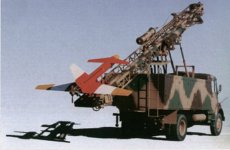
Ababil like many others does not need a runway to take off. Instead, it is launched by a pneumatic launcher. In comparison, this launcher is very reliable, safe and easy to use and maintenance. This is a stand a lone system that can be used many times in combat area. It is installed on a Benz-911 truck that also provides the power required to product air pressure for pneumatic system, the other necessary equipments such as Electric Generator and field maintenance tools are carried on the truck.
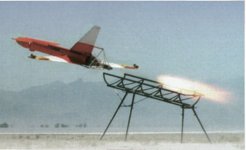
Ababil can be also launched by rockets. This method of launching is very simple. It provides the ability of launching the aircraft from a ship deck. This system consists of a three point attachment linkage, rockets, a trolley and its base and a detonator. The system is portable and can be easily assembled and disassembled.
Ababil is equipped with shahid noroozi guidance and control system designed and manufactured in Iran.It is composed of two aerial and ground section. The aircraft control is provided with an autopilot system that transfers flight information data to the ground station via a datalink system. The system is able to launch the aircraft, perform different maneuvers, fly to 30 km range, loiter and simulate air attacks and finally recover the aircraft at a given point. The range will be increased up to 120 Km simply by increasing the output power of the communication system.
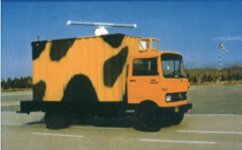
In ground station, the aircraft position and flight condition is displayed. Using these data, the pilot is able to guide and control the aircraft. The computer system shows the aircraft attitude, engine, speed, fuel consumption and emergency recovery signals. Using radar, the tracking and the reading angle to ground station all times during flight.
CCD TV camera I.R. Charge (Flare) Miss distance indicato re (M.D.I0) this is a system that works based on the acoustic measurement. The distance of the fired bullets from the aircraft geometric center and bullet motion path are measured by the system . This information is displayed in ground station, providing the training officer to correct the targeting operation until an appropriate level of accuracy is reached.

The parachute recovery system has been chosen so that the aircraft can be recovered in any condition. The parachute is designed and manufactured according to MIL-STD by Iran Aircraft Manufacturing Industries (HESA). It is a cross type parachute which provides a descent rate of 4 m/s. Using this parachute, the aircraft is recovered safely without any serious damage due to wind, the parachute is released immediately after it touches down. Using skids, also provides the possibility of conventional landing on a runway.
Specifications
wing span 325 cm
wing airfoil section NACA -4412
wing area 1.76mē
canard span 168.8 cm
canard area 0.35 mē
canard airfoil section NACA-4412
vertical fin NACA-0012
Length overall 288 cm
Height overall 90.88 cm
Body diameter 25 cm
propeller Diameter 61 cm
Max. launching weight 83 kg
Max. payload weight 40 kg
Launching speed 64 Knots
Cruise speed 165 Knots
For longer than 5 km range a tracking system is essential.
Endurance is 1.5 h (Can be increased)
Engine Type WAE-342
No. of cylinder 2 cylander
Engine volume 342 cc
Max .power 25 hp
Max .R.P.M(with propeller installed)
7000-7500
Weight 8.5 kg
Fuel type Mixture of oil+Benzene
ceiling 8000-10000 ft
Max. Thrust 65-70 lb
Fuel tank capacity 17 lit
Vanckle Engin e p 73 rotary engine
Engine volume 208 cc chamber size
Max.power 30 hp
Max.RPM* 8000-8500 R.P.M
Weight 10 kg
Fuel type Mixture of oil+Benzene
Ceiling 15000-17000 ft
Max. Thrust 75-80 lb
Observation/Attack Fixed-Wing STOL Grasshopper Landing Gear: Need no Rubber, Need No Road
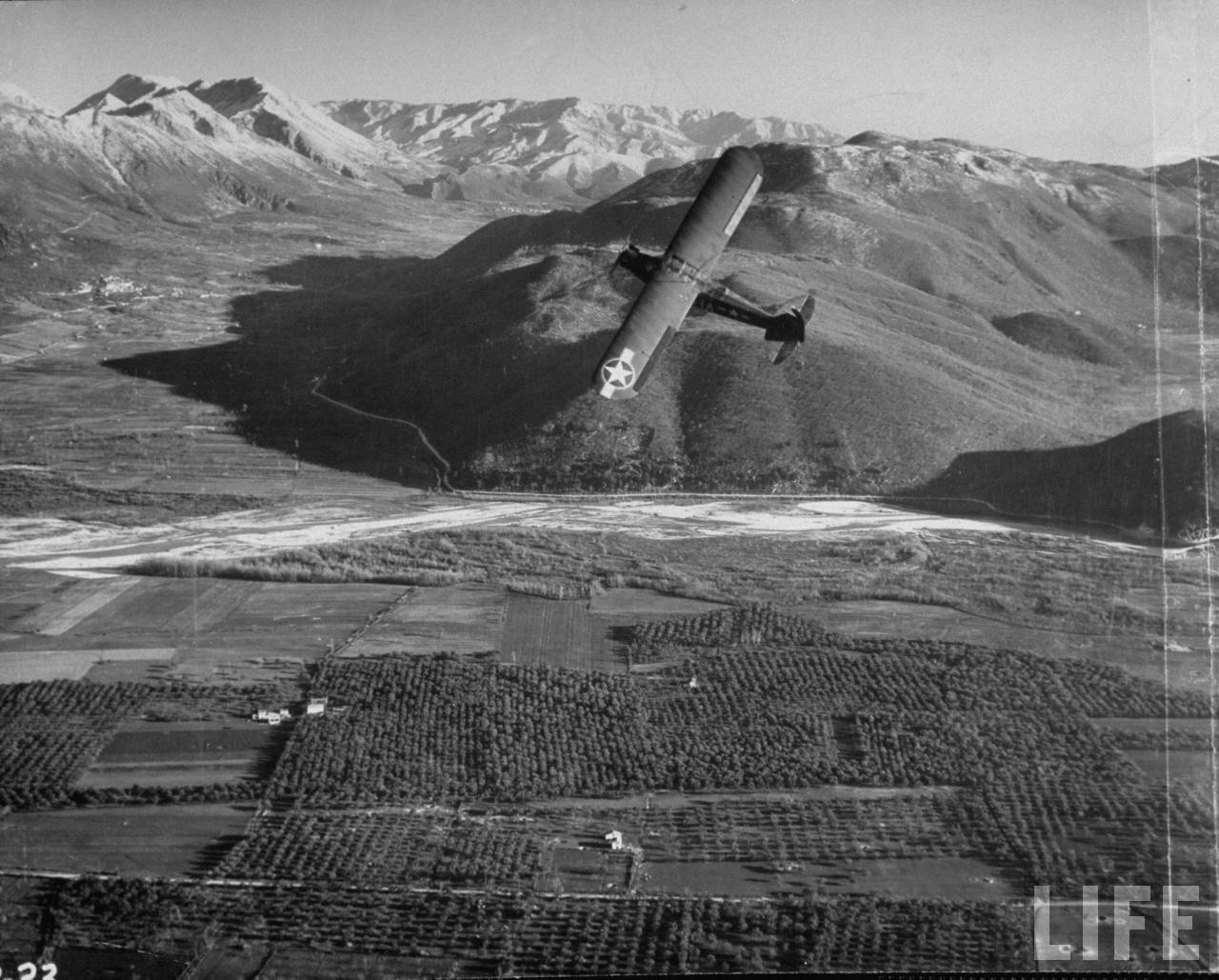
If we are examining small "Killer Bee" fixed-wing short take-off and landing (STOL) aircraft's ability to land anywhere to first win The Battle Against the Earth (TBATE); their aerodynamics can get us into a football sized-300 foot long flat area but its where the aircraft touches down that the problems occur and the handicaps of high ground pressure rubber tires begin to reverse-engineer where we can and cannot land and take-off from into fewer and fewer options due to the "unknown" of what the ground below actually looks like. Yes, we can and should drop USAF CCTs and even Army Pathfinders by parachute to rapidly survey potential assault landing zones but this is working around a technical weakness in our equipment that should be instead corrected to give us greater flexibility and unpredictability on the non-linear battlefield (NLB) where the enemy is all around and expecting on us to be linear and predictable depending on roads/trails, obvious areas to operate from. Small Killer Bees with small payload capabilities cannot afford to have elaborate landing gear like air cushions unless they were designed from the beginning to have them. Small Killer Bees could be carried inside larger STOL transports like the C-27J Spartan and C-130 Hercules who could have ACLS to get them to an uneven dirt road or grassy cow pasture field, but they will have to operate from them on their own thereafter.
Small Tracks on Small Aircraft
The good news is that their smallness and lightness can enable them to achieve land-anywhere with minimalist means that might be too much for very heavy aircraft. One of these options is tracked landing gear which if mated to a non-STOL aircraft that cannot slow down to under 100 mph landing speeds might over-tax the track's maximum spin rate. We know tracked landing gear can dramatically improve non-STOL aircraft landing location choices to include unimproved dirt areas but to get them to retract into the aircraft means extensive and costly re-design so the USAF hasn't followed up on the concept. A Killer Bee Observation/Attack (O/A) STOL aircraft often doesn't even have retractable landing gear and the drag penalty is only a little more than exposed wheels and a whole lot less than floats. Below is a picture of Mattracks on a Cessna 152:
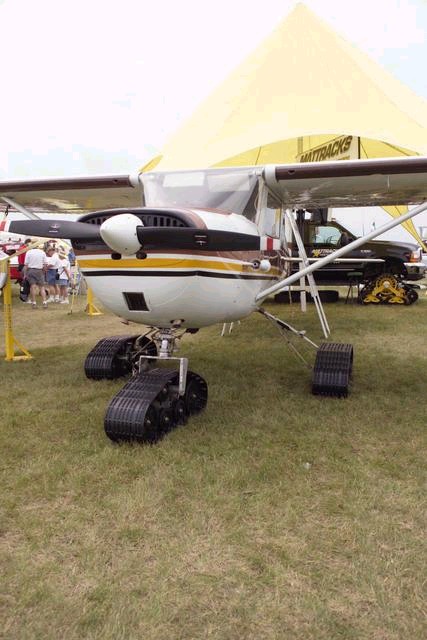
Small Skis on Small Aircraft: Land on Water, Anyone?
At one time, the U.S. Army had fine-tuned its combat-earned, STOL Grasshopper expertise in the late 1950s with the O-1 (L-19) Bird Dog and the fabulous OV-1 Mohawk by examining wheel/ski combinations called the "Universal Landing Gear" (ULG).

Essentially, a mini-version of the Strouk "Pantobase" skis but for small aircraft. The following critique on the ULG comes from a Cessna aircraft historian/author. Correct me if I'm wrong, but if you don't have floats for your Bird Dogs, STFU and buy the ULG and get a capability at less drag, right?
cessnawarbirds.blogspot.com/2007/06/bird-dog-on-floatsor-are-they-skis.html
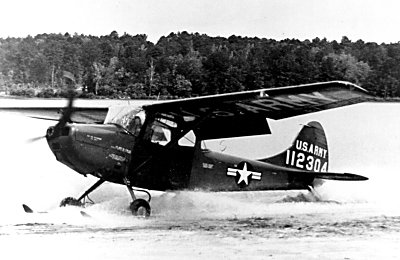
Universal Landing Gear undergoing on-water tests on Lake Tholocco, Fort Rucker, AL, in 1956
(U.S. Army Aviation Museum photo)Cessna and the U.S. Army completed a lot of flight tests with Bird Dogs on a variety of floats, including an interesting configuration called the Universal Landing Gear. Here's the story, extracted from my book Cessna Warbirds, Chapter 7:
In 1957, the Army tested the Universal Landing Gear (ULG) -- manufactured by the All-American Engineering Company -- a set of skis that mounted around the Bird Dog's main wheels allowing the wheels to protrude slightly. In 111 hours of flight tests on two L-19s between 23 March 1956 and 11 January 1957, the ULG was tried out on snow, sod, water, sand, mud, plowed fields, and standard runways for a total of 450 landings.
Flight characteristics were virtually unchanged from the normal Bird Dog, and maintenance and installation and removal posed no problems.
However, only on sand was the ULG considered acceptable.
On snow, skis were better.
On mud, performance was unacceptable.
The ULG performed well on water landings but required a special beaching area unnecessary with normal floats.
The previously tested tandem main landing gear was better suited to use on freshly plowed fields.
The Army's final report noted other problems such as "adjustability of the ski assembly, lack of interchangeability with other L-19 airplanes, plowing effect of the ski-bow in soft ground and snow, accumulation of mud on top of the ski, excessive tailwheel drag, and inadequate handbook of instructions." They recommended continued use of the Whittaker Tandem Landing Gear for plowed field and mud operations and the Federal snow ski for snow landings.
Not so fast.
What about the floats for landing in water for Bird Dogs? I have yet to see evidence that the Army operated Bird Dogs with floats like it did in WW2 with L-4 Piper Cubs:
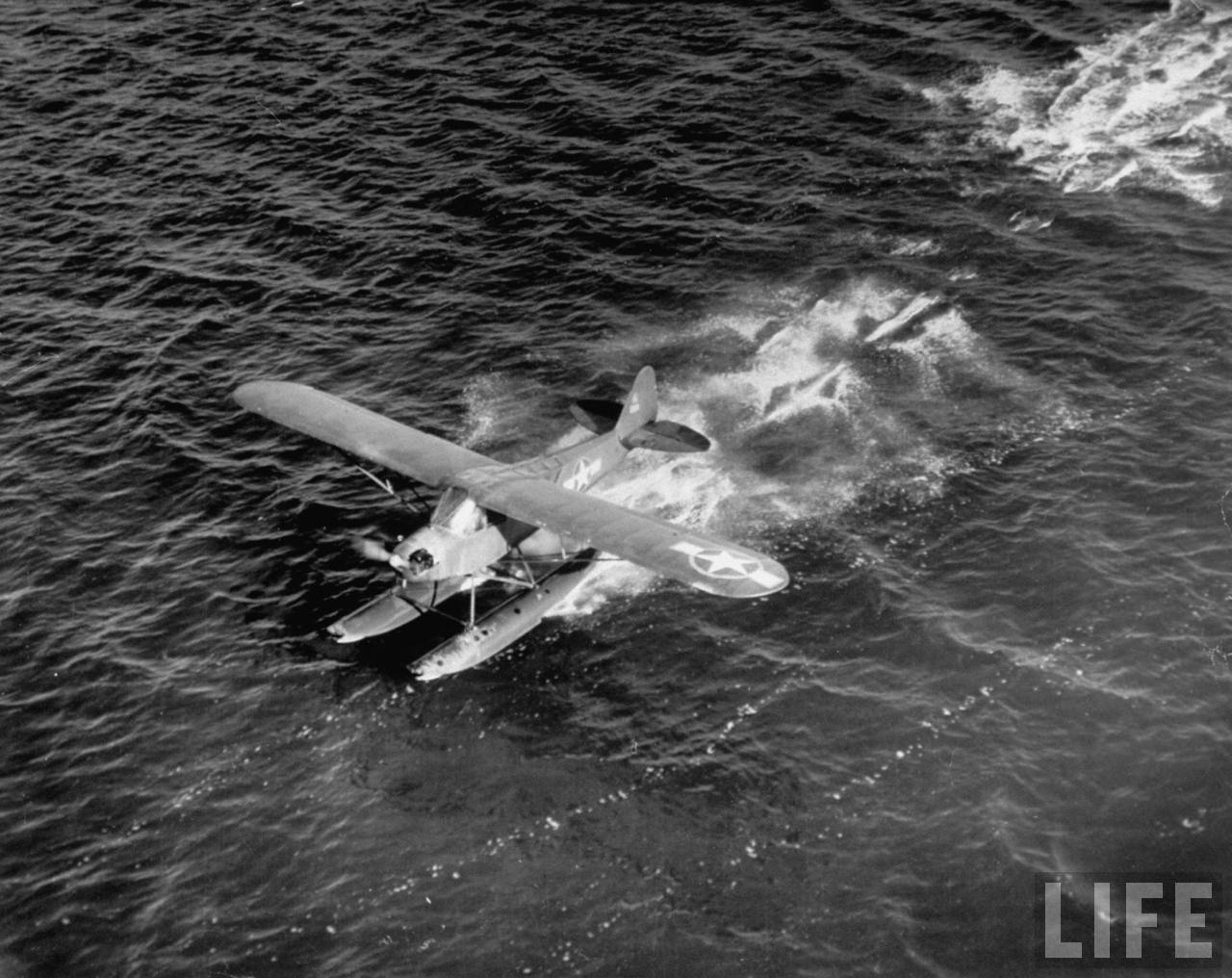
And what if you don't want to pay the aerodynamic drag speed loss penalty for floats and want an ability to land in the water, stay moving and taxi up onto land? The Army's rejection here of the ULG seems very short-sighted. A Bird Dog with ULGs would be better on all terrains especially if a TANDEM WHEEL ULG could be developed where the mini-ski is raised when landing in muddy conditions.
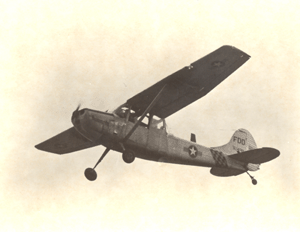
Big fans of STOL Grasshoppers were LTC John Paul Vann who saved many lives flying in ammo to surrounded troops in Korea and flew as a commander in them in Vietnam, General Matthew Ridgway who landed all over Korea in a L-19 (O-1) Bird Dog like during the Munsan-Ni combat jump of the 187th ABCT of the 11th Airborne Division in 1951:
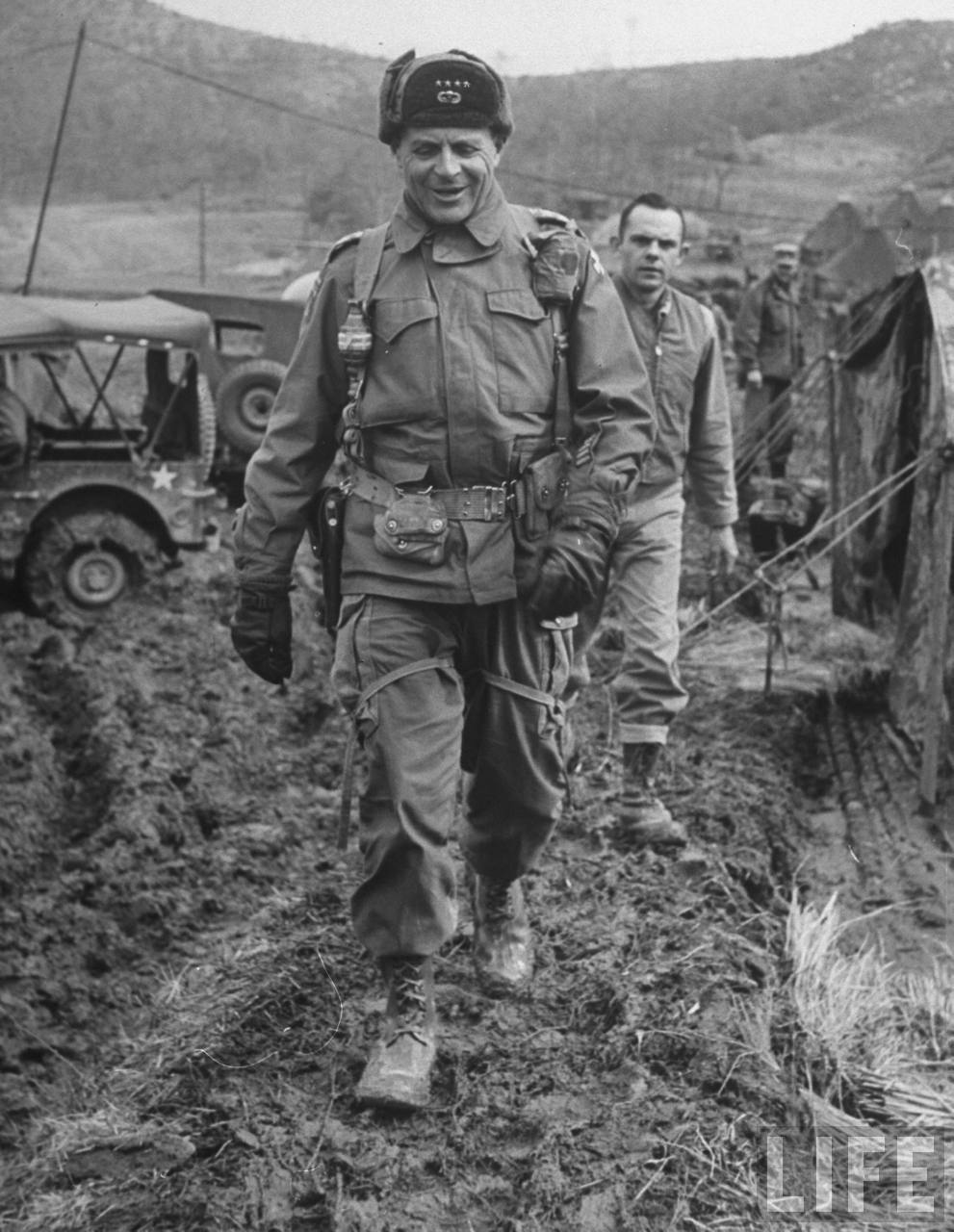
And General James Gavin who had a formation of Bird Dogs fly by at his retirement ceremony in 1958:
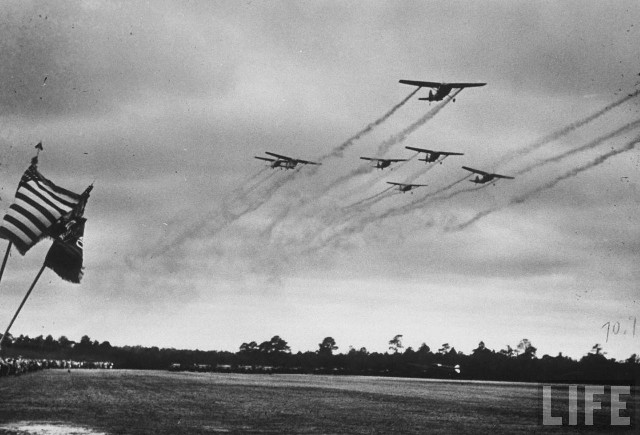
OK, where's the Tandem Wheel Landing Gear?
Credit for the entire STOL liaison concept has to again go to the GERMANS who in the 1930s came up with the Storch by WW1 combat pilot Fieseler; an amazing plane that could land in just 50 feet! It was also the inidividual initiative of a young Army LT McCord Watson Jr. who in 1940 used his own personal funds to buy our first American STOL aircraft.
And it so happens as the Germans fought all over the world during WW2, they encountered the same landing site selection problems described above and tried both tracked landing gear (I have no picture of this yet) and lo! and behold! the "tandem wheel" landing gear the Army STOL community endorsed made by Whittaker.

This brings up the next question. Where the hell are the Bird Dogs with the tandem wheel landing gear?
We have a pic of a Bird Dog in Korea with super humongous fat-tires from Korea, but no tandem wheel gear.
Here's a pic of the Whittaker tandem-wheel landing gear on a Piper Cub:
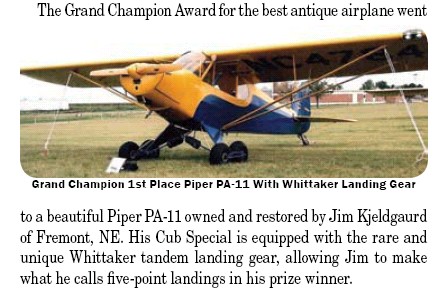
Summary/Conclusion
It seems apparent that what the U.S. Army needs is a 250+ mph AU Grasshopper STOL plane that is diesel, piston-engined with muffled sound and heat signatures spinning a multiple-bladed prop painted in low-visibility "Heater" sky camouflage armed with 2.75" rocket pods and a 30mm autocannon in the belly slaved to the pilot and observer's helmet sights and LCD screen image intensifier and thermal infared sensors with a millimeter wave radar. It could be viewed as a "Class 4 UAV" in current Army parlance by being unmanned if need be by remote flight electronics, making it an unmanned/manned combat air vehicle (U/MCAV). A modern Bird Dog with human sensors in addition to (+) electronic ones would do a far better job than an unmanned UAV like the Predator UAV at finding and marking the enemy and be in the air far more than unaffordable medium-to-large complex helicopters. With the best landing gear possible to defeat TBATE, it would land nearly anywhere making the VTOL capabilities of the helicopter moot point and rendering the Rommel/Patton/Ridgway/Gavin commander liaison that wins battles and wars possible without making the Army go broke. The "L" word here would also mean resupplying our troops with ammunition, food and water and medevacing out wounded Soldiers with a stealthy, high-speed means that will not get grounded if enemy air defenses get too threatening as the 3rd ID (M) found itself without helo support after the ill-fated 11th Attack Aviation Brigade got shot up.
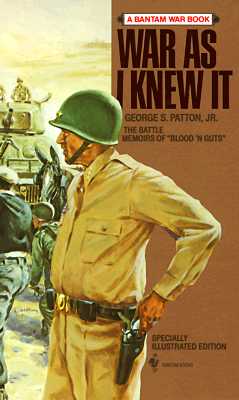
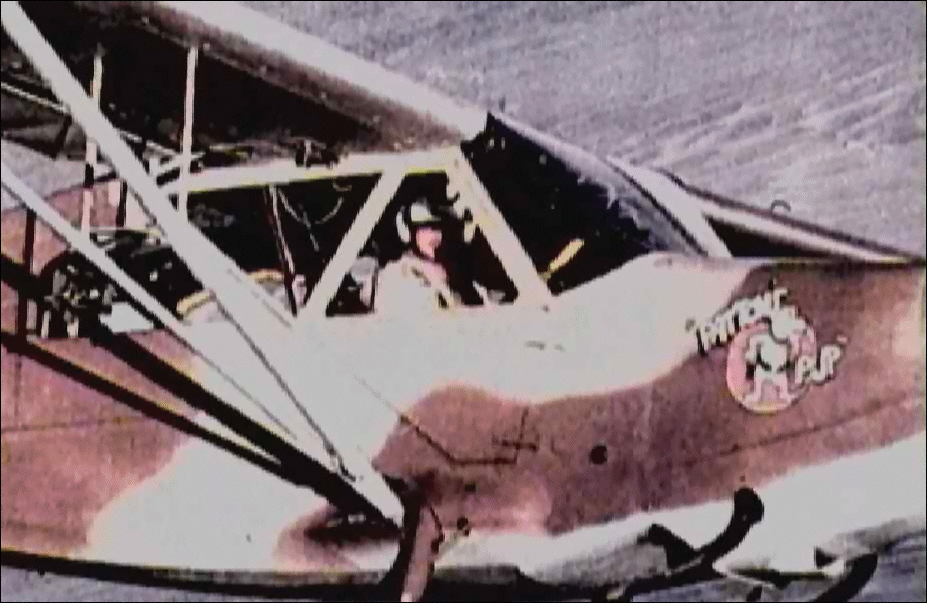

Patton Flew Grasshoppers at Fort Irwin, California!
http://skytrail.info/new/history.htm
All manner of airplanes were used, particularly L-1 and L-4 Piper Cubs for surveillance. Patton himself used his own private plane, a Stinson Voyager, or "flying jeep" as the planes were also known. C-50 cargo planes were used in several instances, including for troop supply during maneuvers. Supplies, including ammunition, were parachuted to waiting troops by the C-50s, with mixed results. Light bomber-ground attack A-20 Havocs were stationed at Blythe Army Air Field, as well as at Camp Essex P-40 Warhawks and P-38 Lightnings are also known to have been used at the DTC/C-AMA, as were B-24 Liberators (Figure 28).There were four main army airfields in the DTC/C-AMA: Rice, Shaver's Summit, Desert Center, and Thermal. In many other locations, the army used existing civilian facilities, such as the airport in Boulder City, Nevada. In other cases, the army established facilities that were subsequently taken over for civilian use after the end of the war. For example, an airfield built in Palm Springs by the Army became the city's municipal airport after the war (Weight 1977).
In addition to the more permanent airfields, landing strips were created throughout the facility. Douglas A20 "Havoc" bombersIn most cases, these temporary strips were prepared by clearing vegetation and compacting the sand with water. Usually measuring 1,000 feet long and 100 feet wide, the strips were built in the direction of the prevailing winds and could generally accommodate only small surveillance airplanes (U.S. Army Air Corps 1942 :G1). One of the more visible makeshift airfields was adjacent to Essex Divisional Camp. This field, unlike the other temporary strips, was designed to handle aircraft as large as A-20 s. The flying surface was 4,500 feet long and 111 feet wide, and consisted of a light bar-and-rod steel landing mat. Shoulders measuring 120 feet wide were constructed with compacted sand, and the taxiways and warm-up ramps were made of soil cement and desert mix. The area was graded and was watered down with commercial trucks, which received water from the Santa Fe Railroad well at Fenner (U .S. Army Air Corps 1942 :G1-4C-4).
At the height of DTC/C-AMA operations, when total personnel reached 190,000, only 4,000 of these troops were from the Army Air Forces. Beginning on December 1, 1943, all air units and installations in the DTC/C-AMA were taken over by the commanding general of the Army Air Forces. The III Tactical Air Division, which had been overseeing the air operations, came under the control of the Third Air Force. From the AGF's perspective, this was not a welcome change. The Army felt that the headquarters of the DTC/C-AMA must command the entire facility, including all air activities; if not, a great deal of realism would be lost. According to some, air support became almost non-existent by 1944 (Meller 1946:43).
By August 1944, after the DTC/C-AMA closure, most of the airfields were assigned to March Field as subbases, and the number of personnel stationed at them decreased (U.S. Air Force Historical Division n.d.b :1-2).
In fact, during WW2, General Patton considered pooling all his STOL Grasshoppers together to carry across a pair of Soldiers at a time per plane to get across the Rhine river when the 1st Allied Airborne Army troops were assigned to Montgomery's Operation MARKET-GARDEN gamble which fell short. He said in War as I Knew it, page 252:
"In any event, we determined to cross the Rhine on the night of the 22nd with the 5th Infantry Division. I gave a plan to [Gen] Eddy, which might have been quite picturesque, of using some 200 L-4 [Piper Cub] planes to carry 1 rifleman per plane across the river. By the use of these planes we could have taken 200 men across every 30 minutes. The idea was that of Brigadier General E.T. Williams, Chief Artillery Officer of the Army, and an extremely good one. "*His editor added:
* The assembled Cub planes were nicknamed "The Third Army Troop Carrier Command". In view of the situation, General Patton's idea was to get as many men as possible across the Rhine [river] in the shortest possible time. At this particular time, he believed the strength was in the greatest numbers.
The Rhodesian Fire Forces used Cessna O/A planes to great effect and their CONcept of OPerations (CONOPS) should be studied...emulated and improved on.
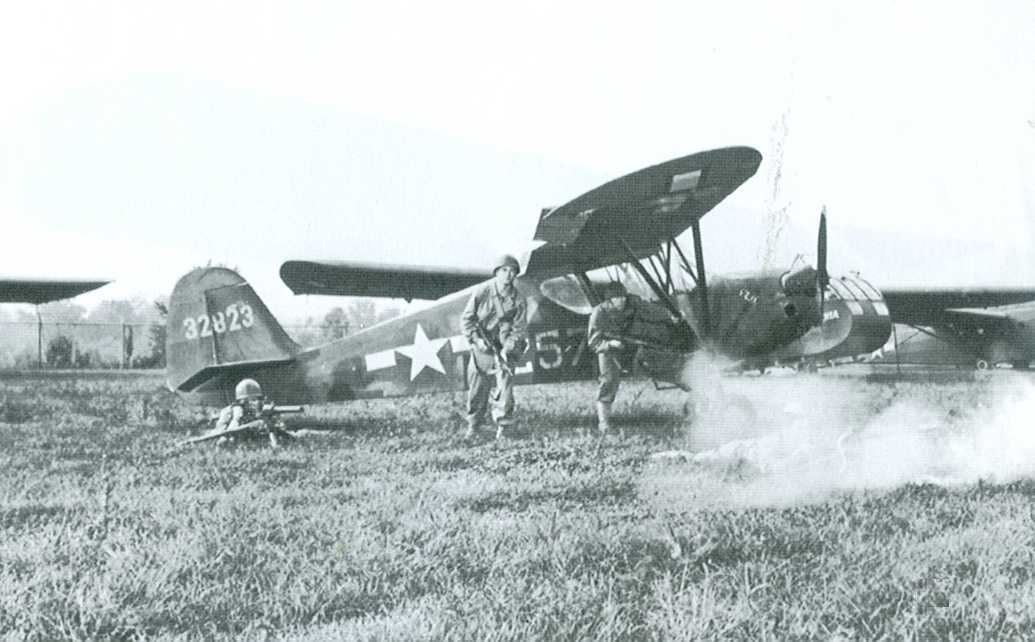
The 1942 U.S. Army ARMORED FORCE Field Manual reminds us that at one time every armored division had its own squadron of Grasshopper L-series O/A aircraft...we need to be as capable today.
combatreform.org/FM_17_10_Armored_Force_Field_Manual_Tactics_and_Tech1942.pdf
FM 17-18 ARMORED FORCE FIELD MANUAL
17. AVIATION.-a. The role of aviation attached to or operating in support of armored force units, its characteristics, and tactical and technical employment are given in FM 1-5, 1-20, and 100-5.
b. Corps headquarters contain an aviation section that acts in an advisory and technical capacity for the corps commander and coordinates operations of attached or supporting observation and combat aviation.
c. (1) An observation squadron is attached to the armored division. It is equipped both with airplanes of high speed and sufficient range to reconnoiter the area essential to armored operations and with airplanes capable of operation from advanced landing fields.
(2) Observation aviation performs distant and battle reconnaissance (including artillery adjustment), liaison, command, and photographic missions.
Page 11
d. Combat aviation is made available by GHQ. It is employed against targets which cannot be engaged effectively by available ground weapons within the time required and supplements or extends the range of available artillery. Its chief missions in support of large armored force units are:
(1) Neutralization of hostile aviation.
(2) Neutralization of enemy artillery.
(3) Neutralization of hostile defensive installations, including antitank.
(4) Direct support of the attack.
(5) Neutralization of counterattacks, especially of armored units.
(6) Destruction, harassing, or delaying of hostile concentrations, reinforcing, pursuing, or retreating forces, and rear installations and centers of communication.
e. Transport aviation will be furnished by GHQ for the supply of elements of armored units when operating beyond the sources of normal supply or when no land communications are available.
1. Either parachute troops or air-borne troops may be employed in conjunction with the operations of armored units to secure terrain objectives on the routes of march or to seize vital points in rear of the hostile front. They may establish support groups and supply bases for a break-through.
USAF Civil Air Patrol: Time to Use Them for Border security?
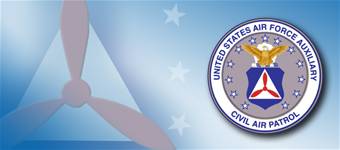
One group that still has O-1 Bird Dogs is the USAF auxiliary, the Civil Air Patrol (CAP). Since the active duty U.S. Army is not interested in protecting America at its borders (its job), perhaps the CAP could be placed on active duty once a year in a rotation to get a 24/7/365 air surveillance presence over America's southwest borders. It might be a good time to supply the CAP with some new observation aircraft like a new manufacture STOL Bird Dog.
RECOMMENDED READING
Airpower in Small Wars: Fighting Insurgents and Terrorists (Modern War Studies)
by James S. Corum, Wray R. Johnson
airpower.maxwell.af.mil/airchronicles/apj/apj05/spr05/vorspr05.html
The USAF Air Power Chronicles Vortices article below broadly outlines a doctrine of unconventional airpower for these missions and recommends modifications in force structure and tactics that will help execute that doctrine successfully on the battlefield. Specifically, the recommendations include development of a new aircraft for CT and COIN.
|
DISTRIBUTION A:
Document created: 1 March 05
|
| ||||||||||
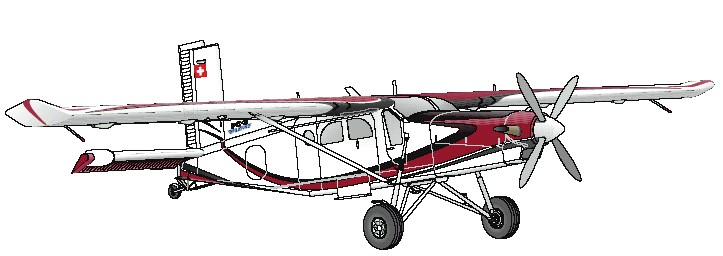
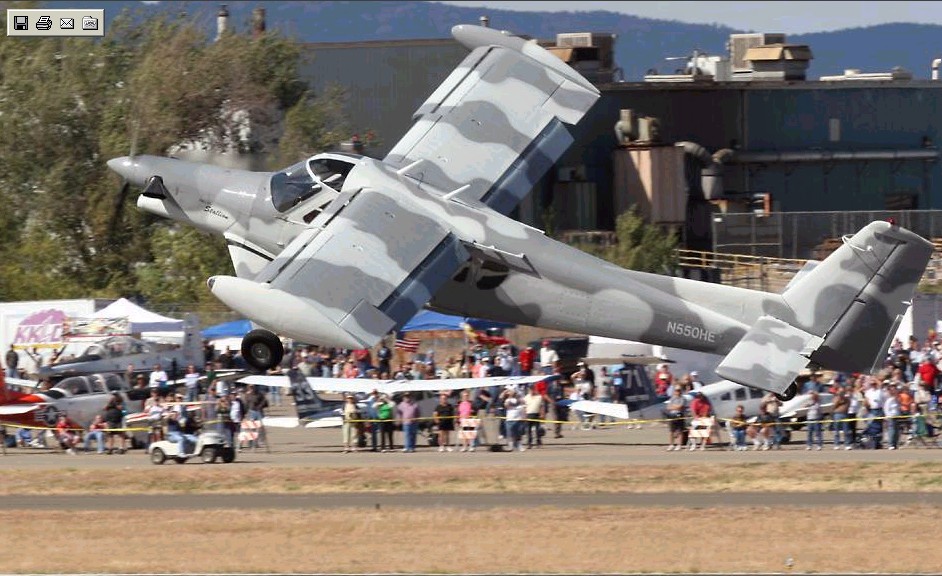
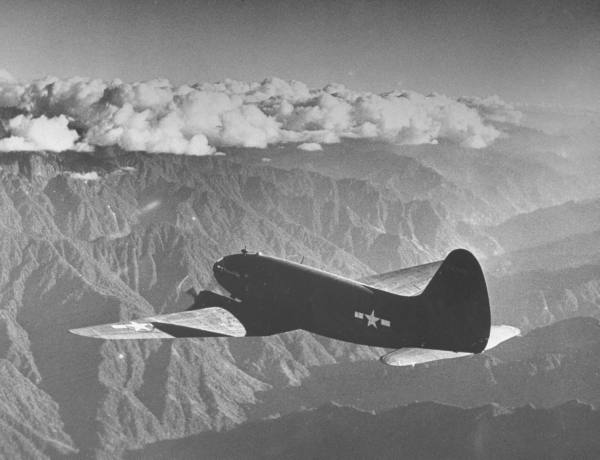
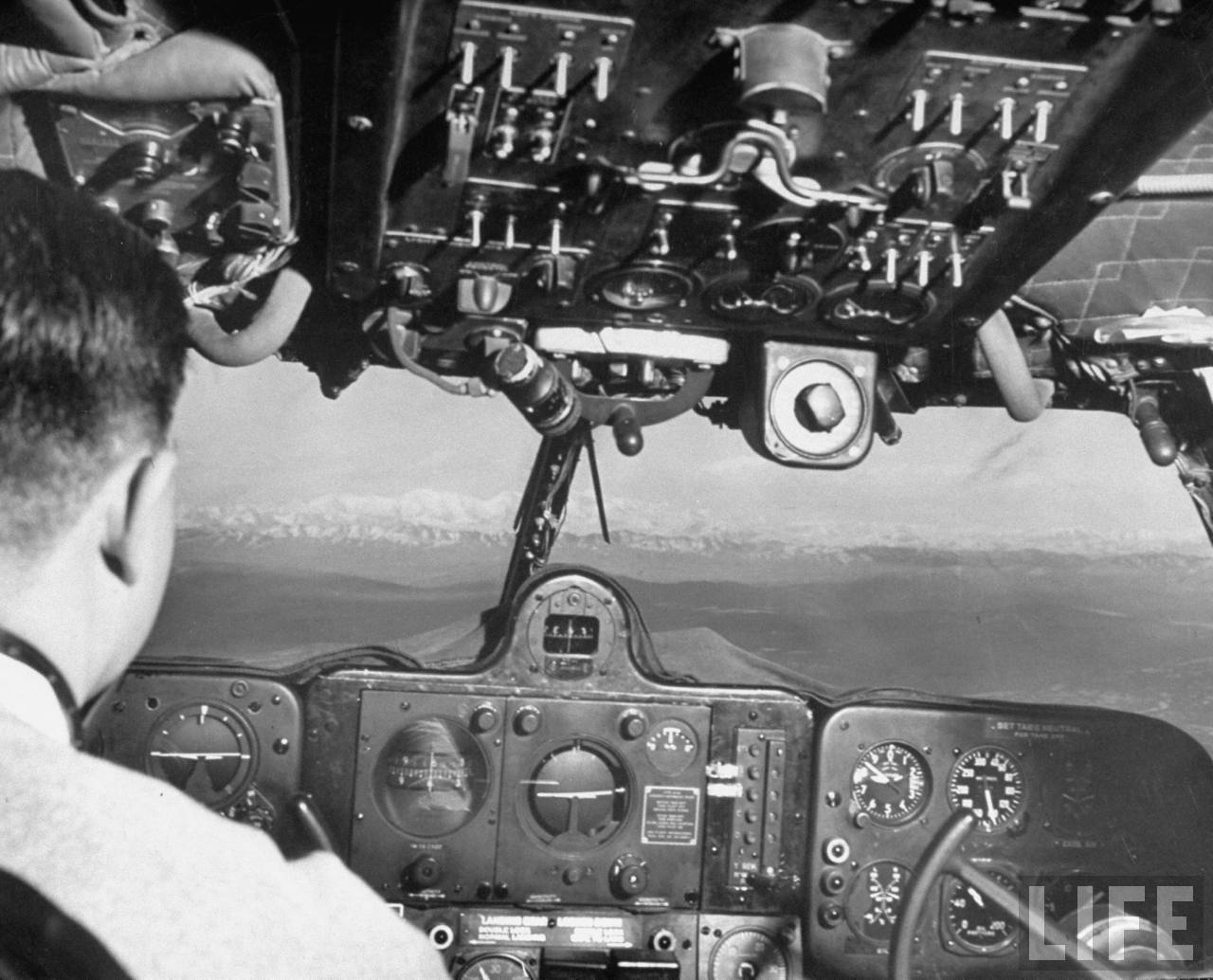
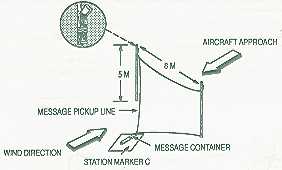
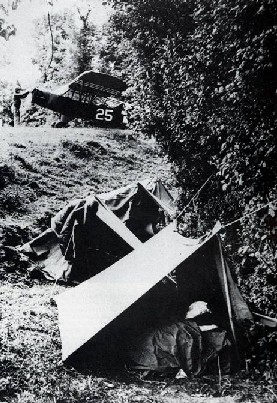
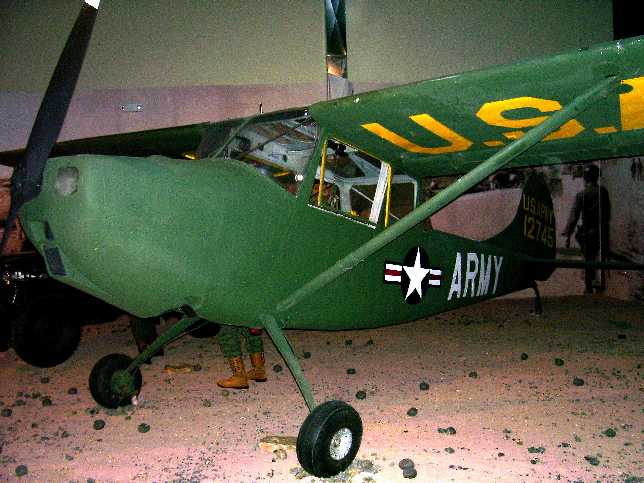
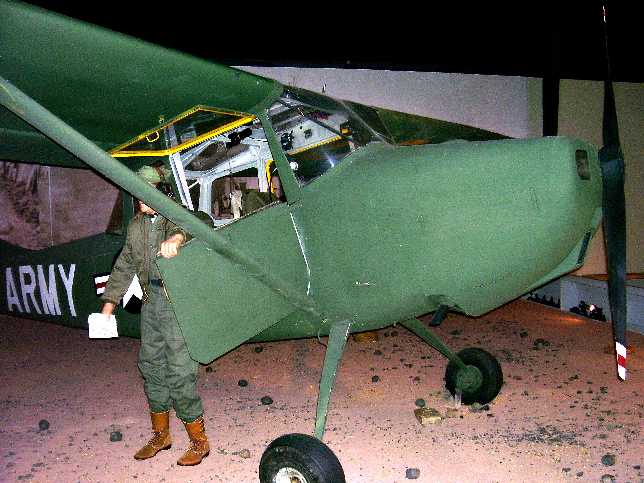
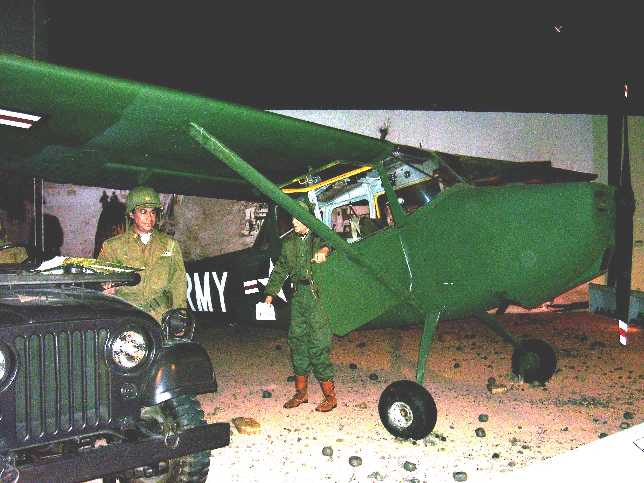
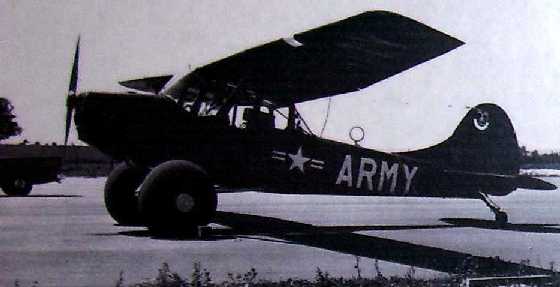
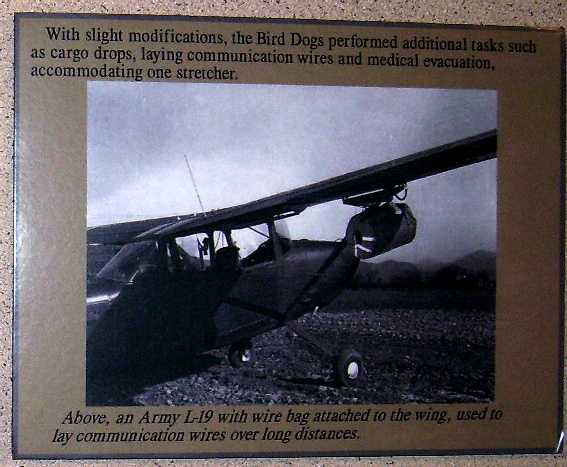
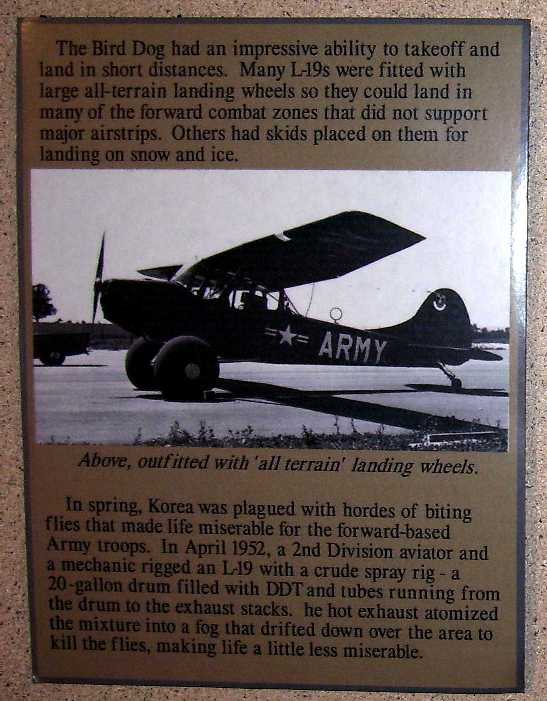


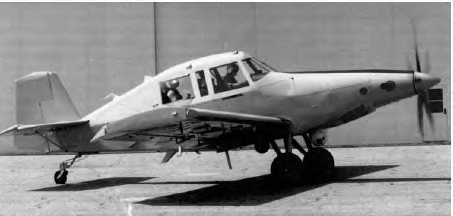
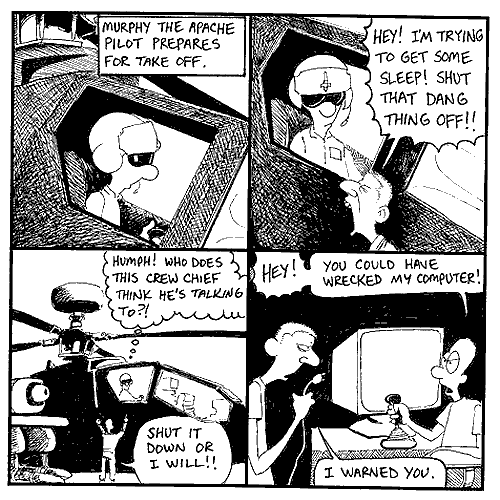
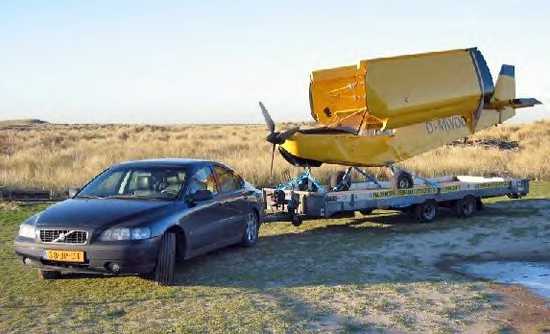
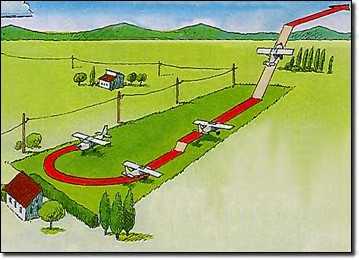
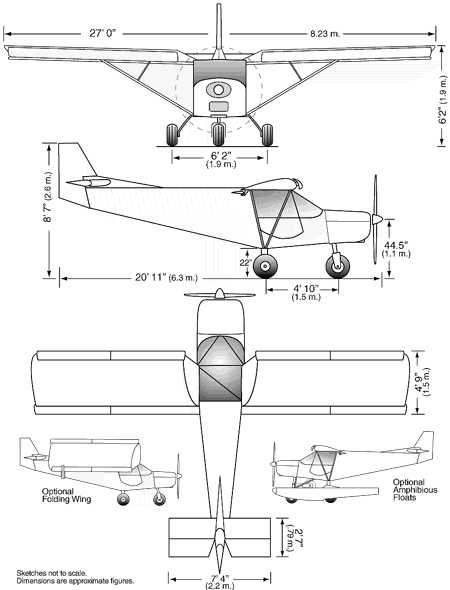
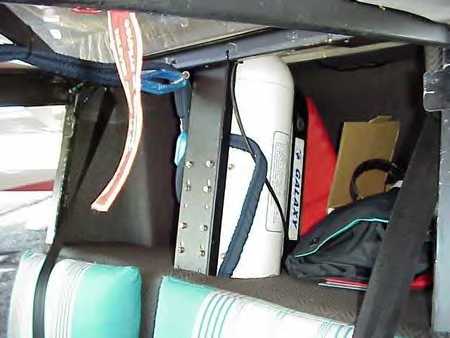

 Return to U.S. Army Airborne Equipment Shop
Return to U.S. Army Airborne Equipment Shop